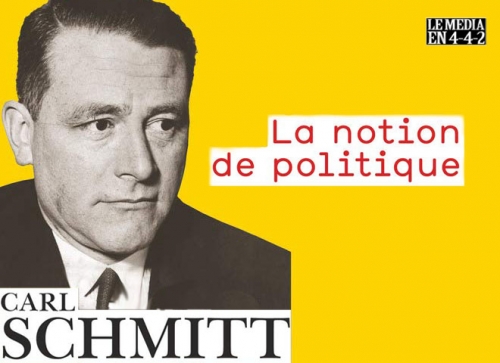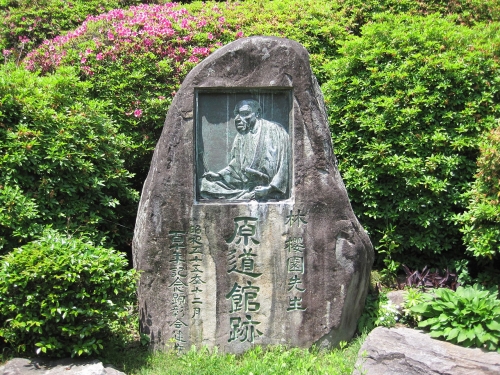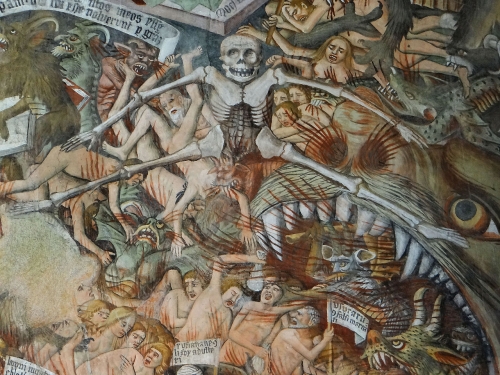jeudi, 21 janvier 2021
De l’Ame
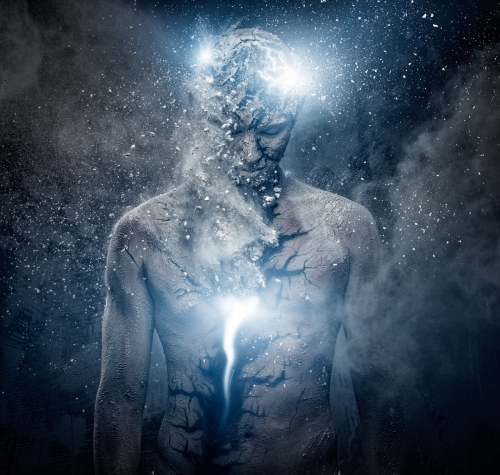
De l’Ame
par Luc-Olivier d'Algange
Il n'est rien de moins abstrait que l'âme. Lorsque presque tout en ce monde, selon le mot de Guy Debord, tend à « s'éloigner dans une représentation », à s'abstraire de sa propre immédiateté; lorsque notre entendement, dans son usage commun, se borne à n'être qu'une machine à abstraire (ce qu'il est peut-être par nature, sauf à se subvertir lui-même dans une conversion gnostique); lorsque notre corps, tel que nous nous le représentons dans le regard d'autrui est tout autant abstrait de lui-même, - l'âme seule, qui est intérieure à toutes les choses, s'y déploie, pour qu'elles soient là, qu'elle existent, et dans leur mouvement même.
Qu'importe de savoir si nous croyons ou non en l'existence de l'âme, comme en une chose ou une notion, puisque ce qui existe, en s'éprouvant, est le mouvement de l'âme elle-même.
Pas davantage qu'une abstraction, l'âme n'est une « subjectivité »; elle n'est point la somme ou la synthèse de nos représentations et il serait presque trop de dire qu'elle est en nous, - cet « en nous » invitant à l'erreur de croire que notre âme serait emprisonnée dans notre corps, comme un moteur l'est dans une machine.
Or la nature de l'âme est d'être impondérable et de franchir, légère, les limites et les frontières. Elle n'est pas seulement un bien intériorisé mais la circulation entre l'intérieur et l'extérieur, la fluidité même.
Notre peau n'est pas notre limite, ainsi que l’écrivais René Daumal, mais l'un des plus subtils organes de perception. Ce qui perçoit avant nous en fissions une représentation, c'est l'âme. « Peau d'âme » disait Catherine Pozzi. La formule est admirable de justesse. L'âme ne s'oppose pas au sensible comme le voudraient les morales puritaines; elle est ce qui le rend possible. Là où l'âme agit, le monde intérieur et le monde extérieur échangent leurs puissances et s'entre-pénètrent amoureusement.
Que serait un monde sans âme ? Celui où nous avons la disgrâce ou la chance terrible de vivre. La disgrâce; parce que le monde moderne, le monde des hommes uniformisés et des objets de série, est cette machine à fabriquer de l'interchangeable et que la Grâce, comme le savait Al-Hallaj, ne vient qu'aux uniques. Mais chance terrible aussi, car la mise-en-péril de l'essentiel en révèle la splendeur cachée, l'inaltérable beauté sise au cœur des êtres et des choses.

L'âme humaine et l'Ame du monde sont une seule âme. L'âme des paysages est âme car elle est notre âme. Celui qui perçoit l'âme d'un paysage a la sensation de s'y perdre, à cet instant où, l'air, le ciel, les arbres et le vent affluant en lui, il vacille au bord de l'extase. Il fait plus, et mieux, que le voir. Ce qu'il voit n'est que le signe de l'âme qui regarde en lui.
Telle prairie dans son apothéose fleurie éveille en nous le printemps de l'âme. Tel océan nous rappelle à l'exigence de nos abîmes. Tel vol d'hirondelles est notre pensée même et ne se distingue en rien de ce qui la perçoit en nous. L'âme est la vive, l'avivante intersection entre ce qui perçoit et ce qui est perçu.
Le sentiment qui en surgit est bien, comme vous le dites justement, celui du Pays perdu, la sehnsucht des Romantiques Allemands, - l'orée tremblante de l'âme.
A certaines heures, particulièrement à l'aube et au crépuscule, le visible semble s'éloigner en lui-même, dans la profondeur du regard, jusqu'à l'orée d'où reviennent, en ressacs, les ressouvenirs du Pays perdu. Ce pays n'est perdu, en vérité, que parce qu'il est trouvé. Son absence est l'espace de son advenue.
Quiconque oublie le sens de l'exil vit dans l'exil de l'exil, - dans cette absence carcérale qu'est la représentation. La présence réelle, au contraire, est l'hôte de l'absence, son invitation, et selon la formule fameuse de Dante, sa « salutation angélique ». A l'orée du visible, l'absence du visible, l'invisible nous fait signe afin que nous cheminions vers lui. Toute vie qui n'est pas une quête du Graal est un avilissement sans fin.

Dans le fondamentalisme, tout se réduit à l'idolâtrie du signe extérieur, d'une apparence qui ne laisse rien apparaître. Apparence sans apparition, mur aveugle, sur lequel, tout au plus, on peut apposer des affiches de propagande haineuse. Le fondamentaliste veut bannir le doute, mais bannissant le doute, il détruit la Foi. A sa façon, c'est un « réaliste », il veut « du concret », c'est-à-dire de la servitude et de la mort concrètement réalisés. Il est aux antipodes, non du matérialiste ou du « mécréant », comme il se plait à le dire, et peut-être à le croire, mais du mystique et de l'herméneute, et de tout homme en qui s'élève un chant de louange en l'honneur de la Création.
Vindicatif, mesquin, obtus, il vient comme une menace, mais dans un monde qui lui ressemble. On le dit « archaïque » ou « barbare » mais il n'est ni l'un ni l'autre, - plutôt idéologue et publiciste, inscrit, et parmi les premiers rôles, au cœur de la société du spectacle. Il n'est pas ce qui s'oppose au monde moderne mais sa vérité de moins en moins dissimulée. Comment lui opposerait-on la société dite moderne dominée par la finance et la technique alors que ce sont les moteurs de sa guerre, que bien abusivement, il qualifie de « sainte » ?
La guerre de ces deux forces, antagonistes seulement par les apparences, car elles sont l'une et l'autre idolâtres des apparences, ne contient aucun espoir. Elle est la force même du péché contre l'espérance. Ce qu'il y eut de beau, de noble et libre dans la culture européenne est pris en tenaille entre ces frères ennemis qui obéissent au même Maître, - celui de la restriction de l'expérience sensible et spirituelle, celui du contrôle total.
En ces circonstances où le monde s'uniformise et s'attriste, l'âme est atteinte, blessée. Les poètes en seront les guérisseurs, au sens chamanique, et les héros, au sens d'une sauvegarde de certaines possibilités d'être. La question est cruciale et vitale car enfin, sans âme, tout simplement, on ne vit point, ou bien seulement d'une vie réduite à un processus biologique, - auquel s'intéresse précisément le « trans-humanisme », qui est sans doute la phase ultime de cet « interventionnisme » moderne qui veut ôter aux hommes la joie et le tragique, et la beauté même de l'instant éternel, pour en faire des mécaniques perpétuelles.

Le Moderne hait le donné. Rien n'est assez bon pour lui; et c'est ainsi qu'il détruit le monde et s'appareille. Les causes et les conséquences de ce processus, qui est avant tout une vengeance contre tout ce que l'on ne sait pas aimer, ont, au demeurant, été admirablement analysés par Heidegger et René Guénon. Le Moderne est un homme mécontent du monde et de lui-même et ce mécontentement, au contraire de l'inquiétude spirituelle, n'est pas une invitation au voyage, un consentement à l'impondérable, mais un grief qui se traduit par un activisme planificateur. Tout est bétonné, aseptisé, stérilisé, climatisé, - et finalement empoisonné. Plus rien n'est laissé au temps pour y éclore. Les incessantes exactions commises contre la nature, les paysages donnés par la création ou par le labeur intelligent de nos ancêtres, ne sont que la conséquence des atteintes continûment portées à l'âme des individus et des peuples qui pouvaient encore les comprendre, les honorer et les aimer.
L'âme est ce qui relie. Toute atteinte à l'âme nous sépare du monde, de nos semblables et de nos dissemblables, pour nous jeter dans l'abstraction, dans cette subjectivité morbide qui s'exacerbe devant les écrans. Les écrans, par définition font écran; ils sont des instances séparatrices et l'on reste, pour le moins, dubitatif devant ces injonctions gouvernementales qui prescrivent de les imposer dans tous les collèges et toutes les écoles, pour le plus grand bénéfice de ceux qui en font l'industrie.
L'homme irrelié, séparé des influx de toutes les forces sensibles et intelligibles, est le parfait esclave-consommateur. Irrelié, il ne peut plus recevoir, ni donner, - et symétriquement, une étrange outrecuidance s'accroît en lui, et il croit d'un clic pouvoir dominer le monde entier en le faisant apparaître et disparaître. Ses sens et la présence de l'Esprit s'altèrent en lui par cet usage. Vide d'Esprit, son cerveau s'encombre de fatras et de décombres, sa syntaxe et sa grammaire s'effondrent, ses affects s'hystérisent et sa peau devient imperméable à l'air et à la lumière, à ces forces immenses, sensibles et suprasensibles, qui embrassent, apaisent et sauvegardent.
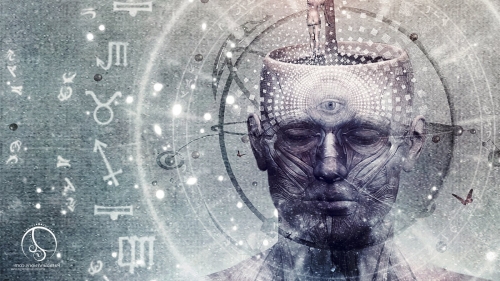
Le propre de cette machine de guerre uniformisatrice est qu'elle s'exerce désormais non par une collectivité contre une autre, mais contre chacun, contre chaque âme éprise de l'Ame du monde. Dans ce combat, chacune de nos défaites a une conséquence immédiate pour chacun d'entre nous et par chacun d'entre nous.
A l'ensoleillement de l'âme qui naît dans la nuit dont elle révèle et fait resplendit le mystère, le Moderne a substitué l'éclairage scialytique, le néon commercial, la blafarde clarté de l'écran d'ordinateur. Il a remplacé la pensée méditante, qui délivre, par la pensée calculante qui emprisonne et infléchit les caractères vers la cupidité, l'envie et l'ennui. La fréquentation des humains en devient difficile. Les conversations, dans la plupart des cas, se ramènent à un « zapping » fastidieux; toute promenade devient une prédation touristique; toute relation humaine, une tractation pesante, voire menaçante.
Lorsque le monde disparaît, lorsque les femmes et les hommes n'ont plus conscience de faire partie de cette Quaternité, avec le ciel, la terre et les dieux, que Heidegger évoque en suivant Hölderlin, une affreuse incarcération commence, une peine illimitée dans ce « sous-sol » dont parle Dostoïevski, et d'où ne s'élèvent que des plaintes haineuses.
L'Enfer et le Paradis sont l'un et l'autre à notre portée ; cette belle énigme théologique, nommée le « libre-arbitre » trouve ici son mode d'application. Tel est l’alpha et l’oméga de la sapience : il est en nous, et donc ici-bas, un enfer et un paradis pris dans les rets du temps qui sont les reflets de l’Enfer et du Paradis éternel, et, non point en général, mais à chaque instant précis, il nous appartient de choisir l’un ou l’autre, de prendre le parti de l’un ou de l’autre. Même lorsque nous ne faisons rien en apparence, ou que nous ne faisons que songer et penser, il nous appartient que ces songes et ces pensées soient de la source vive ou de la citerne croupissante ; il nous appartient qu’elles chantent et se remémorent les heures heureuses, ou qu’elles s’aigrissent. Il nous appartient de boire à la source de Mnémosyne ou à celle du Léthé. Quiconque demeure encore quelque peu attaché à la spiritualité européenne peut se redire, dans le fond du cœur, en toute circonstance, ce qui est écrit sur la Feuille d’Or orphique trouvée à Pharsale :
« A l’entrée de la demeure des morts
Tu trouveras sur la droite une source.
Près d’elle se dresse un cyprès blanc
Cette source ne t’en approche pas.
Plus loin tu trouveras l’eau fraîche
Qui jaillit du lac de Mémoire, veillée par des gardiens.
Ils te demanderont pourquoi tu viens vers eux.
Dis-leur : je suis fils de la Terre et du Ciel étoilé.
Mon vrai nom est l’Astré. La soif me consume.
O laissez-moi boire à la source ».
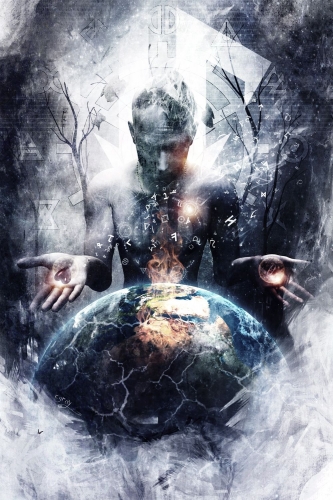
Les Symboles ne sont pas seulement des allégories, des représentations, ils sont des actes d’être. Ce qu’ils donnent à voir est l’invisible dont ils sont l’empreinte visible. Le sensible et l’intelligible ne sont pas seulement des catégories de l’entendement, mais des pôles entre lesquels se déploie une gradation infinie, que nos sens et notre entendement seuls ne peuvent parcourir. Entre le corps et l’esprit, l’âme est cet instrument de perception du « monde imaginal » qu’on ne saurait réduire à la fantaisie ou à ce que l’on nomme ordinairement l’imaginaire, lequel appartient à la pure subjectivité. Les œuvres de Sohravardî, de Ruzbéhân de Shîraz, ou d’Ibn’Arabi, admirablement commentées par Henry Corbin, donnent à comprendre en quoi le mundus imaginalis est bien ce « suprasensible concret », cette Ile Verte ou ce Château Tournoyant qui s’offrent à tous les hommes, par l’expérience visionnaire, aussi objectivement qu’un paysage réel.
L’Archange Empourpré qu’évoque Sohravardî, qui apparaît au crépuscule, est le messager ce qui dans la pensée fut et n’est pas encore, l’aube en attente dont le crépuscule révèle la splendeur et le sens caché. Ainsi, oui, l’âme est l’Ange, elle est ce qui en dispose en nous la présence entre les mondes, le miroitement, l’orée, l’attente, l’attention.
Il y eut dans les grandes œuvres persanes du Moyen-Age une attention extrême et précise à ces gradations, à ces variations chromatiques de l’âme allant à la rencontre de son ange, à cette multiplicité des états d’être et de conscience, sans laquelle nous demeurons emprisonnés dans des représentations sommaires et réduits à un exercice de la vie purement utilitaire et avilissant, mais cette attention se retrouve tout aussi bien chez Hildegarde de Bingen ou Maître Eckhart, et plus en amont, dans les Ennéades de Plotin.
Une catena aurea néoplatonicienne, quelque peu secrète, traverse la culture européenne fort différente du « platonisme » selon sa commune définition scolaire de « séparation entre le monde sensible et le monde idéal ». L’Idée n’est pas séparée de la forme sensible, elle est la forme formatrice de cette forme. Le monde sensible n’est pas « séparé », et encore moins « opposé », au monde des Idées, mais empreinte héraldique des Idées. Ce n’est que dans l’oubli de l’âme que s’opposent le corps et l’esprit, qui deviennent ainsi l’un à l’autre leur propre enfer. Or voici Marsile Ficin, qui parle du « rire de la lumière », voici Shelley, qui nous invite au voyage de « l’âme de l’Ame », Epispsychidion, voici Saint-Pol-Roux et ses ensoleillements, « symboliste comme Dante », voici Oscar Wenceslas de Lubicz-Milosz, dont l’Ars Magna et les Arcanes décrivent le surgissement, par le Verbe, d’un « autre espace-temps » non point irréel mais à partir duquel toute réalité s’ordonne, s’éclaire ou s’obscurcît, selon l’attention déférente que nous savons, ou non, lui porter.
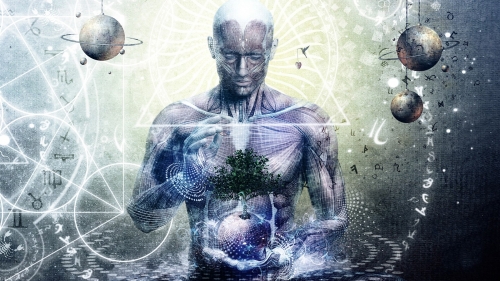
Tout ce qui importe se joue dans notre perception du temps. Est-il un autre temps que le temps de l’usure et de la destruction ? Sous quelles conditions s’offre-t-il à notre attention, dans quelles incandescences ? La plus haute intensité, celle qui délivre, ne vient pas dans la hâte, l’agitation et le tumulte, mais dans le calme et le silence : « regard de diamant » comme disent les taoïstes.
L’âme est ce qui éveille, derrière les yeux de chair, les « yeux de feu ». « C’est au yeux de feu seuls qu’apparaît ce qui unit Proclus à Botticelli et l’Empereur Julien à Franz Liszt » disait Jean-Louis Vieillard-Baron, dans l’une de ses belles conférences de l’Université Saint-Jean de Jérusalem. Par l’exercice herméneutique, un arrière-plan apparaît, une conscience dans la conscience, antérieure à toute analyse et à toute explication historique, qui, si elle ne peut se prouver, selon les lois de la science reproductive, s’éprouve et se dit. En amont, dans une immensité antérieure, dans un ressac de réminiscences se tient une Sapience, qui est le bonheur même, une région paradisiaque, cet « invincible été » que l’on porte en soi au cœur de l’hiver, comme disait Camus, une gnose soleilleuse, si merveilleusement figurée dans le fameux traité d’Alchimie, intitulé précisément Splendor Solis, et qui nous revient, non de façon planifiable mais à la venvole, et pour laquelle il convient donc de se tenir prêts à chaque instant.
Tel est exactement le sens de la chevalerie spirituelle, de ce cheminement vers le Graal ou la Jérusalem Céleste, entre la Mort et le Diable, comme sur la gravure de Dürer. Le combat pour l’Ame du monde oppose un sacrifice à un gâchis. Le moderne ne voulant rien sacrifier gâche tout. A tant vouloir opposer le corps et l’esprit, il perd le bon usage de l’un et de l’autre. Nous conquerrons, ou nous perdrons, en même temps et du même geste, la beauté de l’instant et la splendeur de l’éternité, le frémissement sensible et les lumières secrètes de l’Intellect, la présence immédiate, l’éclosion de l’acte d’être et la fidélité à la Tradition qui nous en donne les clefs. A la fine pointe de la seconde advenante, à l’aube de la fragile et fraîche éclosion, le beau récitatif nous vient en vagues depuis la nuit des temps par l’intercession d’Orphée et de Virgile.
Contre les armes dont le monde moderne use contre nous afin de nous épuiser et de nous distraire, reprenons sans ambages le Bouclier de Vulcain tel qu’il apparaît, en figuration de l’Ame du monde, dans l’Enéide : feu primordial et cœur du monde. « Par lui, écrit Yves Dauge, s’enracinent dans l’histoire les Idées pensées par Jupiter, formée par Apollon, transmise par Mercure et vivifiées par Vénus ». Telle est exactement l’âme avivée, l’âme sauvegardée : une voie vers la pensée intérieure des êtres et des choses, au point où elles se forment en se délivrant de l’informe, et voyagent vers nous par des ambassades ailées, celle des poètes et des herméneutes, pour finalement être touchées et vivifiées par l’amour.
Luc-Olivier d’Algange
16:43 Publié dans Traditions | Lien permanent | Commentaires (0) | Tags : âme, tradition, traditionalisme, spiritualité, luc-olivier d'algange |  |
|  del.icio.us |
del.icio.us |  |
|  Digg |
Digg | ![]() Facebook
Facebook
mardi, 19 janvier 2021
Quelques réflexions sur les castes et la tripartition
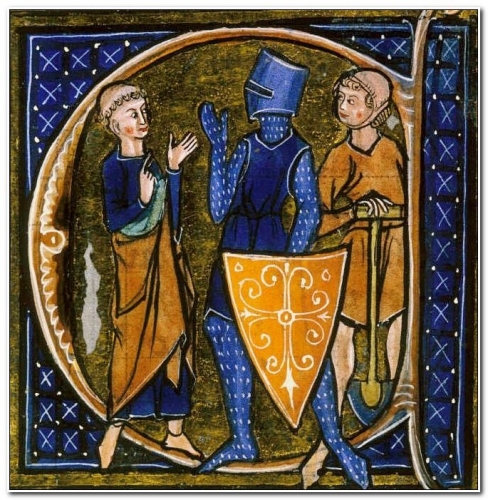
Quelques réflexions sur les castes et la tripartition
CASTES
« Par la distribution différente
Des qualités et des actions,
J’ai créé les quatre castes.
Sache que c’est Moi leur auteur. »
(Bhagavad-Gîta, IV. 13)
[C’est le Dieu suprême qui parle.]
« Quand le devoir tombe dans l’oubli,
Les femmes se corrompent, ô Krishna !
Et quand les femmes se corrompent, ô Varshneya,
Alors naît la confusion des castes. »
(Bhagavad-Gita, I. 41; traduction d’Anna Kamensky)
[La confusion des castes : le règne des Tchandalas.]
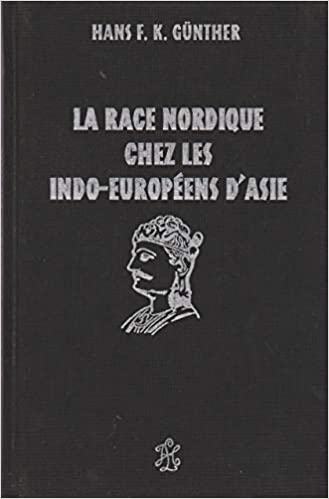 « [En Inde, juste avant l’apparition du bouddhisme] La civilisation la plus élevée qu’un peuple puisse atteindre dans un état ordonnancé était atteinte. La loi et le droit réglaient la vie des membres de l’Etat. La division du peuple en castes indiquait à chacun la voie de sa vie. Le trône des princes était environné de pompe et de luxe ; la caste des prêtres et celle des guerriers étaient près du trône et menaient une vie confortable, aux dépens du peuple, il est vrai ; cependant les castes des artisans, des commerçants et des agriculteurs avaient leurs cercles juridiques qui leur étaient garantis par la loi et dans l’intérieur desquels elles pouvaient se mouvoir librement. Il y avait bien de nombreuses castes inférieures, castes de serviteurs dont la vie se passait à travailler pour d’autres, mais on consolait ces castes par des promesses religieuses, de sorte que ça et là un rayon d’espoir, une divine étincelle de joie, tombait sur la misère de leur vie. »
« [En Inde, juste avant l’apparition du bouddhisme] La civilisation la plus élevée qu’un peuple puisse atteindre dans un état ordonnancé était atteinte. La loi et le droit réglaient la vie des membres de l’Etat. La division du peuple en castes indiquait à chacun la voie de sa vie. Le trône des princes était environné de pompe et de luxe ; la caste des prêtres et celle des guerriers étaient près du trône et menaient une vie confortable, aux dépens du peuple, il est vrai ; cependant les castes des artisans, des commerçants et des agriculteurs avaient leurs cercles juridiques qui leur étaient garantis par la loi et dans l’intérieur desquels elles pouvaient se mouvoir librement. Il y avait bien de nombreuses castes inférieures, castes de serviteurs dont la vie se passait à travailler pour d’autres, mais on consolait ces castes par des promesses religieuses, de sorte que ça et là un rayon d’espoir, une divine étincelle de joie, tombait sur la misère de leur vie. »
(Ludwig Gumplowicz, La lutte des races, 1883)
« L’ordonnance des castes apparaît chez Manu d’une grande intransigeance. Cependant, cette sévérité qui peut encore nous sembler injuste dans l’Inde actuelle est atténuée, pour l’Hindou croyant, par la métempsychose, concept qui vient peut-être de la population pré-indo-européenne mais qui fut édifié intellectuellement par les Aryens ; un Shudra vertueux peut se réincarner en un Vaishya, un Vaishya vertueux en Kshatriya, un Kshatriya vertueux en un Brahmane. »
(Hans F.K. Günther, La race nordique chez les Indo-Européens d’Asie, 1934)
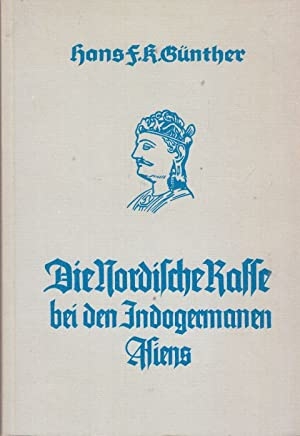 « Il y a là plus que des classes, qui sont une dégradation économique et matérialiste ; les castes reflètent un ordre métaphysique où chaque individu accomplit sa fonction selon sa vraie volonté – ou devoir, dharma – en tant que manifestation de l’ordre cosmique. Pour les fidèles de la Tradition Pérenne, la caste est une manifestation de l’ordre divin et pas seulement une division économique du travail en vue d’une grossière exploitation. »
« Il y a là plus que des classes, qui sont une dégradation économique et matérialiste ; les castes reflètent un ordre métaphysique où chaque individu accomplit sa fonction selon sa vraie volonté – ou devoir, dharma – en tant que manifestation de l’ordre cosmique. Pour les fidèles de la Tradition Pérenne, la caste est une manifestation de l’ordre divin et pas seulement une division économique du travail en vue d’une grossière exploitation. »
(Julius Evola, La tradition hermétique)
« Toute société est nécessairement divisée en quatre groupes correspondant à quatre fonctions essentielles sans lesquelles aucune civilisation ne saurait subsister. Chaque fois que, au cours de l’histoire, on a essayé d’altérer ou de supprimer cette division fondamentale, on la voit reparaître sous quelque autre forme car elle est inhérente à la nature de l’homme. »
(Alain Daniélou, Les Quatre Sens de la Vie)
« L’humanité ne trouve l’équilibre et le bonheur que lorsque les quatre groupes humains qui sont à la base des quatre castes sont en harmonie. Cela seul permet d’éviter les quatre tyrannies dont parle Manu, le grand législateur, et qui sont la tyrannie des prêtres, celle des guerriers, celle des marchands et celle de la classe ouvrière qui sont également néfastes et se succèdent indéfiniment jusqu’à ce qu’un équilibre social soit rétabli.
Il n’est pas nécessaire d’aller en Inde pour observer ce cycle inéluctable, l’Europe, dans le passé récent, a connu la prise du pouvoir par l’Église, puis par l’aristocratie suivie de la bourgeoisie capitaliste, et enfin la dictature du prolétariat. Aucune de ces formules n’est stable ni efficace. Elles aboutissent inévitablement à la tyrannie et à l’injustice. Seule une reconnaissance des quatre groupes essentiels à toute société et leur attribution de droits et de privilèges distincts peut permettre une organisation sociale stable et juste. C’est une organisation de ce genre, le système des castes, qui a permis à l’Inde, malgré les invasions et les guerres, de maintenir une civilisation ininterrompue depuis l’Antiquité. Le Moyen Âge européen avait tenté d’établir une organisation de ce genre. Ce fut l’Église, avec l’Inquisition qui rompit l’équilibre. »
(Alain Daniélou, Shiva et Dionysos, 1979)
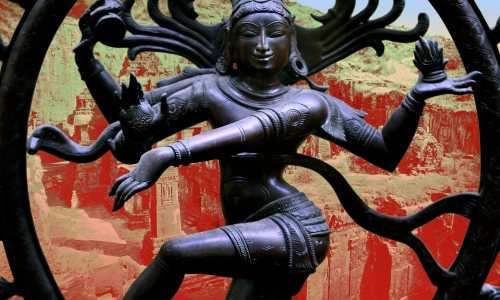
TRIPARTITION
« …il est très remarquable que l’organisation sociale du Moyen Age occidental ait été calquée exactement sur la division des castes, le clergé correspondant aux Brahmanes, la noblesse aux Kshatriyas, le tiers-état aux Vaishyas, et les serfs aux Shudras. »
(René Guénon, Autorité spirituelle et pouvoir temporel, 1929)
[La même remarque figure, en termes quasi-identiques, dans Le roi du monde (1927).]
« La prééminence du soldat sur l’agriculteur et de l’agriculteur sur le marchand, que l’hitlérisme postule, était admise par toutes les sociétés antiques. »
(Alfred Fabre-Luce, Journal de la France, 1940)
« Le type économique est en lui-même inférieur non seulement au type spirituel au sens le plus élevé du terme, mais en outre au guerrier, à l’homme d’Etat, au penseur et à l’artiste. (…) Aussi le gouvernement exclusif par la classe économique serait-il l’expression extrême de la suprématie d’une classe unique, et, cette classe étant en elle-même inférieure d’après tous les critères spirituels, sa suprématie aboutirait nécessairement à un état général inférieur. »
(Hermann von Keyserling, Diagnostic de l’Amérique et de l’américanisme, 1941)
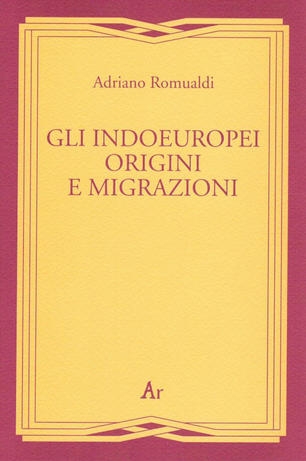 « Le premier devoir est de combattre pour la restauration de l’Ordre. Pas tel ou tel Ordre particulier, telle ou telle formule politique contingente, mais l’Ordre sans adjectifs, la hiérarchie immuable des pouvoirs spirituels à l’intérieur de l’individu et de l’Etat qui place au sommet ceux qui sont ascétiques, héroïques et politiques et au-dessous ceux qui sont simplement économiques et administratifs. »
« Le premier devoir est de combattre pour la restauration de l’Ordre. Pas tel ou tel Ordre particulier, telle ou telle formule politique contingente, mais l’Ordre sans adjectifs, la hiérarchie immuable des pouvoirs spirituels à l’intérieur de l’individu et de l’Etat qui place au sommet ceux qui sont ascétiques, héroïques et politiques et au-dessous ceux qui sont simplement économiques et administratifs. »
(Adriano Romualdi)
« Le principe européen par excellence postulait la prééminence du souverain et du prêtre sur le guerrier, et celle du guerrier sur le producteur-consommateur. Ou, si l’on préfère, de l’âme et de l’esprit sur le cœur, et du cœur sur le ventre, du spirituel sur le corporel et du corporel sur l’économique. »
(Alain de Benoist)
« …quelques-unes des grandes réussites ou des grands efforts de puissance, jusque dans la plus moderne histoire de notre Europe, reposent sur des reviviscences claires et simples du vieil archétype trifonctionnel. (…) [par ex.] les trois rouages essentiels de l’Etat soviétique (le parti avec la police, l’armée rouge, les ouvriers et les paysans), ceux de l’Etat nazi (le Partei avec la police, la Wehrmacht, l’Arbeitsfront) [qui] constituent des machines dont l’efficacité n’est pas contestable. »
(Georges Dumézil, L’oubli de l’homme et l’honneur des dieux, Gallimard 1985)
« Je pense que quand les Indo-Européens sont nomades et que leur économie et leur structure sociale sont les plus simples, il y a trois fonctions, mais que quand les Indo-Européens s’établissent à un endroit et commencent à pratiquer l’agriculture et le commerce, il y a alors une différenciation entre employés et travailleurs, et un système quadripartite surgit. »
(Greg Johnson, article sur TOQ, 2011)
« …l’anthropologie de l’apôtre Paul apparaît trichotomique, distinguant en l’homme, l’esprit, le corps et l’âme. Cette trichotomie serait pleinement applicable à la structure de l’Empire idéal. (…)
 L’espace, la terre, le territoire, la zone de contrôle et d’influence constituent le contenu corporel de l’Empire et correspondent au corps de l’homme. (…) Le peuple correspond à l’âme ; il vit et se déplace, aime et déteste, tombe et se relève, s’envole et souffre. (…) La religion correspond à l’esprit. Elle montre des perspectives montagneuses, elle assure le contact avec l’éternité, elle dirige le regard vers le ciel.
L’espace, la terre, le territoire, la zone de contrôle et d’influence constituent le contenu corporel de l’Empire et correspondent au corps de l’homme. (…) Le peuple correspond à l’âme ; il vit et se déplace, aime et déteste, tombe et se relève, s’envole et souffre. (…) La religion correspond à l’esprit. Elle montre des perspectives montagneuses, elle assure le contact avec l’éternité, elle dirige le regard vers le ciel.
De même que l’homme possède obligatoirement un corps, une âme et un esprit, selon le christianisme, de même l’Empire possède un espace, un peuple et une religion. »
(Alexandre Douguine, La Quatrième théorie politique, 2012)
« Dans Homère, le mythe de la guerre de Troie débute par la faute de Pâris, noble troyen. Il voit arriver devant lui trois déesses, une par fonction : Héra représente la fonction souveraine, Athéna la fonction guerrière et Aphrodite, la déesse de l’amour, la troisième fonction. Pâris doit remettre une pomme d’or à la plus belle et il choisit Aphrodite. Il entraîne alors Troie dans la ruine car les déesses de la souveraineté et de la guerre vont se venger et prendront le parti des Grecs contre les Troyens.
Il ne faut pas inverser la hiérarchie des fonctions, telle est la leçon du mythe. Il faut aussi un équilibre à l’intérieur des fonctions.
Les Etats fascistes sont morts d’avoir mis la fonction guerrière au-dessus de tout. Les Etats occidentaux ont tendance aujourd’hui, sous l’impulsion des Etats-Unis, à faire dominer la troisième fonction. (…) Au sein de la troisième fonction, la sous-fonction marchande l’emporte sur la sous-fonction familiale. (…) L’économie détermine seule le sens de la vie. »
(Ivan Blot, La Russie de Poutine, 2016)
« [Lors de la chute du communisme en 1991] Les fonctions souveraines et guerrières, accaparées par le Parti communiste, se sont effondrées. La troisième fonction économique, non régulée, donc chaotique, a pris le dessus comme nous l’avons vu plus haut. La natalité s’est effondrée, la criminalité est partie en hausse, la mortalité a augmenté, fait unique dans un pays développé. L’économie elle-même a chuté, car elle a besoin d’un cadre stable.
La chance de la Russie, qui ne fut pas celle de l’Ukraine, est qu’elle avait de longue date une forte tradition militaire. C’est le milieu des officiers qui est arrivé à contrôler les oligarques, et le président Poutine en est l’émanation. La Russie actuelle a rétabli la hiérarchie des trois fonctions. La sous-fonction religieuse est réapparue et collabore avec l’Etat. Le président et le patriarche de Moscou, Cyrille, incarnent cette double fonction souveraine. La fonction militaire a été revalorisée. La troisième fonction (production et reproduction) a été rééquilibrée pour que la famille ne se désagrège pas au profit de la seule sous-fonction économique.
En même temps, les valeurs des deux premières fonctions ont été réaffirmées : patriotisme, moralité chrétienne, sens de l’honneur. »
(Ivan Blot, La Russie de Poutine, 2016)
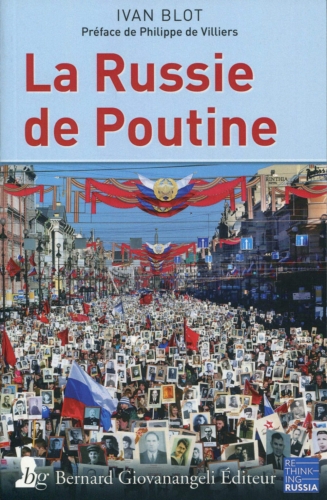 « …la Russie nouvelle est une démocratie de type ‘gaullien’ avec des libertés, des élections, l’ouverture sur l’étranger mais la hiérarchie des trois fonctions a été rétablie. C’est une démocratie ‘tripartitionnelle’, différente du totalitarisme communiste qui avait détruit la troisième fonction, et différente de l’Occident dominé par le Gestell qui entraîne la dégénérescence des deux premières fonctions de souveraineté et militaire. En Russie, on est en économie libre de marché mais la primauté de la fonction de souveraineté est rétablie, et la fonction de défense est réévaluée dans la vie sociale. »
« …la Russie nouvelle est une démocratie de type ‘gaullien’ avec des libertés, des élections, l’ouverture sur l’étranger mais la hiérarchie des trois fonctions a été rétablie. C’est une démocratie ‘tripartitionnelle’, différente du totalitarisme communiste qui avait détruit la troisième fonction, et différente de l’Occident dominé par le Gestell qui entraîne la dégénérescence des deux premières fonctions de souveraineté et militaire. En Russie, on est en économie libre de marché mais la primauté de la fonction de souveraineté est rétablie, et la fonction de défense est réévaluée dans la vie sociale. »
(Ivan Blot, La Russie de Poutine, 2016)
« Les intérêts économiques doivent être subordonnés aux intérêts stratégiques. Ce n’est pas à Mercure de régner sur l’Olympe. Ce n’est pas à l’intendance de donner des ordres. »
(Thomas Ferrier, tweet du 26 décembre 2020)
[Il y en a certains qui doivent se sentir visés… D’ailleurs, de Gaulle avait déjà dit : « La politique de la France ne se fait pas à la Corbeille ». Et on connaît aussi : « L’intendance suivra ». Aujourd’hui, il y a beaucoup de représentant de « l’intendance » parmi les dirigeants occidentaux… (mais pas en Russie et en Chine…)]
18:39 Publié dans Traditions | Lien permanent | Commentaires (0) | Tags : traditions, castes, trifonctionnalité, tripartition |  |
|  del.icio.us |
del.icio.us |  |
|  Digg |
Digg | ![]() Facebook
Facebook
jeudi, 14 janvier 2021
L'âge du fer qui fond : réflexions sur la modernité et le Kali Yuga

L'âge du fer qui fond : réflexions sur la modernité et le Kali Yuga
par Angel Millar
Il y a un certain débat sur le moment exact où les âges commencent et se terminent, mais selon les traditionalistes, qui s'inspirent de l'hindouisme, nous descendons de l'âge d'or (Satya Yuga), lorsque l'humanité était intimement liée au Divin et vivait en harmonie avec la nature, et nous sommes maintenant dans l'âge de fer matérialiste (Kali Yuga).
Dans le Kali Yuga, la quantité prime sur la qualité ; la richesse (et non l'intelligence ou la sagesse) est considérée comme la preuve de la valeur d'un homme ; les gens ne se soucient plus de leurs parents ou de leurs aînés, et les hommes et les femmes s'unissent exclusivement par attirance physique.
Peut-être parce que nous associons l'âge de fer à la "quantité" et, plus précisément, au "royaume de la quantité", nous devrions considérer le Kali Yuga comme pesant, comme une époque de fer et de ruine. Pourtant, ce n'est pas le cas aujourd'hui.
 Dans Liquid Modernity, le sociologue polonais Zygmunt Bauman décrit comment la politique des Lumières a voulu éroder ce qui était devenu statique et oppressif. L'idée était qu'une fois l'ancien régime ruiné, de nouveaux systèmes, plus équitables et plus gratifiants, seraient mis en place. Mais ce n'est pas ce qui s'est passé. L'acide corrosif a continué à désintégrer tout ce qu'il touche, de sorte que nous avons maintenant une "modernité liquide", une modernité où tout est léger, fugace, fluide, mutant, autodestructeur, et peut-être surtout, dénué de sens.
Dans Liquid Modernity, le sociologue polonais Zygmunt Bauman décrit comment la politique des Lumières a voulu éroder ce qui était devenu statique et oppressif. L'idée était qu'une fois l'ancien régime ruiné, de nouveaux systèmes, plus équitables et plus gratifiants, seraient mis en place. Mais ce n'est pas ce qui s'est passé. L'acide corrosif a continué à désintégrer tout ce qu'il touche, de sorte que nous avons maintenant une "modernité liquide", une modernité où tout est léger, fugace, fluide, mutant, autodestructeur, et peut-être surtout, dénué de sens.
La vision orwellienne de notre monde après la Seconde Guerre mondiale était grise, rigide, oppressante et industrielle. Certaines caractéristiques "orwelliennes" font partie de notre époque, il est vrai ; en particulier l'abus politique de mots creux, qui en fait leur contraire ("dommage collatéral", terme militaire désignant les morts violentes dues aux opérations, étant l'un des plus connus), et la "double pensée" que le "politiquement correct" impose à ses adeptes, qui doivent croire des choses différentes selon la personne qui parle, et à quelle catégorie politique leur "identité" correspond.
L'expressivité apparaît également dans la foule qui crie, dénonçant l'individu pour ses mauvaises pensées. Mais ces foules sont composées de volontaires, plutôt que d'acteurs étatiques, et bien qu'elles se considèrent comme les gardiens d'une haute moralité, et dénoncent la superficialité des Occidentaux qui ne s'intéressent qu'au cinéma, à la musique populaire et à la télévision, c'est leur comportement criard qui vise à créer un tel monde de désintérêt pour les questions sérieuses, un monde où il n’y a qu’absence de réflexion. En d'autres termes, contrairement à ce que fait Orwell dans 1984, l'oppression agit elle aussi ‘’pour se liquéfier et faire lumière’’. Mais regardons quelques exemples de la réalité liquide de notre âge de fer.
Nous avons tous entendu parler du besoin de "liquidité" sur les marchés financiers, longtemps libérés de l'étalon-or, solide et lourd, et de la nécessité pour les entreprises individuelles de disposer de liquidités. Depuis que Bauman a écrit Liquid Modernity, le "genre fluide" est devenu partie intégrante du langage et de l'idéologie du monde moderne. Le genre, par exemple, est devenu changeant, et donc "l'hétéro-normativité", ou le schéma traditionnel du genre, pourrait-on dire, est désormais considéré comme oppressif. La fluidité entre les sexes est aussi souhaitable que la fluidité financière, il n’est donc pas idéal pas qu'ils soient entièrement séparées.
La "quantité" n'est pas une question de poids et d'immobilité, mais est dorénavant ce qui est léger, plus menu, vide et fluide. Prenons l'exemple de la nourriture. Il y a de la nourriture bon marché partout. Et pourtant, cette nourriture habituellement produite en vrac ne nous donne guère plus que des "calories vides" qui nous rendent parfois malades. Des légumes vaporisés de pesticides aux innombrables rangées de boîtes colorées avec des personnages dessinés sur leur côté pile, qui plaisent aux jeunes enfants, le domaine de la quantité est soit caché, soit évident, mais toujours d'apparence amicale.

Et puis il y a la guerre. Il ne s'agit plus de défendre sa nation, et certainement pas sa culture traditionnelle. La guerre, dit Bauman, "ressemble de plus en plus à une ‘’promotion du libre-échange mondial’’ par d'autres moyens". (p. 12). Mais elle se justifie aussi par les choses les plus glissantes : apporter la "liberté", la "démocratie", ou peut-être les droits des femmes. La guerre, c'est aussi le nomadisme. Les cultures traditionnelles sont arrachées de leur sol pour la première fois depuis plus de mille ans.
En plus d'être plus léger et plus fluide, il y a une autre caractéristique de la modernité : moins cher. Il y a un siècle, ou moins, nous avons compris qu'il valait la peine d'acheter quelque chose qui durerait toute une vie. Il pourrait être transmis à la génération suivante. Aujourd'hui, le consommateur moyen veut acheter le produit le moins cher, même s'il s'effondre après une utilisation de courte durée, car il est probable que, quoi qu'il arrive, il sera démodé avant même cette date.
Les "travailleurs illégaux" contribuent évidemment à maintenir les prix bas. Lorsque l'on parle du "rêve américain" en matière d'immigration, l'idée confortable et consciente que les immigrants s'en sortent bien aux États-Unis est sous-tendue par le "rêve" inconscient mais réel : que la classe moyenne, de plus en plus appauvrie, puisse maintenir un mode de vie de classe moyenne grâce à une main-d'œuvre de plus en plus bon marché.
En Europe aussi, les immigrants et les réfugiés ne seront pas intégrés au rêve britannique, français ou allemand, quel qu'il soit. Ils sont utiles pour le travail bon marché, et utiles pour les élites qui ont besoin de montrer à quel point elles sont morales et consciencieuses, mais qui ne veulent pas le faire à leurs dépens.

Malgré tous les discours sur l'intégration, les gens ne peuvent pas s'intégrer dans l'existence vide, liquide et en mutation de la modernité. Au contraire, ironiquement, les immigrants de Syrie, de Libye, du Pakistan et d'ailleurs apportent ce qui est défini et enraciné dans la tradition et la religion, et ils ne le quitteront pas facilement, notamment parce qu'ils sont des immigrants. Les États-Unis, qui jusqu'à récemment n'étaient guère plus que l'Europe portés vers la religion, se sont accrochés à la religion et aux traditions européennes d'une manière que les États européens modernes n'ont pas, parce qu'ils sont eux aussi une "nation d'immigrants".
Dans le film Duna, "l'épice doit couler". L'épice est similaire à ce que nous connaissons sous le nom de Soma ou de Hoama zoroastrien, une sorte de narcotique ou de substance qui semble apporter une sorte de lumière. Peut-être parce que le film, et le livre sur lequel il est basé, se déroule dans le désert, l'"épice" a naturellement été comparée au pétrole : "le pétrole doit couler", de préférence vers l'ouest. Mais le pétrole était hier instable sur le plan économique. Aujourd'hui, pour entretenir l'illusion de richesse et de modernité, c'est l'immigration qui doit circuler.
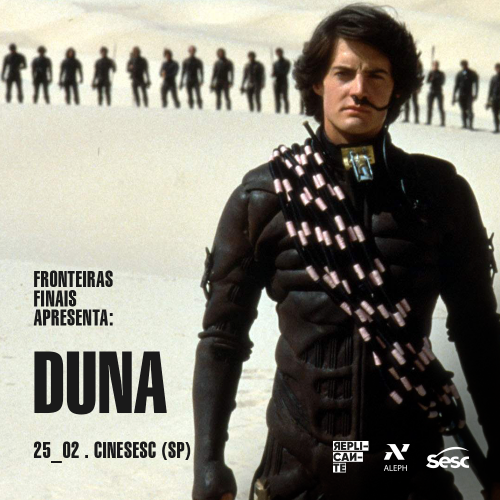
"Nous assistons à la revanche du nomadisme sur le principe de territorialité et de colonisation", déclare Bauman. "Dans la phase fluide de la modernité, la majorité stable est gouvernée par l'élite nomade et extraterritoriale. Garder les routes libres pour le trafic nomade et faire disparaître les derniers points de contrôle est devenu le méta-objectif de la politique, et aussi des guerres..." (p. 13).
Mais même la main-d'œuvre bon marché ne peut pas être rendue assez bon marché. Si nous avons des problèmes pour remplacer le pétrole par l'énergie solaire, nous avons moins de problèmes pour remplacer les gens par des machines, ce qui a commencé avec la révolution industrielle. Récemment, les fonds Oppenheimer ont lancé leur propagande "le non-humain est beau". Dans la publicité, on voit un robot qui aide une femme à mettre son manteau et un autre petit robot qui sert des boissons lors d'une fête au bord de la piscine. Nous avons peut-être peur des robots, tout comme les gens craignent une immigration incontrôlée, mais la société d'investissement mondiale nous assure qu'il y aura des robots dans chaque foyer d'ici 2025. Les robots sont "beaux", et nous devrions investir dans un "bel avenir", ou pour le dire autrement, un avenir plus liquide.
L'âge du fer, oui, mais d’un fer qui a été fondu. La tradition, nous dit Gustav Mahler, n'est pas de conserver les cendres, mais de transmettre la flamme. Nous devons également dire qu'il s'agit de transmettre l'essentiel. Mais ce doit être aussi pour transmettre les formes des choses, pour transmettre un royaume mort et devenu psychique, avec des guerriers, des prêtres, des mystiques, des amoureux, de grandes œuvres d'art, de grandes constructions, des compétences, des idées, etc. qui existent maintenant sous forme de légende, d'histoires, de philosophies, de dictons, de peintures, de sculptures, etc.
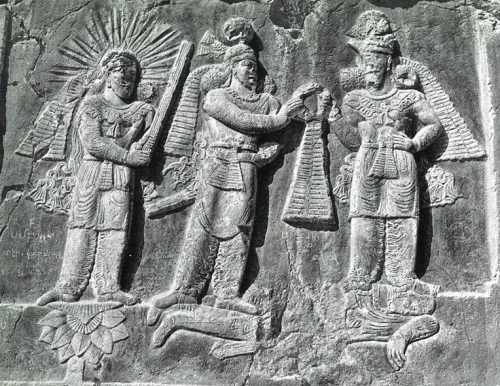
Le fer est une chose particulière. Considéré par les alchimistes comme l'un des métaux de base, et par les hommes modernes comme archaïque et moins utile que l'acier, les anciens le voyaient différemment. Les Zoroastriens pensaient que les cieux étaient faits de "pierre dure", ils semblaient donc faire référence au fer météorique, quelque chose que beaucoup de peuples anciens utilisaient, surtout de manière rituelle. Le fer, sombre et dense, est, comme nous l'avons découvert, symbolique du ciel, des dieux, du Divin. Que ce soit intentionnel ou non, nous pouvons prendre cela comme un signe de la façon de vivre dans l'âge de fer actuel : renforcer notre corps et aiguiser notre esprit, notre pensée et nos capacités.
Intentionnel ou non, nous pouvons prendre cela comme un signe de la façon de vivre à notre époque. Comme les métallurgistes, nous pouvons appliquer de la chaleur à notre propre vie, en nous purifiant, mais en devenant plus solides, en façonnant notre vie en quelque chose qui reflète l'éternel. Nous pouvons penser à des exercices, où notre corps est trempé dans notre propre sueur "liquide", mais est moulé et durci à cause de cela. L'âge du fer fondu veut nous emporter avec lui, mais en appliquant la flamme et en ré-imaginant les formes des valeurs et des pratiques anciennes, des domaines de la force physique et de la santé à l'élévation mentale et spirituelle, et en nous remodelant en conséquence, nous pouvons résister aux coulées fondues de la modernité.
00:05 Publié dans Traditions | Lien permanent | Commentaires (0) | Tags : âge de fer, tradition, traditionalisme |  |
|  del.icio.us |
del.icio.us |  |
|  Digg |
Digg | ![]() Facebook
Facebook
mardi, 12 janvier 2021
Ami - Ennemi, le fondement du politique (Carl Schmitt)
00:27 Publié dans Philosophie, Révolution conservatrice, Traditions | Lien permanent | Commentaires (0) | Tags : carl schmitt, révolution conservatrice, philosophie, philosophie politique, théorie politique, politologie, sciences politiques |  |
|  del.icio.us |
del.icio.us |  |
|  Digg |
Digg | ![]() Facebook
Facebook
lundi, 11 janvier 2021
L'œil du cyclone - Julius Evola, Ernst Jünger
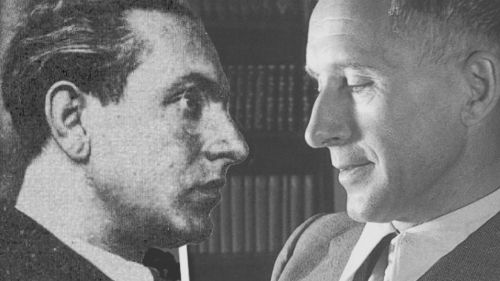
Luc-Olivier d'Algange:
L'œil du cyclone
Julius Evola, Ernst Jünger
« Comme Jack London, et divers autres, y compris Ernst Jünger à
ses débuts, des individualités isolées se vouèrent à l'aventure, à
la recherche de nouveaux horizons, sur des terres et des mers
lointaines, alors que, pour le reste des hommes, tout semblait
être en ordre, sûr et solide et que sous le règne de la science
on célébrait la marche triomphale du progrès, à peine troublée
par le fracas des bombes anarchistes. »
Julius Evola
« Ta répugnance envers les querelles de nos pères avec nos grands
pères, et envers toutes les manières possibles de leur trouver une
solution, trahit déjà que tu n'as pas besoin de réponses mais d'un
questionnement plus aigu, non de drapeaux, mais de guerriers, non
d'ordre mais de révolte, non de systèmes, mais d'hommes. »
Ernst Jünger
On peut gloser à l'infini sur ce qui distingue ou oppose Ernst Jünger et Julius Evola. Lorsque celui-là avance par intuitions, visions, formes brèves inspirées des moralistes français non moins que de Novalis et de Nietzsche, celui-ci s'efforce à un exposé de plus en plus systématique, voire doctrinal. Alors que Jünger abandonne très tôt l'activité politique, même indirecte, la jugeant « inconvenante » à la fois du point de vue du style et de celui de l'éthique, Evola ne cessera point tout au long de son œuvre de revenir sur une définition possible de ce que pourrait être une « droite intégrale » selon son intelligence et son cœur. Lorsque Jünger interroge avec persistance et audace le monde des songes et de la nuit, Evola témoigne d'une préférence invariable pour les hauteurs ouraniennes et le resplendissement solaire du Logos-Roi. Ernst Jünger demeure dans une large mesure un disciple de Novalis et de sa spiritualité romane, alors que Julius Evola se veut un continuateur de l'Empereur Julien, un fidèle aux dieux antérieurs, de lignée platonicienne et visionnaire.
 Ces différences favorisent des lectures non point opposées, ni exclusives l'une de l'autre, mais complémentaires. A l'exception du Travailleur, livre qui définit de façon presque didactique l'émergence d'un Type, Jünger demeure fidèle à ce cheminement que l'on peut définir, avec une grande prudence, comme « romantique » et dont la caractéristique dominante n'est certes point l'effusion sentimentale mais la nature déambulatoire, le goût des sentes forestières, ces « chemins qui ne mènent nulle part » qu'affectionnait Heidegger, à la suite d'Heinrich von Ofterdingen et du « voyageur » de Gènes, de Venise et d'Engadine, toujours accompagné d'une « ombre » qui n'est point celle du désespoir, ni du doute, mais sans doute l'ombre de la Mesure qui suit la marche de ces hommes qui vont vers le soleil sans craindre la démesure.
Ces différences favorisent des lectures non point opposées, ni exclusives l'une de l'autre, mais complémentaires. A l'exception du Travailleur, livre qui définit de façon presque didactique l'émergence d'un Type, Jünger demeure fidèle à ce cheminement que l'on peut définir, avec une grande prudence, comme « romantique » et dont la caractéristique dominante n'est certes point l'effusion sentimentale mais la nature déambulatoire, le goût des sentes forestières, ces « chemins qui ne mènent nulle part » qu'affectionnait Heidegger, à la suite d'Heinrich von Ofterdingen et du « voyageur » de Gènes, de Venise et d'Engadine, toujours accompagné d'une « ombre » qui n'est point celle du désespoir, ni du doute, mais sans doute l'ombre de la Mesure qui suit la marche de ces hommes qui vont vers le soleil sans craindre la démesure.
L'interrogation fondamentale, ou pour mieux dire originelle, des oeuvres de Jünger et d'Evola concerne essentiellement le dépassement du nihilisme. Le nihilisme tel que le monde moderne en précise les pouvoirs au moment où Jünger et Evola se lancent héroïquement dans l'existence, avec l'espoir d'échapper à la médiocrité, est à la fois ce qui doit être éprouvé et ce qui doit être vaincu et dépassé. Pour le Jünger du Cœur aventureux comme pour le Julius Evola des premières tentatives dadaïstes, rien n'est pire que de feindre de croire encore en un monde immobile, impartial, sûr. Ce qui menace de disparaître, la tentation est grande pour nos auteurs, adeptes d'un « réalisme héroïque », d'en précipiter la chute. Le nihilisme est, pour Jünger, comme pour Evola, une expérience à laquelle ni l'un ni l'autre ne se dérobent. Cependant, dans les « orages d'acier », ils ne croient point que l'immanence est le seul horizon de l'expérience humaine. L'épreuve, pour ténébreuse et confuse qu'elle paraisse, ne se suffit point à elle-même. Ernst Jünger et Julius Evola pressentent que le tumulte n'est que l'arcane d'une sérénité conquise. De ce cyclone qui emporte leurs vies et la haute culture européenne, ils cherchent le cœur intangible. Il s'agit là, écrit Julius Evola de la recherche « d'une vie portée à une intensité particulière qui débouche, se renverse et se libère en un "plus que vie", grâce à une rupture ontologique de niveau. » Dans l'œuvre de Jünger, comme dans celle d'Evola, l'influence de Nietzsche, on le voit, est décisive. Nietzsche, pour le dire au plus vite, peut être considéré comme l'inventeur du « nihilisme actif », c'est-à-dire d'un nihilisme qui périt dans son triomphe, en toute conscience, ou devrait-on dire selon la terminologie abellienne, dans un « paroxysme de conscience ». Nietzsche se définissait comme « le premier nihiliste complet Europe, qui a cependant déjà dépassé le nihilisme pour l'avoir vécu dans son âme, pour l'avoir derrière soi, sous soi, hors de soi. »
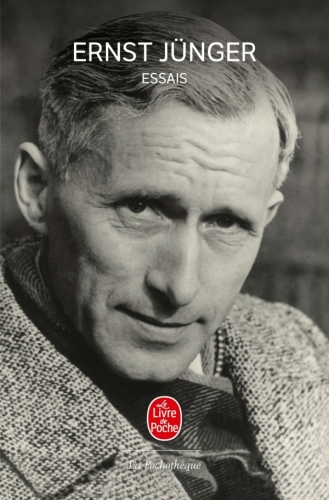
Cette épreuve terrible, nul esprit loyal n'y échappe. Le bourgeois, celui qui croit ou feint de croire aux « valeurs » n'est qu'un nihiliste passif: il est l'esprit de pesanteur qui entraîne le monde vers le règne de la quantité. « Mieux vaut être un criminel qu'un bourgeois », écrivit Jünger, non sans une certaine provocation juvénile, en ignorant peut-être aussi la nature profondément criminelle que peut revêtir, le cas échéant, la pensée calculante propre à la bourgeoisie. Peu importe : la bourgeoisie d'alors paraissait inerte, elle ne s'était pas encore emparée de la puissance du contrôle génétique et cybernétique pour soumettre le monde à sa mesquinerie. Dans la perspective nietzschéenne qui s'ouvre alors devant eux, Jünger et Evola se confrontent à la doctrine du Kirillov de Dostoïevski: « L'homme n'a inventé Dieu qu'afin de pouvoir vivre sans se tuer ». Or, ce nihilisme est encore partiel, susceptible d'être dépassé, car, pour les âmes généreuses, il n'existe des raisons de se tuer que parce qu'il existe des raisons de vivre. Ce qui importe, c'est de réinventer une métaphysique contre le monde utilitaire et de dépasser l'opposition de la vie et de la mort.
Jünger et Evola sont aussi, mais d’une manière différente, à la recherche de ce qu'André Breton nomme dans son Manifeste « Le point suprême ». Julius Evola écrit: « L'homme qui, sûr de soi parce que c'est l'être, et non la vie, qui est le centre essentiel de sa personne peut tout approcher, s'abandonner à tout et s'ouvrir à tout sans se perdre: accepter, de ce fait, n'importe quelle expérience, non plus, maintenant pour s'éprouver et se connaître mais pour développer toutes ses possibilités en vue des transformations qui peuvent se produire en lui, en vue des nouveaux contenus qui peuvent, par cette voie, s'offrir et se révéler. » Quant à Jünger, dans Le Cœur Aventureux, version 1928, il exhorte ainsi son lecteur: « Considère la vie comme un rêve entre mille rêves, et chaque rêve comme une ouverture particulière de la réalité. » Cet ordre établi, cet univers de fausse sécurité, où règne l'individu massifié, Jünger et Evola n'en veulent pas. Le réalisme héroïque dont ils se réclament n'est point froideur mais embrasement de l'être, éveil des puissances recouvertes par les écorces de cendre des habitudes, des exotérismes dominateurs, des dogmes, des sciences, des idéologies. Un mouvement identique les porte de la périphérie vers le centre, vers le secret de la souveraineté. Jünger: « La science n'est féconde que grâce à l'exigence qui en constitue le fondement. En cela réside la haute, l'exceptionnelle valeur des natures de la trempe de Saint-Augustin et de Pascal: l'union très rare d'une âme de feu et d'une intelligence pénétrante, l'accès à ce soleil invisible de Swedenborg qui est aussi lumineux qu'ardent. »
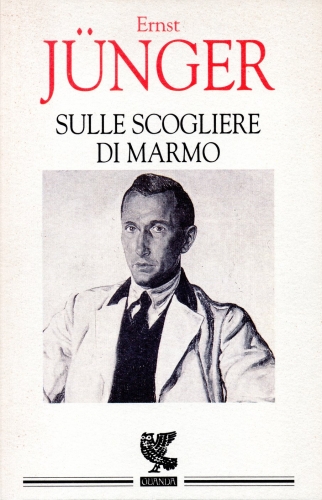
Tel est exactement le dépassement du nihilisme: révéler dans le feu qui détruit la lumière qui éclaire, pour ensuite pouvoir se recueillir dans la « clairière de l'être ». Pour celui qui a véritablement dépassé le nihilisme, il n'y a plus de partis, de classes, de tribus, il n'y a plus que l'être et le néant. A cette étape, le cyclone offre son cœur à « une sorte de contemplation qui superpose la région du rêve à celle de la réalité comme deux lentilles transparentes braquées sur le foyer spirituel. » Dans l'un de ses ultimes entretiens, Jünger interrogé sur la notion de résistance spirituelle précise: « la résistance spirituelle ne suffit pas. Il faut contre-attaquer. »
Il serait trop simple d'opposer comme le font certains l'activiste Evola avec le contemplatif Jünger, comme si Jünger avait trahi sa jeunesse fougueuse pour adopter la pose goethéenne du sage revenu de tout. A celui qui veut à tout prix discerner des périodes dans les œuvres de Jünger et d'Evola, ce sont les circonstances historiques qui donnent raison bien davantage que le sens des œuvres. Les œuvres se déploient; les premiers livres d'Evola et de Jünger contiennent déjà les teintes et les vertus de ceux, nombreux, qui suivront. Tout se tient à l'orée d'une forte résolution, d'une exigence de surpassement, quand bien-même il s'avère que le Haut, n'est une métaphore du Centre et que l'apogée de l'aristocratie rêvée n'est autre que l'égalité d'âme du Tao, « l'agir sans agir ». Evola cite cette phrase de Nietzsche qui dut également frapper Jünger: « L'esprit, c'est la vie qui incise elle-même la vie ». A ces grandes âmes, la vie ne suffit point. C'est en ce sens que Jünger et Evola refusent avec la même rigueur le naturalisme et le règne de la technique, qui ne sont que l'avers et l'envers d'un même renoncement de l'homme à se dépasser lui-même. Le caractère odieux des totalitarismes réside précisément dans ce renoncement.
La quête de Jünger et d'Evola fond dans un même métal l'éthique et l'esthétique au feu d'une métaphysique qui refuse de se soumettre au règne de la nature. Toute l'œuvre de Jünger affirme, par sa théorie du sceau et de l'empreinte, que la nature est à l'image de la Surnature, que le visible n'est qu'un miroir de l'Invisible. De même, pour Evola, en cela fort platonicien, c'est à la Forme d'ordonner la matière. Telle est l'essence de la virilité spirituelle. Si Jünger, comme Evola, et comme bien d'autres, fut dédaigné, voire incriminé, sous le terme d'esthète par les puritains et les moralisateurs, c'est aussi par sa tentative de dépasser ce que l'on nomme la « morale autonome », c'est-à-dire laïque et rationnelle, sans pour autant retomber dans un « vitalisme » primaire. C'est qu'il existe, pour Jünger, comme pour Evola qui se réfère explicitement à une vision du monde hiérarchique, un au-delà et un en deçà de la morale, comme il existe un au-delà et un en deçà de l'individu.
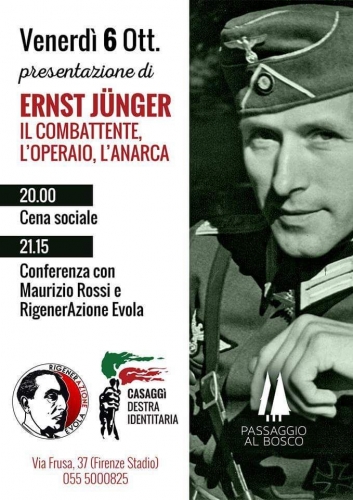
Lorsque la morale échappe au jugement du plus grand nombre, à l'utilitarisme de la classe dominante, elle paraît s'abolir dans une esthétique. Or, le Beau, pour Jünger, ce que la terminologie évolienne, et platonicienne, nomme la Forme (idéa) contient et réalise les plus hautes possibilités du Bien moral. Le Beau contient dans son exactitude, la justesse du Bien. L'esthétique ne contredit point la morale, elle en précise le contour, mieux, elle fait de la résistance au Mal qui est le propre de toute morale, une contre-attaque. Le Beau est un Bien en action, un Bien qui arrache la vie aux griffes du Léviathan et au règne des Titans. Jünger sur ce point ne varie pas . Dans son entretien séculaire, il dit à Franco Volpi: « Je dirai qu'éthique et esthétique se rencontrent et se touchent au moins sur un point: ce qui est vraiment beau est obligatoirement éthique, et ce qui est réellement éthique est obligatoirement beau. »
A ceux qui veulent opposer Jünger et Evola, il demeure d'autres arguments. Ainsi, il paraît fondé de voir en l'œuvre de Jünger, après Le Travailleur, une méditation constante sur la rébellion et la possibilité offerte à l'homme de se rendre hors d'atteinte de ce « plus froid des monstres froids », ainsi que Nietzsche nomme l'Etat. Au contraire, l'œuvre d'Evola poursuit avec non moins de constance l'approfondissement d'une philosophie politique destinée à fonder les normes et les possibilités de réalisation de « l'Etat vrai ». Cependant, ce serait là encore faire preuve d'un schématisme fallacieux que de se contenter de classer simplement Jünger parmi les « libertaires » fussent-ils « de droite » et Evola auprès des « étatistes ».
Si quelque vertu agissante, et au sens vrai, poétique, subsiste dans les oeuvres de Jünger et d'Evola les plus étroitement liées à des circonstances disparues ou en voie de disparition, c'est précisément car elles suivent des voies qui ne cessent de contredire les classifications, de poser d'autres questions au terme de réponses en apparence souveraines et sans appel. Un véritable auteur se reconnaît à la force avec laquelle il noue ensemble ses contradictions. C'est alors seulement que son œuvre échappe à la subjectivité et devient, dans le monde, une œuvre à la ressemblance du monde. L'œuvre poursuit son destin envers et contre les Abstracteurs qui, en nous posant de fausses alternatives visent en réalité à nous priver de la moitié de nous-mêmes. Les véritables choix ne sont pas entre la droite et la gauche, entre l'individu et l'Etat, entre la raison et l'irrationnel, c'est à dire d'ordre horizontal ou « latéral ». Les choix auxquels nous convient Jünger et Evola, qui sont bien des écrivains engagés, sont d'ordre vertical. Leurs œuvres nous font comprendre que, dans une large mesure, les choix horizontaux sont des leurres destinés à nous faire oublier les choix verticaux.

La question si controversée de l'individualisme peut servir ici d'exemple. Pour Jünger comme pour Evola, le triomphe du nihilisme, contre lequel il importe d'armer l'intelligence de la nouvelle chevalerie intellectuelle, est sans conteste l'individualisme libéral. Sous cette appellation se retrouvent à la fois l'utilitarisme bourgeois, honni par tous les grandes figures de la littérature du dix-neuvième siècle (Stendhal, Flaubert, Balzac, Villiers de L'Isle-Adam, Léon Bloy, Barbey d'Aurevilly, Théophile Gautier, Baudelaire, d'Annunzio, Carlyle etc...) mais aussi le pressentiment d'un totalitarisme dont les despotismes de naguère ne furent que de pâles préfigurations. L'individualisme du monde moderne est un « individualisme de masse », pour reprendre la formule de Jünger, un individualisme qui réduit l'individu à l'état d'unité interchangeable avec une rigueur à laquelle les totalitarismes disciplinaires, spartiates ou soviétiques, ne parvinrent jamais.
Loin d'opposer l'individualisme et le collectivisme, loin de croire que le collectivisme puisse redimer de quelque façon le néant de l'individualisme libéral, selon une analyse purement horizontale qui demeure hélas le seul horizon de nos sociologues, Jünger tente d'introduire dans la réflexion politique un en-decà et un au-delà de l'individu. Si l'individu « libéral » est voué, par la pesanteur même de son matérialisme à s'anéantir dans un en-deçà de l'individu, c'est-à-dire dans un collectivisme marchand et cybernétique aux dimensions de la planète, l'individu qui échappe au matérialisme, c'est-à-dire l'individu qui garde en lui la nostalgie d'une Forme possède, lui, la chance magnifique de se hausser à cet au-delà de l'individu, que Julius Evola nomme la Personne. Au delà de l'individu est la Forme ou, en terminologie jüngérienne, la Figure, qui permet à l'individu de devenir une Personne.
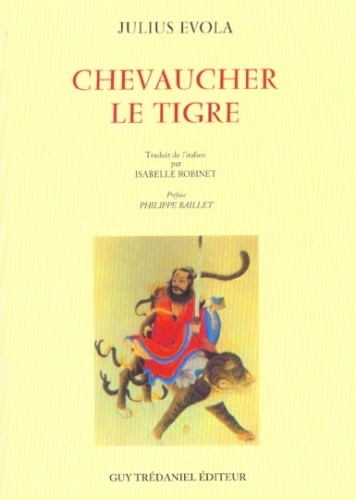 Qu'est-ce que la Figure ? La Figure, nous dit Jünger, est le tout qui englobe plus que la somme des parties. C'est en ce sens que la Figure échappe au déterminisme, qu'il soit économique ou biologique. L'individu du matérialisme libéral demeure soumis au déterminisme, et de ce fait, il appartient encore au monde animal, au « biologique ». Tout ce qui s'explique en terme de logique linéaire, déterministe, appartient encore à la nature, à l'en-deçà des possibilités surhumaines qui sont le propre de l'humanitas. « L'ordre hiérarchique dans le domaine de la Figure ne résulte pas de la loi de cause et d'effet, écrit Jünger mais d'une loi tout autre, celle du sceau et de l'empreinte. » Par ce renversement herméneutique décisif, la pensée de Jünger s'avère beaucoup plus proche de celle d'Evola que l'on ne pourrait le croire de prime abord. Dans le monde hiérarchique, que décrit Jünger où le monde obéit à la loi du sceau et de l'empreinte, les logiques évolutionnistes ou progressistes, qui s'obstinent (comme le nazisme ou le libéralisme darwinien) dans une vision zoologique du genre humain, perdent toute signification. Telle est exactement la Tradition, à laquelle se réfère toute l'œuvre de Julius Evola: « Pour comprendre aussi bien l'esprit traditionnel que la civilisation moderne, en tant que négation de cet esprit, écrit Julius Evola, il faut partir de cette base fondamentale qu'est l'enseignement relatif aux deux natures. Il y a un ordre physique et il y a un ordre métaphysique. Il y a une nature mortelle et il y a la nature des immortels. Il y a la région supérieure de l'être et il y a la région inférieure du devenir. D'une manière plus générale, il y a un visible et un tangible, et avant et au delà de celui-ci, il y a un invisible et un intangible, qui constituent le supra-monde, le principe et la véritable vie. Partout, dans le monde de la Tradition, en Orient et en Occident, sous une forme ou sous une autre, cette connaissance a toujours été présente comme un axe inébranlable autour duquel tout le reste était hiérarchiquement organisé. »
Qu'est-ce que la Figure ? La Figure, nous dit Jünger, est le tout qui englobe plus que la somme des parties. C'est en ce sens que la Figure échappe au déterminisme, qu'il soit économique ou biologique. L'individu du matérialisme libéral demeure soumis au déterminisme, et de ce fait, il appartient encore au monde animal, au « biologique ». Tout ce qui s'explique en terme de logique linéaire, déterministe, appartient encore à la nature, à l'en-deçà des possibilités surhumaines qui sont le propre de l'humanitas. « L'ordre hiérarchique dans le domaine de la Figure ne résulte pas de la loi de cause et d'effet, écrit Jünger mais d'une loi tout autre, celle du sceau et de l'empreinte. » Par ce renversement herméneutique décisif, la pensée de Jünger s'avère beaucoup plus proche de celle d'Evola que l'on ne pourrait le croire de prime abord. Dans le monde hiérarchique, que décrit Jünger où le monde obéit à la loi du sceau et de l'empreinte, les logiques évolutionnistes ou progressistes, qui s'obstinent (comme le nazisme ou le libéralisme darwinien) dans une vision zoologique du genre humain, perdent toute signification. Telle est exactement la Tradition, à laquelle se réfère toute l'œuvre de Julius Evola: « Pour comprendre aussi bien l'esprit traditionnel que la civilisation moderne, en tant que négation de cet esprit, écrit Julius Evola, il faut partir de cette base fondamentale qu'est l'enseignement relatif aux deux natures. Il y a un ordre physique et il y a un ordre métaphysique. Il y a une nature mortelle et il y a la nature des immortels. Il y a la région supérieure de l'être et il y a la région inférieure du devenir. D'une manière plus générale, il y a un visible et un tangible, et avant et au delà de celui-ci, il y a un invisible et un intangible, qui constituent le supra-monde, le principe et la véritable vie. Partout, dans le monde de la Tradition, en Orient et en Occident, sous une forme ou sous une autre, cette connaissance a toujours été présente comme un axe inébranlable autour duquel tout le reste était hiérarchiquement organisé. »
Affirmer, comme le fait Jünger, la caducité de la logique de cause et d'effet, c'est, dans l'ordre d'une philosophie politique rénovée, suspendre la logique déterministe et tout ce qui en elle plaide en faveur de l'asservissement de l'individu. « On donnera le titre de Figure, écrit Jünger, au genre de grandeur qui s'offrent à un regard capable de concevoir que le monde peut être appréhendé dans son ensemble selon une loi plus décisive que celle de la cause et de l'effet. » Du rapport entre le sceau invisible et l'empreinte visible dépend tout ce qui dans la réalité relève de la qualité. Ce qui n'a point d'empreinte, c'est la quantité pure, la matière livrée à elle-même. Le sceau est ce qui confère à l'individu, à la fois la dignité et la qualité. En ce sens, Jünger, comme Evola, pense qu'une certaine forme d'égalitarisme revient à nier la dignité de l'individu, à lui ôter par avance toute chance d'atteindre à la dignité et à la qualité d'une Forme. « On ne contestera pas, écrit Julius Evola, que les êtres humains, sous certains aspects, soient à peu près égaux; mais ces aspects, dans toute conception normale et traditionnelle, ne représentent pas le "plus" mais le "moins", correspondent au niveau le plus pauvre de la réalité, à ce qu'il y a de moins intéressant en nous. Il s'agit d'un ordre qui n'est pas encore celui de la forme, de la personnalité au sens propre. Accorder de la valeur à ces aspects, les mettre en relief comme si on devait leur donner la priorité, équivaudrait à tenir pour essentiel que ces statues soient en bronze et non que chacune soit l'expression d'une idée distincte dont le bronze ( ici la qualité générique humaine) n'est que le support matériel. »

Ce platonisme que l'on pourrait dire héroïque apparaît comme un défi à la doxa moderne. Lorsque le moderne ne vante la « liberté » que pour en anéantir toute possibilité effective dans la soumission de l'homme à l'évolution, au déterminisme, à l'histoire, au progrès, l'homme de la Tradition, selon Evola, demeure fidèle à une vision supra-historique. De même, contrairement à ce que feignent de croire des exégètes peu informés, le « réalisme héroïque » des premières œuvres de Jünger loin de se complaire dans un immanentisme de la force et de la volonté, est un hommage direct à l'ontologie de la Forme, à l'idée de la préexistence. « La Figure, écrit Jünger, dans Le Travailleur, est, et aucune évolution ne l'accroît ni ne la diminue. De même que la Figure de l'homme précédait sa naissance et survivra à sa mort, une Figure historique est, au plus profond d'elle-même, indépendante du temps et des circonstances dont elle semble naître. Les moyens dont elle dispose sont supérieurs, sa fécondité est immédiate. L'histoire n'engendre pas de figures, elle se transforme au contraire avec la Figure. »
Sans doute le jugement d'Evola, qui tout en reconnaissant la pertinence métapolitique de la Figure du Travailleur n'en critique pas moins l'ouvrage de Jünger comme dépourvu d'une véritable perspective métaphysique, peut ainsi être nuancée. Jünger pose bien, selon une hiérarchie métaphysique, la distinction entre l'individu susceptible d'être massifié (qu'il nomme dans Le Travailleur « individuum ») et l'individu susceptible de recevoir l'empreinte d'une Forme supérieure (et qu'il nomme « Einzelne »). Cette différenciation terminologique verticale est incontestablement l'ébauche d'une métaphysique, quand bien même, mais tel n'est pas non plus le propos du Travailleur, il n'y est pas question de cet au-delà de la personne auquel invitent les métaphysiques traditionnelles, à travers les œuvres de Maître Eckhart ou du Védantâ. De même qu'il existe un au-delà et un en-deçà de l'individu, il existe dans un ordre plus proche de l'intangible un au-delà et un en-deçà de la personne. Le « dépassement » de l'individu, selon qu'il s'agit d'un dépassement par le bas ou par le haut peut aboutir aussi bien, selon son orientation, à la masse indistincte qu'à la formation de la Personne. Le dépassement de la personne, c'est-à-dire l'impersonnalité, peut, selon Evola, se concevoir de deux façons opposées: « l'une se situe au-dessous, l'autre au niveau de la personne; l'une aboutit à l'individu, sous l'aspect informe d'une unité numérique et indifférente qui, en se multipliant, produit la masse anonyme; l'autre est l'apogée typique d'un être souverain, c'est la personne absolue. »
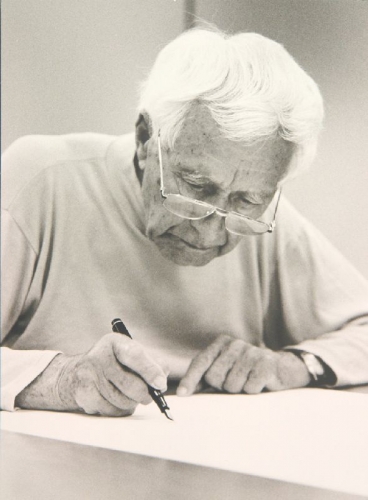
Loin d'abonder dans le sens d'une critique sommaire et purement matérialiste de l'individualisme auquel n'importe quelle forme d'étatisme ou de communautarisme devrait être préféré aveuglément, le gibelin Julius Evola, comme l'Anarque jüngérien se rejoignent dans la méditation d'un ordre qui favoriserait « l'apogée typique d'un être souverain ». Il est exact de dire, précise Evola, « que l'état et le droit représentent quelque chose de secondaire par rapport à la qualité des hommes qui en sont les créateurs, et que cet Etat, ce droit ne sont bons que dans le mesure où ils restent des formes fidèles aux exigences originelles et des instruments capables de consolider et de confirmer les forces mêmes qui leur ont donné naissance. » La critique évolienne de l'individualisme, loin d'abonder dans le sens d'une mystique de l'élan commun en détruit les fondements mêmes. Rien, et Julius Evola y revient à maintes reprises, ne lui est aussi odieux que l'esprit grégaire: « Assez du besoin qui lie ensemble les hommes mendiant au lien commun et à la dépendance réciproque la consistance qui fait défaut à chacun d'eux ! »
Pour qu'il y eût un Etat digne de ce nom, pour que l'individu puisse être dépassé, mais par le haut, c'est-à-dire par une fidélité métaphysique, il faut commencer par s'être délivré de ce besoin funeste de dépendance. Ajoutées les unes aux autres les dépendances engendrent l'odieux Léviathan, que Simone Weil nommait « le gros animal », ce despotisme du Médiocre dont le vingtième siècle n'a offert que trop d'exemples. Point d'Etat légitime, et point d'individu se dépassant lui-même dans une généreuse impersonnalité active, sans une véritable Sapience, au sens médiéval, c'est-à-dire une métaphysique de l'éternelle souveraineté. « La part inaliénable de l'individu (Einzelne) écrit Jünger, c'est qu'il relève de l'éternité, et dans ses moments suprêmes et sans ambiguïté, il en est pleinement conscient. Sa tâche est d'exprimer cela dans le temps. En ce sens, sa vie devient une parabole de la Figure. » Evola reconnaît ainsi « en certains cas la priorité de la personne même en face de l'Etat », lorsque la personne porte en elle, mieux que l'ensemble, le sens et les possibilités créatrices de la Sapience.
Quelles que soient nos orientations, nos présupposés philosophiques ou littéraires, aussitôt sommes-nous requis par quelque appel du Grand Large qui nous incline à laisser derrière nous, comme des écorces mortes, le « trop humain » et les réalités confinées de la subjectivité, c'est à la Sapience que se dédient nos pensées. Du précepte delphique « Connais-toi toi-même et tu connaîtras le monde et les dieux », les œuvres de Jünger et d'Evola éveillent les pouvoirs en redonnant au mot de « réalité » un sens que lui avaient ôté ces dernières générations de sinistres et soi-disant « réalistes »: « ll est tellement évident que le caractère de "réalité" a été abusivement monopolisé par ce qui, même dans la vie actuelle, n'est qu'une partie de la réalité totale, que cela ne vaut pas la peine d'y insister davantage» écrit Julius Evola. La connaissance de soi-même ne vaut qu'en tant que connaissance réelle du monde. Se connaître soi-même, c'est connaître le monde et les dieux car dans cette forme supérieure de réalisme que préconisent Jünger et Evola: « le réel est perçu dans un état où il n'y a pas de sujet de l'expérience ni d'objet expérimenté, un état caractérisé par une sorte de présence absolue où l'immanent se fait transcendant et le transcendant immanent. » Et sans doute est-ce bien en préfiguration de cette expérience-limite que Jünger écrit: « Et si nous voulons percevoir le tremblement du cœur jusque dans ses plus subtiles fibrilles, nous exigeons en même temps qu'il soit trois fois cuirassé. »

Foi et chevalerie sont les conditions préalables et nécessaires de la Sapience, et c'est précisément en quoi la Sapience se distingue de ce savoir banal et parfois funeste dont les outrecuidants accablent les simples. La Sapience advient, elle ne s'accumule, ni ne se décrète. Elle couronne naturellement des types humains dont les actes et les pensées sont orientés vers le Vrai, le Beau et le Bien, c'est-à-dire qu'elle vibre et claque au vent de l'Esprit. La Sapience n'est pas cette petite satisfaction du clerc qui croit se suffire à lui-même. La Sapience ne vaut qu'en tant que défi au monde, et il vaut mieux périr de ce défi que de tirer son existence à la ligne comme un mauvais feuilletoniste. Les stances du Dhammapada, attribué au Bouddha lui-même ne disent pas autre chose: "« Plutôt vivre un jour en considérant l'apparition et la disparition que cent ans sans les voir."
Le silence et la contemplation de la Sapience sont vertige et éblouissement et non point cette ignoble recherche de confort et de méthodes thérapeutiques dont les adeptes du « new-age » parachèvent leur arrogance technocratique. « L'Occident ne connaît plus la Sapience, écrit Evola: il ne connaît plus le silence majestueux des dominateurs d'eux-mêmes, le calme illuminé des Voyants, la superbe réalité de ceux chez qui l'idée s'est faite sang, vie, puissance... A la Sapience ont succédé la contamination sentimentale, religieuse, humanitaire, et la race de ceux qui s'agitent en caquetant et courent, ivres, exaltant le devenir et la pratique, parce que le silence et la contemplation leur font peur. »
Le moderne, qui réclame sans cesse de nouveaux droits, mais se dérobe à tous les devoirs, hait la Sapience car, analogique et ascendante, elle élargit le champ de sa responsabilité. L'irresponsable moderne qui déteste la liberté avec plus de hargne que son pire ennemi ( si tant est qu'il eût encore assez de cœur pour avoir un ennemi) ne peut voir en la théorie des correspondances qu'une menace à peine voilée adressée à sa paresse et à son abandon au courant d'un « progrès » qui entraîne, selon la formule de Léon Bloy, « comme un chien mort au fil de l'eau ». Rien n'est plus facile que ce nihilisme qui permet de se plaindre de tout, de revendiquer contre tout sans jamais se rebeller contre rien. L'insignifiance est l'horizon que se donne le moderne, où il enferme son cœur et son âme jusqu'à l'a asphyxie et l'étiolement. « L'homme qui attribue de la valeur à ses expériences, écrit Jünger, quelles qu'elles soient, et qui, en tant que parties de lui-même ne veut pas les abandonner au royaume de l'obscurité, élargit le cercle de sa responsabilité. » C'est en ce sens précis que le moderne, tout en nous accablant d'un titanisme affreux, ne vénère dans l'ordre de l'esprit que la petitesse, et que toute recherche de grandeur spirituelle lui apparaît vaine ou coupable.
 Nous retrouvons dans les grands paysages intérieurs que décrit Jünger dans Héliopolis, ce goût du vaste, de l'ampleur musicale et chromatique où l'invisible et le visible correspondent. Pour ce type d'homme précise Evola: « il n'y aura pas de paysages plus beaux, mais des paysages plus lointains, plus immenses, plus calmes, plus froids, plus durs, plus primordiaux que d'autres: Le langage des choses du monde ne nous parvient pas parmi les arbres, les ruisseaux, les beaux jardins, devant les couchers de soleil chromos ou de romantiques clairs de lune mais plutôt dans les déserts, les rocs, les steppes, les glaces, les noirs fjords nordiques, sous les soleils implacables des tropiques- précisément dans tout ce qui est primordial et inaccessible. » La Sapience alors est l'éclat fulgurant qui transfigure le cœur qui s'est ouvert à la Foi et à la Chevalerie quand bien même, écrit Evola: « le cercle se resserre de plus en plus chaque jour autour des rares êtres qui sont encore capables du grand dégoût et de la grande révolte. » Sapience de poètes et de guerriers et non de docteurs, Sapience qui lève devant elle les hautes images de feu et de gloire qui annoncent les nouveaux règnes !
Nous retrouvons dans les grands paysages intérieurs que décrit Jünger dans Héliopolis, ce goût du vaste, de l'ampleur musicale et chromatique où l'invisible et le visible correspondent. Pour ce type d'homme précise Evola: « il n'y aura pas de paysages plus beaux, mais des paysages plus lointains, plus immenses, plus calmes, plus froids, plus durs, plus primordiaux que d'autres: Le langage des choses du monde ne nous parvient pas parmi les arbres, les ruisseaux, les beaux jardins, devant les couchers de soleil chromos ou de romantiques clairs de lune mais plutôt dans les déserts, les rocs, les steppes, les glaces, les noirs fjords nordiques, sous les soleils implacables des tropiques- précisément dans tout ce qui est primordial et inaccessible. » La Sapience alors est l'éclat fulgurant qui transfigure le cœur qui s'est ouvert à la Foi et à la Chevalerie quand bien même, écrit Evola: « le cercle se resserre de plus en plus chaque jour autour des rares êtres qui sont encore capables du grand dégoût et de la grande révolte. » Sapience de poètes et de guerriers et non de docteurs, Sapience qui lève devant elle les hautes images de feu et de gloire qui annoncent les nouveaux règnes !
« Nos images, écrit Jünger, résident dans ces lointains plus écartés et plus lumineux où les sceaux étrangers ont perdu leur validité, et le chemin qui mène à nos fraternités les plus secrètes passe par d'autres souffrances. Et notre croix a une solide poignée, et une âme forgée dans un acier à double tranchant. » La Sapience surgit sur les chemins non de la liberté octroyée, mais de la liberté conquise. « C'est plutôt le héros lui-même, écrit Jünger, qui par l'acte de dominer et de se dominer, aide tous les autres en permettant à l'idée de liberté de triompher... »
 Dans l'œil du cyclone, dans la sérénité retrouvée, telle qu'elle déploie son imagerie solaire à la fin de La Visite à Godenholm, une fois que sont vaincus, dans le corps et dans l'âme, les cris des oiseaux de mauvais augure du nihilisme, L'Anarque jüngérien, à l'instar de l'homme de la Tradition évolien, peut juger l'humanisme libéral et le monde moderne, non pour ce qu'ils se donnent, dans une propagande titanesque, mais pour ce qu'ils sont: des idéologies de la haine de toute forme de liberté accomplie. Que faut-il comprendre par liberté accomplie ? Disons une liberté qui non seulement se réalise dans les actes et dans les œuvres mais qui trouve sa raison d'être dans l'ordre du monde. « Libre ? Pour quoi faire ? » s'interrogeait Nietzsche. A l'évidence, une liberté qui ne culmine point en un acte poétique, une liberté sans « faire » n'est qu'une façon complaisante d'accepter l'esclavage. L'Anarque et l'homme de la Tradition récusent l'individualisme libéral car celui-ci leur paraît être, en réalité, la négation à la fois de l'Individu et de la liberté. Lorsque Julius Evola rejoint, non sans y apporter ses nuances gibelines et impériales, la doctrine traditionnelle formulée magistralement par René Guénon, il ne renonce pas à l'exigence qui préside à sa Théorie de l'Individu absolu, il en trouve au contraire, à travers les ascèses bouddhistes, alchimiques ou tantriques, les modes de réalisation et cette sorte de pragmatique métaphysique qui tant fait défaut au discours philosophique occidental depuis Kant. « C'est que la liberté n'admet pas de compromis: ou bien on l'affirme, ou bien on ne l'affirme pas. Mais si on l'affirme, il faut l'affirmer sans peur, jusqu'au bout, - il faut l'affirmer, par conséquent, comme liberté inconditionnée. » Seul importe au regard métaphysique ce qui est sans condition. Mais un malentendu doit être aussitôt dissipé. Ce qui est inconditionné n'est pas à proprement parler détaché ou distinct du monde. Le « sans condition » est au cœur. Mais lorsque selon les terminologies platoniciennes ou théologiques on le dit « au ciel » ou « du ciel », il faut bien comprendre que ce ciel est au coeur.
Dans l'œil du cyclone, dans la sérénité retrouvée, telle qu'elle déploie son imagerie solaire à la fin de La Visite à Godenholm, une fois que sont vaincus, dans le corps et dans l'âme, les cris des oiseaux de mauvais augure du nihilisme, L'Anarque jüngérien, à l'instar de l'homme de la Tradition évolien, peut juger l'humanisme libéral et le monde moderne, non pour ce qu'ils se donnent, dans une propagande titanesque, mais pour ce qu'ils sont: des idéologies de la haine de toute forme de liberté accomplie. Que faut-il comprendre par liberté accomplie ? Disons une liberté qui non seulement se réalise dans les actes et dans les œuvres mais qui trouve sa raison d'être dans l'ordre du monde. « Libre ? Pour quoi faire ? » s'interrogeait Nietzsche. A l'évidence, une liberté qui ne culmine point en un acte poétique, une liberté sans « faire » n'est qu'une façon complaisante d'accepter l'esclavage. L'Anarque et l'homme de la Tradition récusent l'individualisme libéral car celui-ci leur paraît être, en réalité, la négation à la fois de l'Individu et de la liberté. Lorsque Julius Evola rejoint, non sans y apporter ses nuances gibelines et impériales, la doctrine traditionnelle formulée magistralement par René Guénon, il ne renonce pas à l'exigence qui préside à sa Théorie de l'Individu absolu, il en trouve au contraire, à travers les ascèses bouddhistes, alchimiques ou tantriques, les modes de réalisation et cette sorte de pragmatique métaphysique qui tant fait défaut au discours philosophique occidental depuis Kant. « C'est que la liberté n'admet pas de compromis: ou bien on l'affirme, ou bien on ne l'affirme pas. Mais si on l'affirme, il faut l'affirmer sans peur, jusqu'au bout, - il faut l'affirmer, par conséquent, comme liberté inconditionnée. » Seul importe au regard métaphysique ce qui est sans condition. Mais un malentendu doit être aussitôt dissipé. Ce qui est inconditionné n'est pas à proprement parler détaché ou distinct du monde. Le « sans condition » est au cœur. Mais lorsque selon les terminologies platoniciennes ou théologiques on le dit « au ciel » ou « du ciel », il faut bien comprendre que ce ciel est au coeur.
L'inconditionné n'est pas hors de la périphérie, mais au centre. C'est au plus près de soi et du monde qu'il se révèle. D'où l'importance de ce que Jünger nomme les « approches ». Plus nous sommes près du monde dans son frémissement sensible, moins nous sommes soumis aux généralités et aux abstractions idéologiques, et plus nous sommes près des Symboles. Car le symbole se tient entre deux mondes. Ce monde de la nature qui flambe d'une splendeur surnaturelle que Jünger aperçoit dans la fleur ou dans l'insecte, n'est pas le monde d'un panthéiste, mais le monde exactement révélé par l'auguste science des symboles. « La science des symboles, rappelle Luc Benoist, est fondée sur la correspondance qui existe entre les divers ordres de réalité, naturelle et surnaturelle, la naturelle n'étant alors considérée que comme l'extériorisation du surnaturel. » La nature telle que la perçoivent Jünger et Evola (celui-ci suivant une voie beaucoup plus « sèche ») est bien la baudelairienne et swedenborgienne « forêt de symboles ». Elle nous écarte de l'abstraction en même temps qu'elle nous rapproche de la métaphysique. « La perspective métaphysique, qui vise à dépasser l'abstraction conceptuelle, trouve dans le caractère intuitif et synthétique du symbole en général et du Mythe en particulier un instrument d'expression particulièrement apte à véhiculer l'intuition intellectuelle. »écrit George Vallin. Les grandes imageries des Falaises de Marbre, d'Héliopolis, les récits de rêves, des journaux et du Cœur aventureux prennent tout leur sens si on les confronte à l'aiguisement de l'intuition intellectuelle. Jünger entre en contemplation pour atteindre cette liberté absolue qui est au cœur des mondes, ce moyeu immobile de la roue, qui ne cessera jamais de tourner vertigineusement. Dans ce que George Vallin nomme l'intuition intellectuelle, l'extrême vitesse et l'extrême immobilité se confondent. Le secret de la Sapience, selon Evola: « cette virtu qui ne parle pas, qui naît dans le silence hermétique et pythagoricien, qui fleurit sur la maîtrise des sens et de l'âme » est au cœur des mondes comme le signe de la « toute-possibilité » . Tout ceci, bien sûr, ne s'adressant qu'au lecteur aimé de Jünger: « ce lecteur dont je suppose toujours qu'il est de la trempe de Don Quichotte et que, pour ainsi dire, il tranche les airs en lisant à grands coups d'épée. »
Luc-Olivier d'Algange.
19:00 Publié dans Littérature, Philosophie, Révolution conservatrice, Traditions | Lien permanent | Commentaires (0) | Tags : littérature, littérature allemande, lettres, lettres allemandes, ernst jünger, julius evola, philosophie, traditionalisme, tradition, allemagne, italie, luc-olivier d'algange |  |
|  del.icio.us |
del.icio.us |  |
|  Digg |
Digg | ![]() Facebook
Facebook
vendredi, 08 janvier 2021
Du nécessaire révisionnisme de la tradition

Du nécessaire révisionnisme de la tradition
Par Carlos Salazar, président de la CPECI - Chili
Ex: https://therevolutionaryconservative.com
Traduit par Zero Schizo
Il y a deux façons de comprendre ce qu'est la tradition. Il y a ceux qui considèrent la tradition comme une sorte de conservation muséologique des rites, usages, pratiques, coutumes, morales, principes anciens, etc. Autrement dit, ceux qui cherchent à préserver l'ordre des choses de telle sorte que tout reste pour ainsi dire inchangé ou pétrifié. Ce genre de conservateurs rétrogrades est, dès à présent, à la fois un handicap et un obstacle pour le mouvement nationaliste. Certains adoptent même une position rétrograde, hallucinant avec le retour du Moyen-Âge, de la féodalité, ou dans leur vision créole, du système Encomienda et des chastes races. Selon Malher, ces "traditionalistes" ont préféré garder les cendres et ont cessé d'alimenter le feu vivant de la vraie tradition.
Cette véritable tradition, en revanche, est présente dans la vie quotidienne des secteurs populaires de la nation. Benjamin Vicuña Mackenna dirait : "Cette obscure tradition, qui se projette dans la vie de tous les pays et de toutes les races comme si elle était sa propre ombre, c'est l'histoire du peuple ; du peuple-soldat, du peuple-paysan, du peuple-guérilla, du peuple en somme, grossier et ignorant, mais grand dans ses croyances, et que, s'il n'est pas philosophe, il est un héros, et s'il n'est pas apôtre, il est un martyr".
La vraie tradition ne se trouve pas dans les fétiches pseudo-médiévaux de la "messe tridentine" (on sait aussi que le soi-disant "traditionalisme catholique" ou "gauchisme" est un phénomène très moderne), mais plutôt qu'elle est présente dans la petite vie communautaire qui existe dans les rues de Santiago, ou dans la vie quotidienne des citadins des régions intérieures du pays. Il y a beaucoup plus de tradition dans la Vega centrale que dans tous les musées d'histoire du pays.
Nous voyons donc déjà que le révolutionnaire n'est pas l'ennemi de la tradition, mais qu'au lieu de ces contrariétés séniles qui se qualifient de "traditionalistes", ceux-ci ne sont rien d'autre que des fétichistes et sont en pratique des conservateurs pour l'ordre libéral dominant. Quand aujourd'hui quelqu'un me dit qu'il est "conservateur", je lui demande : alors, que voulez-vous conserver ? Il n'y aura jamais de réponse honnête car dans le Chili d'aujourd'hui, il n'y a presque rien à conserver. Le libéralisme a réussi à dissoudre une grande partie de ce qui avait de la valeur pour notre communauté nationale, et les traditions qui sont encore vivantes, réussissent à le faire malgré la gestion de l'oligarchie chilienne "bien-pensante" et cosmopolite, celle qui, de temps en temps, dans des occasions très spécifiques et de façon paradoxale, aime faire la guerre aux résidus et aux ornements "traditionalistes". Citant l'universitaire américain Charles Taylor : "les conservateurs de droite se posent en défenseurs des communautés traditionnelles lorsqu'ils s'attaquent à l'avortement et à la pornographie, mais dans leur façon de faire économique, ils défendent une manière sauvage d'incision capitaliste, qui a surtout contribué à dissoudre les communautés historiques, à promouvoir l'atomisme, qui ne connaît pas de frontières ni de loyautés et qui est prêt à fermer une ville minière ou à abattre une forêt sur la base d'un équilibre économique".
Le révolutionnaire, au contraire, prend le meilleur de la tradition vivante et le projette dans l'avenir, ne cherchant jamais à revenir au passé, mais au contraire il avance en progressant vers une dépassement des vieilles erreurs et un avenir de bien-être. Pendant la Révolution française, il y a eu une référence et une invocation au passé républicain de la Rome antique, de même que cela a été repris dans la Révolution bolchevique en Russie. Ainsi, le révisionnisme de la tradition est un exemple clair de ce que nous appelons l'archéofuturisme, c'est-à-dire la combinaison d'éléments à la fois archaïques et futuristes. Il est aujourd'hui présent en RPDC, en Chine, comme il l'a été pendant un certain temps en URSS, en Roumanie et en Albanie, pour ne citer que quelques exemples.
Plus clairs encore sont les exemples des stars de la tradition populaire chilienne, Violeta Parra et Victor Jara, compilateurs et créateurs d'un véritable art traditionnel et révolutionnaire, tous deux dotés d'un sens patriotique profond et ancré dans le sol, tous deux militant sincèrement pour la justice et la rébellion contre les oligarques. Et tous deux, forgeurs de leur propre tradition qui reste vivante jusqu'à nos jours.
"Celui qui ne peut pas imaginer l'avenir, ne peut pas non plus imaginer le passé", dirait Mariategui. Ensuite, l'Amauta a écrit sur ce même sujet il y a environ plus d'un siècle : "Il n'y a donc pas de conflit réel entre le révolutionnaire et la tradition, mais plutôt une hostilité contre ceux qui conçoivent la tradition comme une momie ou un musée. La lutte n'est efficace qu'avec l’appui du traditionalisme. Les révolutionnaires incarnent la volonté de la société de ne pas se pétrifier dans un statut, de ne pas s'immobiliser dans une attitude. Parfois, la société perd cette volonté créative, paralysée par une sensation d'achèvement ou de désenchantement. Mais alors son vieillissement et son déclin se confirmeront inexorablement.
« La tradition de cette époque est faite par ceux qui semblent parfois nier, iconoclastes, toute tradition. De leur part, elle est, pour le moins, la partie active. Sans eux, la société accuserait l'abandon ou l'abdication de la volonté de vivre en se renouvelant et en se surpassant constamment ». (Mariategui, Hétérodoxie de la tradition)
Source
SALAZAR, Carlos. "Columna de Opinión Internacional (Chile) del 24.06.2020". Diario La Verdad. Lima, Pérou.
Disponible sur le site : https://comitecentralameri.wixsite.com/ccla/post/revisionismo-de-la-tradici%C3%B3n
00:02 Publié dans Actualité, Définitions, Nouvelle Droite, Traditions | Lien permanent | Commentaires (0) | Tags : traditionalisme révolutionnaire, tradition, définition |  |
|  del.icio.us |
del.icio.us |  |
|  Digg |
Digg | ![]() Facebook
Facebook
lundi, 04 janvier 2021
La correspondance entre Julius Evola et Gottfried Benn
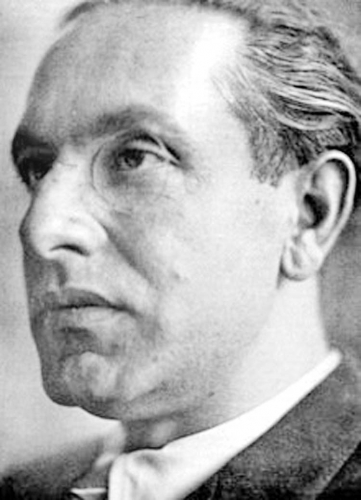

La correspondance entre Julius Evola et Gottfried Benn
Par Gianfranco de Turris
Ex : http://www.centrostudilaruna.it
L'accusation la plus cinglante que l'intelligentsia officielle lance contre Julius Evola est d'être un "nazi", plutôt que d'avoir été (comme d'innombrables autres hommes de culture italienne) un "fasciste". Une accusation évidente et prévisible, mais superficielle, qui se fonde sur certaines apparences : son bagage culturel qui s'inspire d'une certaine philosophie allemande (à commencer par Nietzsche) ; son caractère plus "allemand" qu'"italien" ; son intérêt entre les deux guerres pour faire connaître une certaine culture germanophone dans notre pays (de Bachofen à Spengler et Meyrink) ; ses contacts avec l'Allemagne du IIIe Reich ; le souvenir de sa rencontre avec Himmler, de sa visite aux châteaux de l'Ordre, des conférences dans des milieux aussi divers que le Herrenklub d'une part et les SS d'autre part ; le fait d'avoir écrit des articles sur la politique étrangère, intérieure, culturelle et économique de l'Allemagne nationale-socialiste et sur les SS eux-mêmes (articles dont on se souvient de l'appréciation éventuelle mais pas de ses innombrables réserves critiques) ; etc. De tout ce contexte, les auditeurs tirent l'étiquette de "nazi" : ils vont rarement aux sources et ne les lisent jamais dans leur ensemble, à partir au moins de 1930, avec des articles et des essais dans "Vita Nova" et "Nuova Antologia", jusqu'aux interventions dans "Il Regime Fascista", "Lo Stato" et "La Vita Italiana" en mai-juillet 1943.
Une vision aristocratique
 Julius Evola n'était ni "fasciste" ni "antifasciste" (comme il l'écrivait de façon polémique dans sa revue bimensuelle "La Torre" au début de 1930), et par conséquent il n'était ni "nazi" ni "anti-nazi" : était-il alors un incertain, un attentiste, un hypocrite, un - comme on le dit en Italie - "un poisson dans un tonneau" ? Non: il a accepté les idées, les thèses, les positions, les attitudes et les choix pratiques du fascisme, et donc du nazisme, qui étaient en accord avec ceux d'une droite traditionnelle et, plus tard, de ce que l'on a appelé la révolution conservatrice allemande. Une vision qui était à l'époque gibeline, impériale, aristocratique, qui - même si elle est "utopique" - l'éloignait certes de la Weltanschauung populiste "démocratique" et "plébéienne" du fascisme mais surtout du nazisme, dont le matérialisme biologique lui était totalement insupportable. Il ne s'agit pas de justifications a posteriori, comme quelqu'un l'a malicieusement pensé en lisant les pages de Il cammino del cinabro (1963), car Evola n'est pas ce qu'on appelle aujourd'hui un "repenti" : il n'a jamais rien répudié ni rejeté de son passé ; même s'il a rectifié et pris ses distances par rapport à certaines de ses positions de jeunesse (tout le monde oublie ce qu'il a écrit sur l'impérialisme païen en 1928 : "Dans le livre, dans la mesure où il suivait - je dois le reconnaître - l'impulsion d'une pensée radicaliste faisant usage d'un style violent, il était typique d’une absence juvénile de mesure et de sens politique et à une utopique inconscience de l'état des choses" : non pas "le repentir" mais la maturation logique d'un homme de pensée). Le fait que ce ne sont pas des justifications est démontré par les documents qui, au fil des ans, après sa mort en 1974, sont lentement apparus dans les archives publiques et privées italiennes et allemandes. D'eux émerge un Julius Evola qui était tout sauf "organique au régime" comme on l'a écrit, mais même pas aussi marginal qu'on le croyait : un essayiste, journaliste, polémiste, conférencier, qui a connu des hauts et des bas et qui, après la crise de 1930 avec l’interdiction de "La Torre" et sa marginalisation, a accepté de se rapprocher de personnalités comme Giovanni Preziosi, Roberto Farinacci, Italo Balbo, c'est-à-dire, on pourrait dire, les fascistes les plus "révolutionnaires" et les plus "intransigeants", afin d'exprimer ses idées critiques à l'abri de ces niches, agissant comme une sorte de "cinquième colonne" traditionaliste pour tenter l'entreprise utopique de "rectifier" le Régime dans ce sens : Il commence donc à écrire à partir de mars 1931 dans "La Vita Italiana", à partir de janvier 1933 dans "Il Corriere Padano" et "Il Regine Fascista", puis - sortant du "ghetto" des disgraciés - à partir d'avril 1933 dans "La Rassegna Italiana", à partir de février 1934 dans la revue d’inspiration autoritaire "Lo Stato" et dans "Roma", à partir de mars 1934 dans "Bibliografia Fascista".
Julius Evola n'était ni "fasciste" ni "antifasciste" (comme il l'écrivait de façon polémique dans sa revue bimensuelle "La Torre" au début de 1930), et par conséquent il n'était ni "nazi" ni "anti-nazi" : était-il alors un incertain, un attentiste, un hypocrite, un - comme on le dit en Italie - "un poisson dans un tonneau" ? Non: il a accepté les idées, les thèses, les positions, les attitudes et les choix pratiques du fascisme, et donc du nazisme, qui étaient en accord avec ceux d'une droite traditionnelle et, plus tard, de ce que l'on a appelé la révolution conservatrice allemande. Une vision qui était à l'époque gibeline, impériale, aristocratique, qui - même si elle est "utopique" - l'éloignait certes de la Weltanschauung populiste "démocratique" et "plébéienne" du fascisme mais surtout du nazisme, dont le matérialisme biologique lui était totalement insupportable. Il ne s'agit pas de justifications a posteriori, comme quelqu'un l'a malicieusement pensé en lisant les pages de Il cammino del cinabro (1963), car Evola n'est pas ce qu'on appelle aujourd'hui un "repenti" : il n'a jamais rien répudié ni rejeté de son passé ; même s'il a rectifié et pris ses distances par rapport à certaines de ses positions de jeunesse (tout le monde oublie ce qu'il a écrit sur l'impérialisme païen en 1928 : "Dans le livre, dans la mesure où il suivait - je dois le reconnaître - l'impulsion d'une pensée radicaliste faisant usage d'un style violent, il était typique d’une absence juvénile de mesure et de sens politique et à une utopique inconscience de l'état des choses" : non pas "le repentir" mais la maturation logique d'un homme de pensée). Le fait que ce ne sont pas des justifications est démontré par les documents qui, au fil des ans, après sa mort en 1974, sont lentement apparus dans les archives publiques et privées italiennes et allemandes. D'eux émerge un Julius Evola qui était tout sauf "organique au régime" comme on l'a écrit, mais même pas aussi marginal qu'on le croyait : un essayiste, journaliste, polémiste, conférencier, qui a connu des hauts et des bas et qui, après la crise de 1930 avec l’interdiction de "La Torre" et sa marginalisation, a accepté de se rapprocher de personnalités comme Giovanni Preziosi, Roberto Farinacci, Italo Balbo, c'est-à-dire, on pourrait dire, les fascistes les plus "révolutionnaires" et les plus "intransigeants", afin d'exprimer ses idées critiques à l'abri de ces niches, agissant comme une sorte de "cinquième colonne" traditionaliste pour tenter l'entreprise utopique de "rectifier" le Régime dans ce sens : Il commence donc à écrire à partir de mars 1931 dans "La Vita Italiana", à partir de janvier 1933 dans "Il Corriere Padano" et "Il Regine Fascista", puis - sortant du "ghetto" des disgraciés - à partir d'avril 1933 dans "La Rassegna Italiana", à partir de février 1934 dans la revue d’inspiration autoritaire "Lo Stato" et dans "Roma", à partir de mars 1934 dans "Bibliografia Fascista".
Surveillance spéciale
Malgré cela, Evola était constamment surveillé par la police politique, tant en Italie qu'à l'étranger : sa correspondance était lue, ses amis identifiés (même ses petites amies), ses déclarations étaient confidentielles, son passeport lui a été retiré à plusieurs reprises en raison des propos très peu orthodoxes qu'il a tenus sur le fascisme et le nazisme lors de ses conférences en Allemagne et en Autriche. Comme il ressort clairement des documents désormais publiés des ministères des affaires étrangères et de l'intérieur du Reich et de ceux provenant de l'Ahnenerbe, il était à peine toléré : il n'était pas un véritable ennemi, mais ses idées n'étaient pas appréciées par la direction nationale-socialiste, étant donné qu'il était considéré comme un "Romain réactionnaire" qui aspirait à "élever l'aristocratie" et n'acceptait pas beaucoup la référence allemande au "sang et au sol".
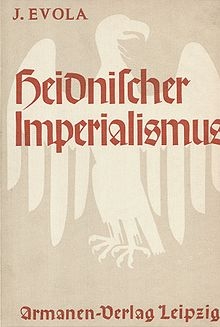 Une adhésion très critique, donc, celle de Julius Evola, de manière à ne pas pouvoir le définir de manière simpliste ni comme un "fasciste", ni comme un "nazi" de droit. Son point de référence était plutôt la Révolution conservatrice et ses représentants de l'époque. Écoutons ses propres mots extraits de Le Chemin du Cinabre : "Déjà l'édition allemande de mon Impérialisme païen, où les idées de base avaient été détachées des références italiennes, avait fait connaître mon nom en Allemagne dans les cercles maintenant connus. En 1934, j'ai fait mon premier voyage dans le nord, pour donner une conférence dans une université de Berlin, une deuxième conférence à Brême dans le cadre d'une conférence internationale sur les études nordiques (le deuxième Nordisches Thing, parrainée par Roselius), et, surtout, un discours pour un petit groupe du Herrenklub de Berlin, le cercle de la noblesse allemande conservatrice dont on connaît la part importante dans la politique allemande plus récente. C'est ici que j'ai trouvé mon environnement naturel. Dès lors, une amitié cordiale et fructueuse s'est établie entre moi et le président du cercle, le baron Heinrich von Gleichen. Les idées que j'ai défendues ont trouvé un terrain propice à la compréhension et à l'évaluation des problèmes de l’époque. Et c'est également sur cette base qu'une de mes activités a été menée en Allemagne, suite à une convergence d'intérêts et d'objectifs".
Une adhésion très critique, donc, celle de Julius Evola, de manière à ne pas pouvoir le définir de manière simpliste ni comme un "fasciste", ni comme un "nazi" de droit. Son point de référence était plutôt la Révolution conservatrice et ses représentants de l'époque. Écoutons ses propres mots extraits de Le Chemin du Cinabre : "Déjà l'édition allemande de mon Impérialisme païen, où les idées de base avaient été détachées des références italiennes, avait fait connaître mon nom en Allemagne dans les cercles maintenant connus. En 1934, j'ai fait mon premier voyage dans le nord, pour donner une conférence dans une université de Berlin, une deuxième conférence à Brême dans le cadre d'une conférence internationale sur les études nordiques (le deuxième Nordisches Thing, parrainée par Roselius), et, surtout, un discours pour un petit groupe du Herrenklub de Berlin, le cercle de la noblesse allemande conservatrice dont on connaît la part importante dans la politique allemande plus récente. C'est ici que j'ai trouvé mon environnement naturel. Dès lors, une amitié cordiale et fructueuse s'est établie entre moi et le président du cercle, le baron Heinrich von Gleichen. Les idées que j'ai défendues ont trouvé un terrain propice à la compréhension et à l'évaluation des problèmes de l’époque. Et c'est également sur cette base qu'une de mes activités a été menée en Allemagne, suite à une convergence d'intérêts et d'objectifs".
D'autres contacts et connexions dans ce domaine conservateur ont été établis avec le philosophe autrichien Othmar Spann et le prince Karl Anton Rohan, dans la Europäische Revue où Evola avait fait ses débuts en 1932 et où il avait continué à publier jusqu'en 1943. Considérez l'année. L'année 1934 est importante : à partir du 2 février sort le quotidien de Crémone "Il Regime fascista" avec une page bimensuelle intitulée dans le style typiquement évolien Diorama filosofico. Les problèmes de l'esprit dans l'éthique fasciste", publié avec une périodicité et des interruptions variables jusqu'au 18 juillet 1943.
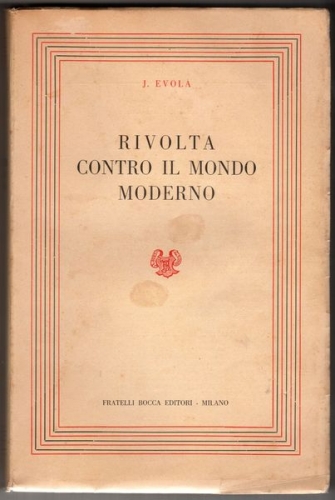 Il manque encore des études complètes sur une initiative qui était unique dans la période fasciste en termes d'intentions et de complexité : un véritable projet culturel avec lequel Julius Evola entendait exposer de manière constructive et critique le point de vue de la droite traditionnelle et conservatrice par rapport au fascisme. De nombreux représentants officiels de la culture européenne de cette tendance ont écrit sur cette page : des Italiens, mais aussi des Allemands, des Autrichiens, des Français et des Anglais. Parmi les Allemands, il y avait aussi le médecin et poète Gottfried Benn, avec lequel Evola correspondait depuis 1930.
Il manque encore des études complètes sur une initiative qui était unique dans la période fasciste en termes d'intentions et de complexité : un véritable projet culturel avec lequel Julius Evola entendait exposer de manière constructive et critique le point de vue de la droite traditionnelle et conservatrice par rapport au fascisme. De nombreux représentants officiels de la culture européenne de cette tendance ont écrit sur cette page : des Italiens, mais aussi des Allemands, des Autrichiens, des Français et des Anglais. Parmi les Allemands, il y avait aussi le médecin et poète Gottfried Benn, avec lequel Evola correspondait depuis 1930.
Dans la première moitié de 1934, le principal ouvrage que Julius Evola avait écrit - incroyablement, pour son âge et pour l'activité qu'il exerçait à ce moment-là - entre 1930 et 1932 : Rivolta contro il mondo moderno (Révolte contre le monde moderne) a été publié par Hoepli ; et il fitce voyage en Allemagne, mentionné dans son autobiographie. Lors de l'étape berlinoise, il y a eu la première rencontre directe avec Benn : il y avait beaucoup de points communs entre le médecin-écrivain, qui avait dix ans de plus qu'Evola (il est né en 1886 et est mort en 1956), et ce dernier. On a déjà tendance à souligner l'aspect nihiliste, athée et abstrait des aspects les plus horribles de la réalité humaine de Benn, et on a tendance à oublier sa contribution à la révolution conservatrice allemande. Il est un fait que le contact entre Evola et Benn, sur base d’une certaine communauté d'idées, a conduit à un célèbre essai-recension de la traduction allemande de Revolte qui a paru dans le numéro de mars 1935 de la revue Die Literatur de Stuttgart. C'est une sorte de "chant du cygne" dans lequel Benn expose ses idées et s'accorde avec la "vision du monde" d'Evola : en fait, c'est "son dernier texte en prose publié sous le Troisième Reich", car Rosenberg et Goebbels lui ont ensuite interdit d'écrire quoi que ce soit. Une revue d'analyse profonde dont Evola lui-même a reconnu l'importance et qu'il a voulu placer en annexe à sa collection d'essais L'arco e la clava (Scheiwiller, 1968), alors qu'elle sera désormais placée en annexe à la nouvelle édition de Rivolta qui sera publiée plus tard, en 1998. Il aimait lui-même se souvenir d'une phrase en particulier : "Une œuvre dont l'importance exceptionnelle se manifestera dans les années à venir. Celui qui le lira se sentira transformé et portera un regard nouveau sur l'Europe".
"Révolte" en Allemagne
Maintenant, pour confirmer et préciser la relation Evola-Benn, il y a trois lettres du premier au second, qui ont été trouvées par Francesco Tedeschi, un érudit qui s’occupe surtout d'Evola en tant qu'artiste, dans le Schiller-Nationalmuseum Deutsches Literaturarchiv (Handschriften Abteilung) à Marbach, et qui sont publiées ici en Italie grâce à sa collaboration active et à son consentement : deux lettres manuscrites qui sont datées du 30 juillet et du 9 août 1934, une lettre dactylographiée du 13 septembre 1955 dont la traduction complète est due à Quirino Principe. Des deux premiers écrits ressortent des faits connus mais aussi un autre fait absolument nouveau : les faits connus sont que Benn et Evola se connaissaient déjà au moins par lettre ("Ella ha ripetutamente mostrato un cordiale interesse per le mie fatiche" : 20 juillet), qu'ils se sont effectivement rencontrés lors du voyage d'Evola en Allemagne ("Le sarebbe molto obbligato se ella mi offre le possibilità di punti di vista e di una più lunga conversazione tra noi due" : 9 août), qu'il y avait une appréciation mutuelle de la même Weltanschauung "conservatrice" ou "traditionnelle" ("la compétence absolue que vous possédez à mon avis sur ces sujets et votre très grande connaissance et intelligence des traditions auxquelles je me rapporte" : 20 juillet), que tous deux ne se reconnaissaient pas dans le nazisme qui venait d'arriver au pouvoir ("Je suis de plus en plus convaincu qu'à ceux qui veulent défendre et réaliser, sans compromis avec le destin, une tradition spirituelle et aristocratique, il reste malheureusement, aujourd'hui et dans le monde moderne, aucune marge de manœuvre ; à moins de ne penser qu'au travail élitiste" : 9 août).
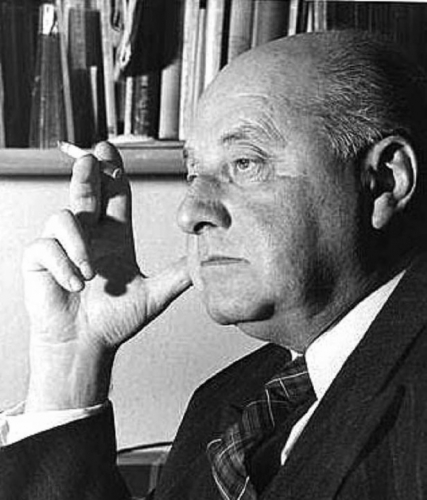
Le fait nouveau et extrêmement intéressant est la demande faite par Evola le 20 juillet, et acceptée par Benn dans sa réponse (que nous ne possédons pas) du 27 juillet, de "soumettre à révision le manuscrit de la traduction allemande" de Révolte faite par Friedrich Bauer. Le détail était totalement inconnu et Evola n'en a jamais parlé même si ce fait - la révision linguistique par un poète aussi connu et apprécié que Gottfried Benn - aurait pu donner encore davantage d'éclat à son livre majeur. Il ne semble pas y avoir de doute qu'une telle révision aurait bien été faite, non pas tant en raison des remerciements adressés pour la "plus aimable des intentions" (9 août), qu'en raison du fait que des références précises sont données au manuscrit de la traduction elle-même chez l'éditeur allemand et, on peut le déduire, en raison du grand intérêt manifesté par Benn dans sa critique de Die Literatur (le livre avait ainsi vu le jour en mars 1935) : non seulement, donc, nous avons l'adhésion à la "vision du monde" exposée dans l'ouvrage, mais aussi la haute considération de Benn-pour un texte dont - pour en avoir revu la traduction – il se sentait particulièrement proche. Une nouvelle pièce est ajoutée au tableau (encore incomplet) des relations entre Julius Evola et la culture conservatrice allemande entre les deux guerres. On peut donc imaginer que la correspondance avec le médecin-poète s'est poursuivie, mais, pour l'instant, nous n’en avons pas d'autres traces.
Avançons maintenant de vingt ans dans le temps, jusqu'en l’année 1955. La lettre du 13 septembre s'inscrit dans la tentative du philosophe de reprendre contact avec les représentants d’un non-conformisme profond qu'il avait connus dans les années trente et quarante : on sait qu'en 1947, il avait écrit à Guénon, en 1951 à Eliade et à Schmitt, en 1953 à Jünger, pour renouer avec un discours intellectuel interrompu par la guerre, mais aussi pour proposer des traductions de leurs livres en italien, étant donné qu'ils pourraient être utiles pour un nouveau Kulturkampf. Souvent, ses attentes n'ont pas été satisfaites : tout le monde n'était pas demeuré ferme sur certaines idées, ou plutôt ne considérait pas le moment opportun pour s'en souvenir, en raison de l'ombre négative qui pesait encore sur eux après 1945. Et c'est précisément en raison de ses "récents succès littéraires" que Benn n'a peut-être pas eu l'intention de répondre à celui qui n'était qu'une connaissance italienne, puisqu'il n'y a pas d'autres lettres d'Evola au Musée national : il faut donc penser que les "anciennes relations" n'ont pas été reprises. Il est certain qu'Evola n'a pas caché qu'il était resté le même ("je suis toujours resté sur mes anciennes positions, en ce qui concerne mon orientation intellectuelle et mes intérêts dominants") et il n'est pas certain que ces précisions n'aient pas été contre-productives...
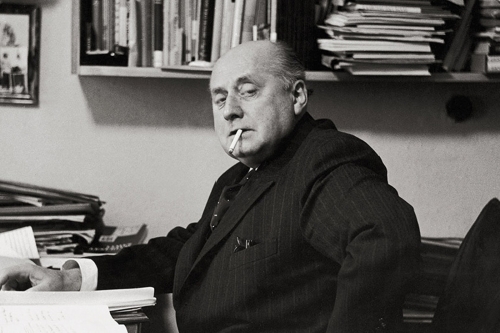
Ce qui est au contraire un peu singulier, c'est l'incapacité à se rappeler correctement le type de relations qui avaient eu lieu vingt ans plus tôt : non seulement la rencontre de Berlin, mais la connaissance mutuelle des travaux et les questions soulevées par Rivolta. L'absence de toute mention quant à la révision de la traduction, mais aussi de l'essai de Benn paru dans Die Literatur (publié treize ans plus tard en annexe de L'Arc et la Massue, comme déjà mentionné) est due à un échec mnémonique, ou peut-être à un sentiment d'opportunisme, pour ne pas embarrasser le médecin-poète ? Il est également vrai que Benn est mort seulement dix mois plus tard, le 7 juillet 1956, à l'âge de soixante-dix ans, et donc toute déduction peut être valable. Toutes les hypothèses restent également ouvertes quant aux raisons pour lesquelles Julius Evola, tant dans ses lettres privées que dans son autobiographie publique, a oublié de nombreux épisodes et personnages très importants dans les événements de sa vie : et certainement pas dans un sens positif, tel qu'accroître l'importance de son œuvre globale. Peut-être des trous de mémoire normaux comme cela peut arriver à n'importe qui, mais peut-être aussi cette tendance "impersonnelle" à minimiser un certain travail, en donnant si peu d'importance - au point de ne pas penser que certains détails méritent d'être mentionnés - à certains moments de sa vie. Il n'en reste pas moins que ces lettres à Gottfried Benn comblent de manière significative l'une des nombreuses lacunes qui subsistent afin de reconstruire pleinement la vie intense de Julius Evola.
Notes :
(1) Il cammino del cinabro, Scheiwiller, Milano, 1972, p.79.
(2) Heidnischer Imperialismus, Armanen Verlag, Lipsia, 1933.
(3) C’est-à-dire, d’une part, les exposants de la « tradition prussienne » et, d’autre part, le courant représenté par certains écrivains comme Moeller van den Bruck, Blüher, Jünger, von Salomon, etc., que l’on a classés dans le concept de « révolution conservatrice ».
(4) Il cammino del cinabro cit., p.137.
(5) Alain de Benoist, Presenza di Gottfried Benn, in Trasgressioni n.19, 1990, p.84.
(6) A propos de Rivolta, Evola écrivit à Giuseppe Laterza une lettre depuis Karthaus dans le Haut-Adige, en date du 16septembre 1931 : « Je suis sur le point de le terminer mais je ne sais encore rien de sa longueur ». (cfr. La Biblioteca ermetica, a cura di Alessandro Barbera, Fondazione J. Evola, Roma, 1997, pp.57-58).
(7) Lionel Richard, Nazismo e cultura, Garzanti, Milano, 1982, p.280.
(8) Cité in Il cammino del cinabro cit., p.138.
* * *
Texte tiré de Percorsi di politica, cultura, economia (6/1998).
00:31 Publié dans Littérature, Révolution conservatrice, Traditions | Lien permanent | Commentaires (0) | Tags : correspondances, gottfried benn, juliusevola, traditionalisme, tradition, révolution conservatrice, lettres, lettres allemandes, littérature, littérature allemande |  |
|  del.icio.us |
del.icio.us |  |
|  Digg |
Digg | ![]() Facebook
Facebook
dimanche, 03 janvier 2021
Essai sur l'importance du mythe
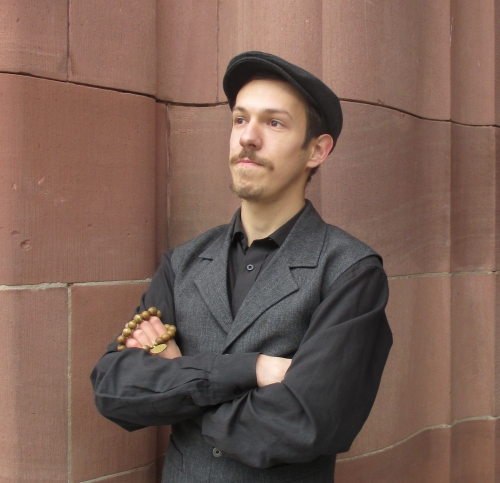
Essai sur l'importance du mythe
Askr Svarte
http://www.polemos.ru/index/2017/09/30/as-myth/
Tout ce qu'on appelle aujourd'hui magie, mysticisme et ésotérisme, dans un sens large, sont des souvenirs et des dérivés, avec différents degrés de déformation, de la pensée mythologique et du mythe comme réalité de perception et comme forme descriptive. Malgré des siècles d’éradication systématique du mythe hors de la conscience sociale - un "désenchantement du monde", selon les termes de Max Weber - les structures de la pensée mythologique et de la perception de la réalité, qui lui est propre, continuent à vivre jusqu'à aujourd'hui, parfois même en subjuguant les méthodes scientifiques.
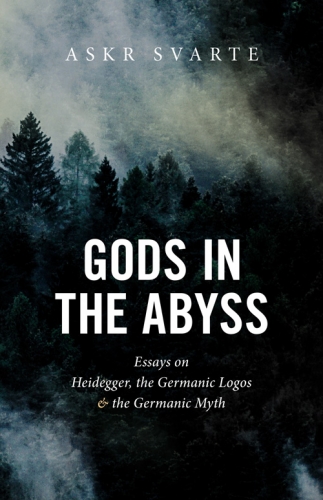 En grec ancien, le mot μῦθος signifie "tradition", "mythe". Un mythe est une chose qui se raconte oralement et se transmet de génération en génération. Si le mythe se raconte de lui-même, alors la mythologie (μῦθος + λόγος) est déjà une narration et une réflexion sur le mythe lui-même et son contenu ; la mythologie est une image rationalisée et généralisée, dont les intrigues dans le mythe lui-même sont données séparément et poétiquement.
En grec ancien, le mot μῦθος signifie "tradition", "mythe". Un mythe est une chose qui se raconte oralement et se transmet de génération en génération. Si le mythe se raconte de lui-même, alors la mythologie (μῦθος + λόγος) est déjà une narration et une réflexion sur le mythe lui-même et son contenu ; la mythologie est une image rationalisée et généralisée, dont les intrigues dans le mythe lui-même sont données séparément et poétiquement.
Dans la société traditionnelle, le mythe occupait une place centrale ; il déterminait tous les aspects de la vie et de la vision du monde d'une personne. La fonction du mythe est d'expliquer l'origine du monde, l'origine de l'homme et de la société, pourquoi il est ainsi disposé, quelles sont les lois divines qui règnent dans le monde et le gouvernent, d'où viennent ces choses et ces fonctions, comment se comporter correctement avec les autres personnes, avec les animaux et la nature en général, et plus encore. De là découle la propriété de toute mythologie : le holisme, la "totalité" en langue grecque ; le mythe est un tout et englobe intégralement tous les niveaux de l'être : les mythes, y compris les contes de fées, les croyances, les traditions et les légendes, expliquent tout en général.
La pensée ordinaire actuelle se réfère au mythe et à la mythologie comme on se réfèrerait à un endroit, qui existait il y a longtemps, dans un passé lointain, que l'humanité a surmonté comme une étape de l'enfance, comme on abandonne une croyance naïve en quelque chose de mythique. Mais si nous considérons le temps, selon le généralement accepté dans nos sociétés modernes, et le percevons comme une flèche lancée vers l'avenir, nous constatons que l'ère de la vision traditionnelle du monde remonte à la préhistoire, puis passe par les civilisations que nous connaissons sous le qualificatif de « pré-chrétiennes » : Égypte, Mésopotamie, Grèce, Rome et autres; des millénaires de traditions païennes sont remplacés par le christianisme du Moyen-Orient, qui affirme son mythe historique et dogmatique spécifique, et est finalement interrompu à la fin du 16ème siècle, lors du passage de la Renaissance à l'aube des Lumières. La Renaissance commence l'ère moderne : la période de destruction de l'antiquité religieuse,[1]... La modernité se termine au début du 20ème siècle après les révolutions et la chute des derniers empires continentaux pendant la Première Guerre mondiale. Nous vivons maintenant dans l'histoire postmoderne depuis un siècle. Si l'on compare les périodes historiques au cours desquelles la société et l'homme ont vécu dans la conscience mythique et religieuse, il s'avère que le mythe couvre une bonne partie des millénaires de l'histoire humaine, alors que la modernité ne dure qu’un peu plus de cinq cents ans. Ainsi, nous voyons que l'humanité - et maintenant nous parlons principalement des peuples européens et voisins - a abandonné la conscience mythologique et la pensée "d'hier", mais s'en est détachée très rapidement et radicalement. Dans d'autres régions du monde, dans d'autres civilisations, le pouvoir du mythe et de la vision traditionnelle du monde est encore plus ou moins préservé, il n'a pas encore été expulsé et il a survécu. Et si nous examinons de plus près encore les données de l'ethnographie et du folklorisme, nous verrons que les sociétés les plus modernes et les plus a-mythologiques se trouvent dans les villes, tandis que dans les villages, avec un mode de vie paysan et rural, on trouve encore d'immenses strates de pensée relevant des mythologies et des superstitions qui persistent. Donc, d'un point de vue historique, le mythe était la partie la plus importante, c'était le langage utilisé pour décrire le monde jusqu'à "hier".
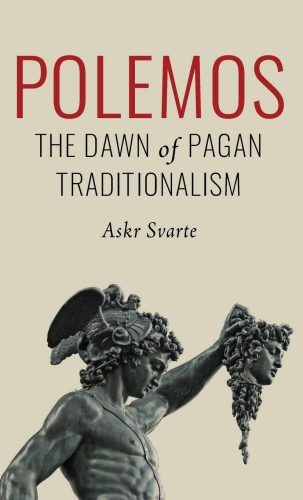 L'un des plus éminents penseurs allemands du 20ème siècle, Friedrich Georg Jünger, frère d'Ernst Jünger, analysant le contenu de la mythologie grecque au milieu du 20ème siècle, [2] conclut que les trames mythologiques sont intemporelles. Le mythe est une méta-histoire, ce qui se situe au-dessus des réalités historiques comme toile de fond du cours des événements ; en d'autres termes, malgré les changements de la société humaine, de la religion, de l'idéologie, des valeurs et des points de vue, l'humanité au plus haut niveau, sous une forme ou une autre, incarne, joue avec les trames des mythes paradigmatiques. Voici une question ouverte : les gens, dans leur destin, incarnent-ils cycliquement différents mythes, ou toute l'histoire humaine n'incarne-t-elle qu'un seul mythe de base ? Pour l'Europe, les mythologies grecque et romaine sont devenues une source inépuisable d'images, de métaphores, de modèles et de personnages, qui sont encore sans cesse reproduits dans la culture, l'art verbal et visuel. Ils sont présents dans le discours quotidien sous forme de phrases établies ou de noms communs, servent de sources à la terminologie scientifique et de modèles pour l'interprétation de la culture, c'est-à-dire pour la réflexion. Comme l'a dit Losev, le passé grec est devenu un passé commun pour toute l'Europe et pour les jeunes qui commencent tout juste à entrer dans la période de maturité.
L'un des plus éminents penseurs allemands du 20ème siècle, Friedrich Georg Jünger, frère d'Ernst Jünger, analysant le contenu de la mythologie grecque au milieu du 20ème siècle, [2] conclut que les trames mythologiques sont intemporelles. Le mythe est une méta-histoire, ce qui se situe au-dessus des réalités historiques comme toile de fond du cours des événements ; en d'autres termes, malgré les changements de la société humaine, de la religion, de l'idéologie, des valeurs et des points de vue, l'humanité au plus haut niveau, sous une forme ou une autre, incarne, joue avec les trames des mythes paradigmatiques. Voici une question ouverte : les gens, dans leur destin, incarnent-ils cycliquement différents mythes, ou toute l'histoire humaine n'incarne-t-elle qu'un seul mythe de base ? Pour l'Europe, les mythologies grecque et romaine sont devenues une source inépuisable d'images, de métaphores, de modèles et de personnages, qui sont encore sans cesse reproduits dans la culture, l'art verbal et visuel. Ils sont présents dans le discours quotidien sous forme de phrases établies ou de noms communs, servent de sources à la terminologie scientifique et de modèles pour l'interprétation de la culture, c'est-à-dire pour la réflexion. Comme l'a dit Losev, le passé grec est devenu un passé commun pour toute l'Europe et pour les jeunes qui commencent tout juste à entrer dans la période de maturité.
Souvenons-nous de Sigmund Freud et Carl G. Jung, les fondateurs de deux écoles de psychanalyse, qui ont chacune eu recours aux thèmes des mythes grecs. Freud s'intéressait particulièrement au mythe tragique d'Œdipe, qu'il considérait comme un événement archaïque possible et un mythe fondamental pour la culture et la psyché européennes (avec des variations sur l'esprit du mythe d'Electre). Encore plus axé sur la mythologie et la religion, son étudiant et rival Carl G. Jung a consacré beaucoup de ses travaux à expliquer la psyché humaine en relation avec le symbolisme religieux et sa propre doctrine des archétypes, qui sous-tendent également la mythologie des peuples du monde.
À partir du milieu du 20ème siècle, un changement d'approche dans l'étude des religions et des visions mythologiques des peuples anciens et modernes est advenu. La science refuse de considérer le mythe et la religion comme des reliquats de superstition, comme la simple "enfance" de l'humanité. Une approche phénoménologique et structuraliste de l'étude et de l'interprétation des différentes traditions s’établit en milieux scientifiques. La première approche est associée au classique roumano-américain des études religieuses, Mircea Eliade, qui a partagé la thèse sur l'éternité du mythe et défendu la méthode d'étude des mythes, laissant derrière lui toute une école d'études religieuses [3]... Il est à noter que Mircea Eliade et Carl G. Jung, outre qu'ils étaient d'éminents chercheurs en mythologie, culture, sociologie et philosophie du 20ème siècle, faisaient partie du cercle intellectuel d'Eranos (1933-2006), qui s'est donné pour tâche de comprendre et de développer une nouvelle approche de l'étude des cultures et des sociétés.
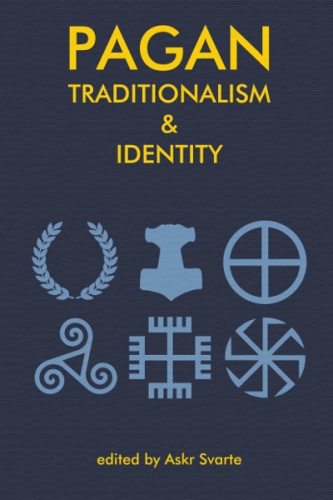 La deuxième approche est associée à l'école française du structuralisme et à la figure de l'éminent linguiste et mythologue Georges Dumézil. Dans ses écrits [4], il a montré et démontré que la grande majorité des mythes indo-européens sont basés sur une même structure, qu'il a appelée tripartite ou trifonctionnelle. En se basant sur l'analyse d'une grande variété de légendes et de mythologies européennes, indiennes, caucasiennes (surtout ossètes) et orientales, il montre que la structure de la société indo-européenne, héritée par des peuples et des traditions ultérieurs distincts, est composée de trois fonctions principales, au sein desquelles presque tous les individus sont répartis. Prêtres, guerriers et agriculteurs ou artisans. Cette division de l'ensemble de la société en une pyramide à trois parties (les exclus, les esclaves, les criminels, etc. en sortent) peut être retracée à travers l'histoire ancienne avec des changements mineurs. Par exemple, en matière de pouvoir séculier et politique, le sommet de la pyramide est généralement occupé par des soldats, et en matière de pouvoir et de culte sacré, il est dominé par les prêtres. Cette division de la société a été clairement préservée jusqu'à la fin du Moyen Âge et n'a pas complètement disparu jusqu'à présent, surtout dans les régions les plus conservatrices. Le lien de cette structure avec les mythologies réside dans le fait que la structure de la société est un dérivé de la mythologie du peuple, dans laquelle J. Dumézil montre la présence des trois fonctions issues des figures divines : les dieux suprêmes donnent naissance à la classe des prêtres et à leur place et rôle social ; les dieux de la guerre et de la justice donnent naissance au pouvoir militaire des rois et au pouvoir politique ; les dieux de la fertilité, des récoltes et de la terre donnent naissance au mode de vie et aux valeurs incarnées dans le tiers état : agriculteurs, artisans, pêcheurs, etc. En d'autres termes, le mythe sacré est le prototype (l’icône) de l'ordre social qui s'incarne dans le monde réel. Là où dans la mythologie il y a des dieux de la fertilité, dans la société il y a une caste d'agriculteurs et leurs propres cultes et traditions. Il en va de même pour les guerriers, les dirigeants, les chamans et les prêtres. Dans une société mythologique, le pouvoir vient des dieux, de haut en bas, du mythe au social. Ainsi, Dumézil aborde l'étude du mythe par un autre côté, mais confirme indirectement la thèse sur "l'éternité du mythe" et le rôle de ses formes (structures) dans la vie des peuples, structures qui ne sont pas effacées de l'histoire.
La deuxième approche est associée à l'école française du structuralisme et à la figure de l'éminent linguiste et mythologue Georges Dumézil. Dans ses écrits [4], il a montré et démontré que la grande majorité des mythes indo-européens sont basés sur une même structure, qu'il a appelée tripartite ou trifonctionnelle. En se basant sur l'analyse d'une grande variété de légendes et de mythologies européennes, indiennes, caucasiennes (surtout ossètes) et orientales, il montre que la structure de la société indo-européenne, héritée par des peuples et des traditions ultérieurs distincts, est composée de trois fonctions principales, au sein desquelles presque tous les individus sont répartis. Prêtres, guerriers et agriculteurs ou artisans. Cette division de l'ensemble de la société en une pyramide à trois parties (les exclus, les esclaves, les criminels, etc. en sortent) peut être retracée à travers l'histoire ancienne avec des changements mineurs. Par exemple, en matière de pouvoir séculier et politique, le sommet de la pyramide est généralement occupé par des soldats, et en matière de pouvoir et de culte sacré, il est dominé par les prêtres. Cette division de la société a été clairement préservée jusqu'à la fin du Moyen Âge et n'a pas complètement disparu jusqu'à présent, surtout dans les régions les plus conservatrices. Le lien de cette structure avec les mythologies réside dans le fait que la structure de la société est un dérivé de la mythologie du peuple, dans laquelle J. Dumézil montre la présence des trois fonctions issues des figures divines : les dieux suprêmes donnent naissance à la classe des prêtres et à leur place et rôle social ; les dieux de la guerre et de la justice donnent naissance au pouvoir militaire des rois et au pouvoir politique ; les dieux de la fertilité, des récoltes et de la terre donnent naissance au mode de vie et aux valeurs incarnées dans le tiers état : agriculteurs, artisans, pêcheurs, etc. En d'autres termes, le mythe sacré est le prototype (l’icône) de l'ordre social qui s'incarne dans le monde réel. Là où dans la mythologie il y a des dieux de la fertilité, dans la société il y a une caste d'agriculteurs et leurs propres cultes et traditions. Il en va de même pour les guerriers, les dirigeants, les chamans et les prêtres. Dans une société mythologique, le pouvoir vient des dieux, de haut en bas, du mythe au social. Ainsi, Dumézil aborde l'étude du mythe par un autre côté, mais confirme indirectement la thèse sur "l'éternité du mythe" et le rôle de ses formes (structures) dans la vie des peuples, structures qui ne sont pas effacées de l'histoire.
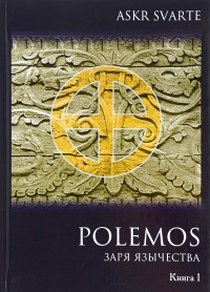 La question du pouvoir, du mythe politique et culturel est au centre de l'attention des spécialistes de la culture, des anthropologues, des sociologues et des philosophes du 20ème siècle, surtout dans la période de l'après-guerre. Selon la sémiotique de Roland Barthes, la société moderne, comme dans l'Antiquité, se développe dans un environnement et croit en divers mythes. Ce n'est qu'aujourd'hui que l’on ne cherche plus des exemples d'excellence chez les Grecs ou chez les Allemands, mais dans la mythologie de la culture pop, des médias et de la propagande politique, ce qui apparaît clairement dans l'histoire des régimes totalitaires. Dans la pensée quotidienne, nous rencontrons ces mythes sous forme de stéréotypes, de préjugés, de fascination pour des idoles pop ou des personnalités politiques que nous ne connaissons pas, mais nous voyons constamment leur image artificielle sur les émissions de télévision ou sur YouTube. Ainsi, il a été démontré que, malgré le passage de la pensée traditionnelle à la pensée scientifique, la grande majorité de la société continuait à vivre dans un environnement d'images irrationnelles et fantomatiques, ne changeant que le langage : on ne se réfère plus à la mythologie grecque classique, par exemple, mais à un journal, un parti politique ou une chaîne de télévision. En même temps, la croyance mythique dans l'importance d'une pop star ou d'un chef de parti lui redonne une certaine autorité, fait de lui un modèle moral et un berger de ses fans. Mais maintenant que cette mythologie se construit de bas en haut, le pouvoir de l'idole dépend du caractère de masse de son fan club. Les mécanismes par lesquels la mythologie de la société capitaliste moderne et celle des médias façonnent le pouvoir et influencent la société et la personne en particulier sont examinés en détail et de façon critique dans les travaux de M. Foucault, R. Barthes, J. Baudrillard et d'autres. Les opposants à la société mythologique - par exemple, R. Bultmann et P. Riker - ont insisté sur la nécessité d'une purification et d'une rationalisation strictes de la culture et même de la religion, afin de séparer les significations de la nébuleuse de l'irrationnel. Il convient de rappeler ici la critique de la méthodologie scientifique, qui est traditionnellement opposée à toute forme de mythologie, en tant que système strict, logique et rationnel de preuves objectives. Dans ses écrits, le philosophe Paul Fayerabend a clairement montré que la science et les scientifiques violent constamment, et même n'ont jamais observé, les méthodes d'investigation scientifique ou les propres résultats expérimentaux établis par eux. Outre la critique de la société de masse moderne du côté de la philosophie française, il a également pris en compte la critique de la modernité du point de vue de Julius. Evola et Ernst Jünger - partisans du mythe, il est possible de lire toute la perception scientifique moderne du monde comme une forme spéciale et originellement arrangée de la même mythologie, où les docteurs en sciences prennent la place des prêtres, et les ingénieurs et les mécaniciens celle des agriculteurs. Aujourd'hui, un nouveau monde "magique" est également présent, celui de la réalité virtuelle et de sa mythologie (ce que nous appelons New-Age, Wicca, néo-paganisme, parapsychologie, etc.)
La question du pouvoir, du mythe politique et culturel est au centre de l'attention des spécialistes de la culture, des anthropologues, des sociologues et des philosophes du 20ème siècle, surtout dans la période de l'après-guerre. Selon la sémiotique de Roland Barthes, la société moderne, comme dans l'Antiquité, se développe dans un environnement et croit en divers mythes. Ce n'est qu'aujourd'hui que l’on ne cherche plus des exemples d'excellence chez les Grecs ou chez les Allemands, mais dans la mythologie de la culture pop, des médias et de la propagande politique, ce qui apparaît clairement dans l'histoire des régimes totalitaires. Dans la pensée quotidienne, nous rencontrons ces mythes sous forme de stéréotypes, de préjugés, de fascination pour des idoles pop ou des personnalités politiques que nous ne connaissons pas, mais nous voyons constamment leur image artificielle sur les émissions de télévision ou sur YouTube. Ainsi, il a été démontré que, malgré le passage de la pensée traditionnelle à la pensée scientifique, la grande majorité de la société continuait à vivre dans un environnement d'images irrationnelles et fantomatiques, ne changeant que le langage : on ne se réfère plus à la mythologie grecque classique, par exemple, mais à un journal, un parti politique ou une chaîne de télévision. En même temps, la croyance mythique dans l'importance d'une pop star ou d'un chef de parti lui redonne une certaine autorité, fait de lui un modèle moral et un berger de ses fans. Mais maintenant que cette mythologie se construit de bas en haut, le pouvoir de l'idole dépend du caractère de masse de son fan club. Les mécanismes par lesquels la mythologie de la société capitaliste moderne et celle des médias façonnent le pouvoir et influencent la société et la personne en particulier sont examinés en détail et de façon critique dans les travaux de M. Foucault, R. Barthes, J. Baudrillard et d'autres. Les opposants à la société mythologique - par exemple, R. Bultmann et P. Riker - ont insisté sur la nécessité d'une purification et d'une rationalisation strictes de la culture et même de la religion, afin de séparer les significations de la nébuleuse de l'irrationnel. Il convient de rappeler ici la critique de la méthodologie scientifique, qui est traditionnellement opposée à toute forme de mythologie, en tant que système strict, logique et rationnel de preuves objectives. Dans ses écrits, le philosophe Paul Fayerabend a clairement montré que la science et les scientifiques violent constamment, et même n'ont jamais observé, les méthodes d'investigation scientifique ou les propres résultats expérimentaux établis par eux. Outre la critique de la société de masse moderne du côté de la philosophie française, il a également pris en compte la critique de la modernité du point de vue de Julius. Evola et Ernst Jünger - partisans du mythe, il est possible de lire toute la perception scientifique moderne du monde comme une forme spéciale et originellement arrangée de la même mythologie, où les docteurs en sciences prennent la place des prêtres, et les ingénieurs et les mécaniciens celle des agriculteurs. Aujourd'hui, un nouveau monde "magique" est également présent, celui de la réalité virtuelle et de sa mythologie (ce que nous appelons New-Age, Wicca, néo-paganisme, parapsychologie, etc.)
Vidéo: Moot with Askr Svarte and Stead Steadman - Pagan Traditionalism and "Polemos" book
Par ailleurs, les tendances croissantes de la virtualisation et de la mondialisation poussent de plus en plus les sociétés et les peuples à chercher leurs racines et leur identité dans les religions et les traditions anciennes. La recherche de la stabilité dans un monde en constante évolution conduit une fois de plus les gens vers une source d'ordre, de structure et de sens, ontologiquement supérieure aux conventions ou décisions momentanées. De nombreux événements religieux, conflits, phénomènes et problèmes culturels ont leurs racines ici. La "personne" n'est plus ce qu'elle était et la mythologie est en déclin. Mais en cette ère de changement, une nouvelle fenêtre d'opportunité s'ouvre pour que le mythe illumine le monde et mette de l'ordre dans les sociétés. Cela peut ou non se produire. Aujourd'hui, beaucoup dépend des gens eux-mêmes. Sur leur dévotion (fidelis) à leur Chemin, au Sacré, aux Dieux et aux idéaux les plus élevés qui s'élèvent dans le monde des ruines (Julius Evola).
Notes :
[1] A. F. Losev «Estética del Renacimiento», «Pensamiento», 1982.
[2] F.G. Junger «Mitos griegos».
[3] M. Eliade «Lo sagrado y lo mundano»
[4] J. Dumezil «Los dioses supremos de los indoeuropeos».
Traducido por Alejandro Linconao
Tomado de: http://www.polemos.ru/index/2017/09/30/as-myth/
00:05 Publié dans Traditions | Lien permanent | Commentaires (0) | Tags : askr svarte, tradition, traditionalisme, mythes, mythologie |  |
|  del.icio.us |
del.icio.us |  |
|  Digg |
Digg | ![]() Facebook
Facebook
vendredi, 01 janvier 2021
Feux dans la nuit d'hiver : perspectives eschatologiques dans les rites traditionnels du Nouvel An

2021
Feux dans la nuit d'hiver : perspectives eschatologiques dans les rites traditionnels du Nouvel An
Pour le Nouvel An, nous publions un article sur ces feux, tiré du site italien https://www.azionetradizionale.com
par Lorenzo Maria Colombo
Dans de nombreux pays du nord de l'Italie, les célébrations de la fin de l'année et des premiers mois de la nouvelle année sont accompagnées de rituels collectifs particuliers qui, à y regarder de plus près, ont l'aspect apparemment assez macabre d'un sacrifice humain : des mannequins aux traits anthropomorphiques ou même des êtres humains en chair et en os sont brûlés, noyés, enterrés ou, en général, tués rituellement.
A Ameglia (SP), par exemple, il existe la tradition de l'Omo ar bozo, dans laquelle une personne du village se déguise en étranger qui est jugé et jeté dans une mare d'eau (le bozo, en fait).
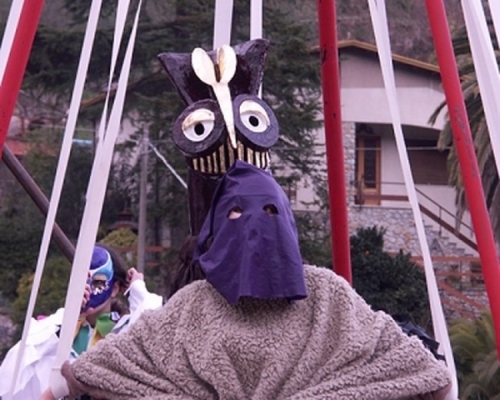
Dans de nombreux autres endroits, cependant, le symbolisme de l'enjeu purificateur semble prévaloir : À Varallo Sesia (VC), le 6 janvier, pour célébrer le début du carnaval, les habitants se réunissent sur les rives du ruisseau Mastallone, qui divise la localité en deux, pour brûler le mannequin diy du Veggia Pasquetta (le « vieux lundi de Pâques ») ; le feu continue à jouer un rôle central pendant toute la durée de ce carnaval alpin, l'un des plus importants et des plus populaires du nord du Piémont, avec des épisodes tels que le rond-point autour du feu de joie sur la place le soir du Carnevalàa n'tla stràa (Carnaval sur la route) et l'incendie final du roi du Carnaval (évidemment toujours un mannequin) sur le Ponte Antonini.
Des rites similaires ont lieu dans le village de Roccapietra et dans les villes voisines de Civiasco et Borgosesia, parfois accompagnés de feux d'artifice. D'autres caractéristiques de cette période, qui sont très importantes comme nous le verrons pour comprendre son profond symbolisme, sont les distributions gratuites de nourriture (soupe, haricots, tripes, focaccia, sucreries, etc.) dans différents villages. Parmi les quelques autres particularités de cette période, répandues dans divers pays, il faut compter certaines manifestations typiques où prédominent des performances de force et d'habileté physiques, voire un caractère explicitement agonistique ou guerrier : par exemple, le défi entre le "laid" et le "beau" qui se déroule dans Suvero (SP), les sapeurs (littéralement: les huissiers) armés qui accompagnent les défilés de carnaval de Sampeyre (CN) et Schignano (CO), la Danse des épées lors des processions religieuses de Venaus et Giaglione (TO), les coups de poing dans les rues contre les krampus (les "putréfiés" ou, selon une autre étymologie, "celui qui a les griffes") dans le Trentin-Haut-Adige ou encore les célèbres manieurs de drapeaux du Paliotto d'Asti qui sont appelés à se produire sur les places de différentes communes piémontaises.
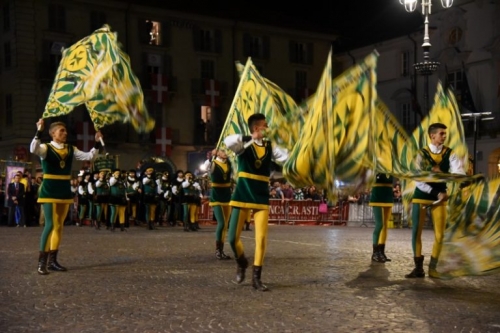
Les ethnologues et anthropologues interprètent généralement ces traditions comme des résidus païens d'anciens rites propitiatoires pour la fertilité des champs, antérieurs à l'arrivée du christianisme ; le faux "sacrifice humain" (ou même dans certains cas le sacrifice authentique et sanglant d'un animal, comme une dinde ou une oie) est alors considéré comme une représentation typique du "bouc émissaire". Selon l'ethnologue Piercarlo Grimaldi, la "chèvre" est tuée par la "communauté paysanne qui, pour faire face à la nouvelle saison agricole, doit se régénérer rituellement"[1].
Il va sans dire que de telles explications, même si elles ne sont pas complètement fausses, sont, d'un point de vue authentiquement traditionnel, loin d'être satisfaisantes. L'incapacité des universitaires occidentaux à analyser les significations cachées de ces rites est probablement due, au moins en partie, à la rupture, survenue pour des raisons historiques et sociales, entre la culture paysanne et celle de la "haute société" (ndt : la « culture des élites » selon Robert Muchembled), représentée autrefois par le clergé et aujourd'hui par les universitaires, qui ne sont plus capables de dialoguer et de comprendre la culture populaire. Il faut évidemment ajouter à cela des considérations sur le "cycle vital" normal des traditions, qui, dans sa phase terminale, voit une perte progressive de sens jusqu'à ne laisser qu'une forme vide et « survivante » (d'où le terme « superstition »).
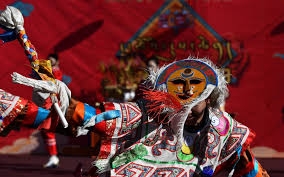
Si nous voulons trouver la véritable clé de l'interprétation de ce que nous venons de dire, nous devons donc nous tourner vers les cultures où une telle césure n'a pas eu lieu ou a été rétablie à temps : c'est le cas du Tibet où (au moins avant l'invasion communiste chinoise) les rites du Nouvel An étaient pratiqués, avec la combustion d’un mannequin, extraordinairement similaires à ceux du nord de l'Italie. Ici, cependant, la tradition bouddhiste a réussi à réinterpréter l'ancien rituel populaire dans la perspective sotériologique de la nouvelle religion, ou plutôt à revenir à leur signification originelle. Traditionnelles, les anciennes formes ont dégénéré en superstition, explique en fait le célèbre tibétologue Giuseppe Tucci : "La superposition de la fête du sMon lam sur l'ancienne fête du Nouvel An s'explique par le fait que le premier en était venu à s'identifier à l'idée de la victoire sur le mal et l'hérésie dans le miracle de Śrāvastī (...)[2]. La communauté est dans une période de déclin progressif, dans laquelle le mal augmente et la doctrine prêchée par Śākyamuni devient obscure. Il est donc nécessaire d'éliminer ou au moins d'atténuer les signes évidents de cette époque - épidémies, guerres, famines - mais surtout d'aider à préparer l'action rédemptrice du prochain Bouddha, Byams pa, Maitreya. Le symbolisme à la base de cette pensée a également des répercussions sur le plan liturgique et pratique : le gouvernement distribue des plantes médicinales (sman) aux moines pour lutter contre les maladies ; des tissus de soie pour les défendre du danger des armes ; de la nourriture, de la viande, de la soupe, de l'argent, etc... contre la famine imminente. La liturgie est conditionnée de façon dramatique à chacun de ses différents moments. Par exemple, la procession rituelle autour du temple de Byams pa est censée signifier que la nouvelle ère de la doctrine, la descente de la parole divine, est déjà un fait accompli (...) la non-science (ma rig), l'origine de la contamination morale (ňon mons) et donc aussi du karma, est innée en chacun de nous, en moi et dans les autres, et [pour cela] il est nécessaire de la brûler dans le feu de la connaissance sublimée (ye šes kyi me). L'image qui est au centre de cette cérémonie est destinée à recevoir en elle-même la non-science et est brûlée dans le feu de la sagesse, qui est représentée de cette façon (...). A l'attente de la nouvelle année prévaut celle de l'annus magnus : ainsi le cycle bref des douze mois devient le maillon d'une chaîne qui s'étend à l'infini, de bon augure, de renouvellement de la doctrine, de l'avènement du royaume de Maitreya, dont l'épiphanie aura lieu après la fin du processus progressif de décadence de l'ère cosmique actuelle"[3].
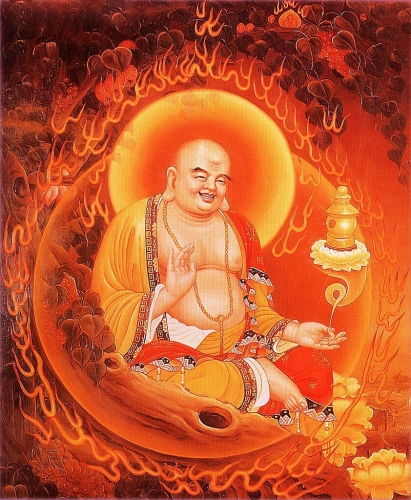
Pour résumer : au moment où l'obscurité semble la plus profonde, à la limite entre une année et l'autre, les adeptes de la Tradition sont appelés à monter sur le terrain de lutte, à entrer en guerre contre les forces du mal afin de favoriser le retour de la Lumière dans une nouvelle ère prospère du monde, où il n'y aura plus ni faim ni misère et où les hommes se "nourriront" directement de l'enseignement spirituel ; et les flammes qui brûlent le mannequin sacrifié ne sont autres que celles qui consommeront les potentialités inférieures de ce cycle pour permettre au nouveau de commencer.
Au Tibet, comme en Italie, le rite du début de la nouvelle année entend représenter une attente, non pas passive et sentimentale mais active et "militante", une tension eschatologique vers la réalisation, même seulement temporaire et virtuelle, de cette Terre pure, cette Jérusalem céleste où l'être humain sera réintégré dans son état originel[4].
Enfin, nous nous permettons de faire quelques réflexions sur la situation que nous vivons dans cette période particulière de l'Histoire.
On se souvient qu'au début de l'année 2020, alors que, comme on vient de le démontrer, la pandémie de covid-19 était déjà en cours depuis plusieurs mois, le premier confinement est tombé au moment même où les festivités du carnaval atteignaient leur point culminant, empêchant la conclusion naturelle du Carême, avec les fermetures forcées qui se sont ensuite étendues bien au-delà de la Semaine Sainte. Et aujourd'hui, avec l'urgence sanitaire qui semble loin d'être résolue, il est très probable que nous soyons obligés d'abandonner nombre de ces rites traditionnels mentionnés au début de notre article, dont certains, il faut le souligner, ont des origines très anciennes et n'ont jamais été interrompus jusqu'à présent, sauf pendant les périodes les plus sombres de la Seconde Guerre mondiale.
Il est probablement trop tôt pour affirmer que cette situation est intentionnelle, qu'elle découle d'une intention consciente d'anéantir nos traditions ancestrales ; et pourtant la symbolique lugubre qui sous-tend ces faits nous semble claire : les forces de l'anti-tradition, les légions de l'adversaire n'acceptent plus d'être domptées et exorcisées, mais se déchaînent de toutes leurs forces dans le monde dévasté.
Et dans ce contexte, il n'est pas surprenant que certains "champions" de la subversion internationale n'aient pas pu cacher un certain sentiment de vengeance mesquine contre ceux qui, légitimement, se plaignaient de la suppression ou de la réduction à un minimum des événements traditionnels : juste avant ce Noël 2020, parmi les plus dramatiques dont l'histoire récente se souvienne, un youtubeur, au nom plutôt risible d'"Ateotube", a déclaré sur sa page Facebook : "Je ne comprends vraiment pas le fétichisme des Italiens pour les traditions. Mieux vaut innover, progresser, avancer".
Progresser et avancer vers où, on peut se le demander, si ce n'est vers une civilisation vidée de tout sens, vers une culture qui ne peut plus être définie comme telle car rien n'est plus "cultivé", vers l'immense abîme d'où tant de jeunes tentent en vain de s'échapper avec la drogue ou en s'ôtant la vie...
Mais en fin de compte, comme nous le savons déjà, ce sont des choses qui doivent arriver. Les armées des ténèbres seront autorisées à avancer jusqu'à ce que la moindre lueur de la Lumière des anciens jours semble être étouffée à jamais ; alors, et seulement alors, Rudra Chackrin, Seigneur de la Roue Cosmique, descendra dans le monde pour la sacrifier (la rendre sacrée) dans les flammes purificatrices et sanctionner le début d'un nouveau Jour.
Il nous appartient de nous préparer à ce moment par une pratique intérieure, car les formes extérieures - en elles-mêmes seulement instrumentales et temporaires - nous sont aujourd'hui refusées.
À tous ceux d'entre vous qui ont eu la patience de lire cet article jusqu'au bout, j’apporte un souhait sincère de bonne année sous le signe de la lutte et de la victoire.
Notes :
[1] P. Grimaldi, Tempi grassi tempi magri, Omega edizioni 1996 Torino, p. 50.
[2] L’épisode où Bouddha manifeste sa propre supériorité face aux adeptes des sectes rivales, est celui où, de son corps, s’échappent simultanément des langues de feu et une pluie d’eau. Remarquons que ce double symbolisme de l’eau et du feu se repère également dans les rites italiens que nous avons cités.
[3] G. Tucci, Le religioni del Tibet, ed. Mediterranee 1995 Roma, pp. 192-193. Ed. originale Die Religionen Tibets, W. Kholhammer GmhH, Stuttgart 1970.
[4] G. Marletta, L’Eden, la Resurrezione e la Terra dei Viventi, Irfan edizioni San Demetrio Corone (CS) 2017, pp. 79-91.
11:12 Publié dans Actualité, Traditions | Lien permanent | Commentaires (0) | Tags : actualité, traditions, fêtes d'hiver, italie, piémont, nouvel an |  |
|  del.icio.us |
del.icio.us |  |
|  Digg |
Digg | ![]() Facebook
Facebook
Les grandes âmes sont odysséennes...

Les grandes âmes sont odysséennes...
par Luc-Olivier d'Algange
Les grandes âmes sont odysséennes. Qu'est-ce que la grandeur ? Par quelle aspiration prouvons-nous le sens de la grandeur ? Le poème épique, celui d'Homère en particulier, répond à cette question: par le voyage, lorsque ce voyage est au sens exact initiatique. Le héros « ondoyant et divers » navigue, car naviguer est nécessaire et qu'il n'est point nécessaire de vivre. Toute la différence entre la vie magnifique et la survie est dite en ces quelques mots: Naviguer est nécessaire... Il ne s'agit point tant d'atteindre à la grandeur que d'être digne de la grandeur qui nous environne. L'homme moderne aspire à des réalisations colossales, comme le sont également sa bêtise et son outrecuidance. Les temples de Delphes et d'Epidaure, l'architecture romane, leur fille conquérante de l'Invisible, témoignent d'un autre sens de la grandeur. C'est une grandeur méditée et contemplée, une grandeur intérieurement reconstruite par une exacte Sapience des rapports et des proportions. Nous devons à Walter Otto et à Ernst Jünger, ces philosophes lumineux, la distinction entre le monde dominé par les titans et le monde dominé par les dieux. Avant d'être « moderne » et quoique l'on puisse entendre sous ce terme, notre monde est bien un monde titanesque, un monde de fausse grandeur et de colossales erreurs. Le monde des dieux, lui, s'est réfugié dans nos cœurs et il devenu une vérité intérieure, c'est-à-dire qu'il se confond avec la lumière émanée du Logos. Si rien ne peut être ajouté, ni ôté, rien n'est perdu. La véritable grandeur n'est pas absente, elle est oubliée dans l'accablement et l'ennui des travaux titaniques. S'en souvenir, par bonheur, n'exige pas que nous nous rendions immédiatement victorieux de ces artificieuses grandeurs; il nous suffit d'accueillir les battements d’ailes légers de l’anamnésis.
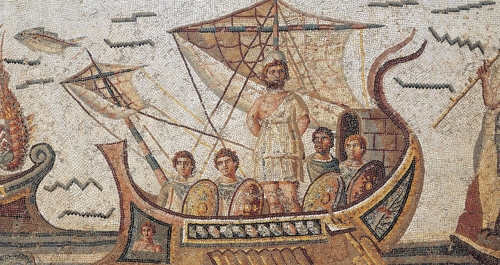
Le subtil essor du ressouvenir triomphe de tout. La recouvrance de la grandeur est offerte à quiconque ne se résigne point, mais persiste, à la pointe extrême de son entendement, comme une étrave, à l'affrontement de l'inconnu maritime. Les grandes âmes sont odysséennes. Elles viennent comme des vagues vers nous dans les heures sombres et dans les heures claires. Elles laissent aux heures claires une chance d'être et une raison d'être dans le ressac tumultueux des heures sombres.
Il existe une habitude du malheur à laquelle les grandes âmes odysséennes seront toujours rétives. Elles engagent le combat, ne craignent point les issues incertaines et osent le voyage. Elles vont jusqu'à défier les lois de l'identité et de la contradiction pour choisir de périlleuses métamorphoses. Lorsque les ciels sont à l'orage, que la mer violette accroît l'émerveillement et l'effroi du pressentiment, l'âme odysséenne se retrouve être, soudain apaisée, dans l'heure la plus claire, dans le scintillement de la vague ascendante qui triomphe des nuits et des abysses qui la portent.

Le sens épique des grandes âmes, nous le savons, ne refuse point le malheur. Il existe chez les âmes aventureuses un consentement à la fortune bonne ou mauvaise qui ne laisse pas de surprendre les générations étiolées. Mais cette acceptation du malheur n'est jamais que l'assombrissement momentané du regard après l'éblouissement, « soleil noir de la mélancolie » que dit Gérard de Nerval. A celui qui consent à se laisser peupler par les images odysséennes, à se laisser entraîner par elles, c'est une grande Idée du bonheur qui le subjugue. Un vaste songe heureux entoure de ses espaces limpides et sonores le vaisseau qui file à l'allure que lui prédestinent les voiles et le vent: c'est le sens de notre destinée.
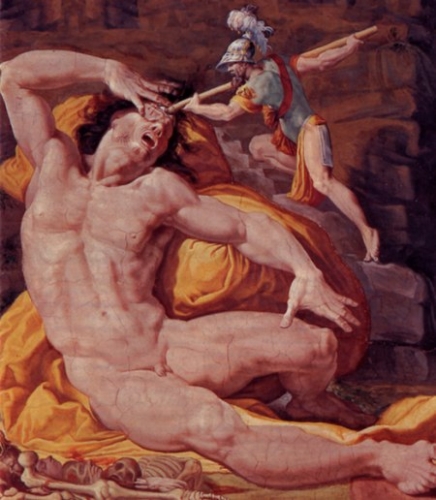
Certes, la destinée est écrite et souvent des forces néfastes se conjuguent à nous soumettre à des rhétoriques malfaisantes ourdies par des forces jalouses, comment le nier ? Certes, les heures sombres avancent vers nous en cohortes plus serrées que les heures claires, mais le regard de l'Aède transperce les nuées et voit, là où le commun ne voit que du vide, les escadres claires des heures promises, des prières exaucées !
Le paradoxe admirable de l'épopée est de nous enseigner en même temps l'abandon et le courage, alors que le monde moderne nous enseigne la récrimination et la faiblesse. Toute grande âme est odysséenne, elle s'abandonne à la beauté et la grandeur du monde et, dans cet abandon aux puissances augustes, trouve le courage d'être et de combattre. La vie magnifique est possible car il n'est pas nécessaire de vivre, s'il est nécessaire de naviguer. Croire en une toute-possibilité, vouloir s'en rapprocher comme d'un Graal ou d'une Toison d'Or, telle est la foi du héros qui trouve dans la divination des claires escadres la justification de ses actes et de son chant. Le malheur gronde, l'eau et le ciel sont noirs, mais elles viendront bien à sa rescousse. Escadres claires et logiques, ordonnées et ordonnatrices, accordées à la divine Mesure.
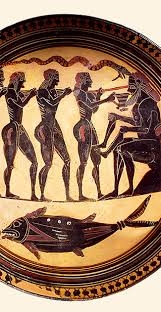 Sans doute sommes-nous fort mal placés en nos temps rationalistes et déraisonnables pour comprendre la méfiance grecque à l'égard de l'hybris, de la démesure. Nous sommes si aveuglément dévoués à la démesure que nous n'en concevons plus même le contraire. Notre démesure est devenue si banale que toute mesure nous paraît extravagante ou coupable. Comment, alors servir la Mesure, par quels noms l'évoquer et l'invoquer sans la trahir ? Par le seul nom de Légèreté ! Les claires escadres de la raison d'être de nos actes et de nos chants sont légères; c'est à peine si elles touchent les vagues amies. Entre l'horizon et le plus fort de notre combat, elles franchissent la distance en se jouant. Non seulement la Mesure est légère, elle ne se pose ni ne s'impose, sinon prosodique; elle est fondatrice de la légèreté en ce monde. Les Anciens croyaient en la terre dansante et en la terre céleste. La Mesure nous sauve de la lourdeur et de l'inertie. Bien qu'elle soit plus que la vie, ayant partie liée aux Immortels, elle nous sauve de la mort. Lorsque la Mesure est ignorée les titans outrecuident, et les hommes se livrent sans vergogne à l'infantilisme et à la bestialité.
Sans doute sommes-nous fort mal placés en nos temps rationalistes et déraisonnables pour comprendre la méfiance grecque à l'égard de l'hybris, de la démesure. Nous sommes si aveuglément dévoués à la démesure que nous n'en concevons plus même le contraire. Notre démesure est devenue si banale que toute mesure nous paraît extravagante ou coupable. Comment, alors servir la Mesure, par quels noms l'évoquer et l'invoquer sans la trahir ? Par le seul nom de Légèreté ! Les claires escadres de la raison d'être de nos actes et de nos chants sont légères; c'est à peine si elles touchent les vagues amies. Entre l'horizon et le plus fort de notre combat, elles franchissent la distance en se jouant. Non seulement la Mesure est légère, elle ne se pose ni ne s'impose, sinon prosodique; elle est fondatrice de la légèreté en ce monde. Les Anciens croyaient en la terre dansante et en la terre céleste. La Mesure nous sauve de la lourdeur et de l'inertie. Bien qu'elle soit plus que la vie, ayant partie liée aux Immortels, elle nous sauve de la mort. Lorsque la Mesure est ignorée les titans outrecuident, et les hommes se livrent sans vergogne à l'infantilisme et à la bestialité.
Les héros, les chevaliers, les navigateurs nous entraînent dans la vérité de la métaphore. Ils nous apprennent à interroger les signes et les intersignes, à trouver la juste orientation dans la confusion des apparences, ou, plus précisément, dans cette apparence de confusion à laquelle nous inclinent la faiblesse et le fanatisme. La puissance métaphorique et réelle qui porte le navigateur sur la « mer toujours recommencée » dont parle Valéry n'est pas l'hybris mais la Tradition. Elle est cette puissance heureuse qui nous porte au-delà de la mensongère évidence des êtres et des choses, par-delà les identités statiques, les individualités possessives, les subjectivités idolâtrées dans la mauvaise conscience de leur déroute.
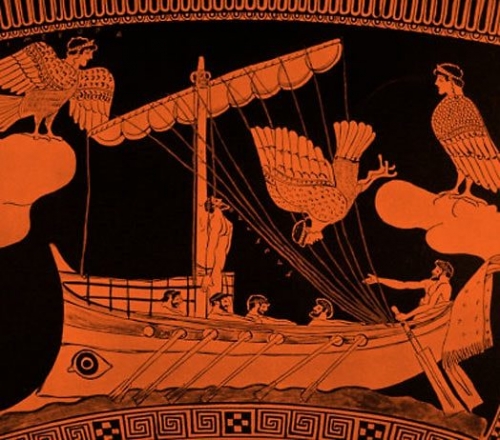
La métaphore est maritime; elle ne s'ajoute point à la réalité, elle est la réalité délivrée de nos représentations schématiques, de ces facilités de langage, de ces jargons qui feignent la raison, sans raison d'être. Croire détenir la raison, cette hybris du rationaliste, n'est-ce point être possédé par la déraison ? Favoriser dans le déroulement prosodique la levée des grandes images odysséennes, ce n'est pas fourbir des armes contre la raison mais restituer la raison au Logos, œuvrer exactement à la recouvrance de la raison. Lorsque les métaphores ne dansent plus à la crête des vagues, les mots deviennent des mots d'ordre; et les mots et l'ordre sont perdus pour les desseins divins. La pensée, alors, s'emprisonne en terminologies. La suspicion et la mesquinerie se substituent à cet usage magnanime et chanceux du langage qui est le propre des poètes.
Les grandes âmes sont odysséennes, et le signe de leur grandeur est d'unir la poésie et la raison, non certes pour nous réduire au compromis détestable d'une poésie raisonnable mais par un heurt étincelant où l'apparence de la poésie comme l'apparence de la raison volent en éclats. De l'autre côté de ces apparences se trouvent non les certitudes d'usage, mais la mystérieuse et ardente gnosis rimbaldienne de l'éternité qui est « la mer allée avec le soleil », l'épiphanie éminente de la splendeur. Sous l'invaincu soleil, la métaphore maritime est la messagère des grandes âmes.
Luc-Olivier d'Algange.
00:51 Publié dans Traditions | Lien permanent | Commentaires (0) | Tags : ulysse, odyssée, traditions, hellénisme, culture gréco-latine, luc-olivier d'algange |  |
|  del.icio.us |
del.icio.us |  |
|  Digg |
Digg | ![]() Facebook
Facebook
Le symbolisme du sanglier
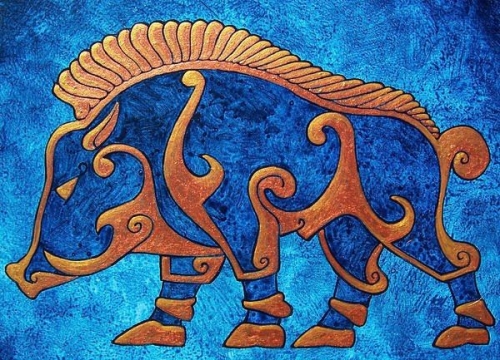
Le symbolisme du sanglier
par Gérard Thiemmonge
A propos de l'auteur : J'ai rencontré Gérard Thiemmonge, l'auteur de cet article publié à titre posthume, lors d'une université d'été de la Nouvelle Droite au début des années 80. Jusqu'à sa mort il y a quelques années, nous avons entretenu une amitié étroite, accompagnée d'un échange régulier de documentation sur l'histoire de certaines régions d'Europe et de leurs traditions. Au fil des ans, Gérard Thiemmonge est devenu un encyclopédiste infatigable qui a compilé un impressionnant catalogue d'illustrations, de cartes postales et de documentation sur des sujets aussi divers que la tradition musicale entourant la cornemuse en Europe, les runes et les animaux sacrés dans la tradition indo-européenne. Cependant, Gérard Thiemmonge, enraciné et passionné d'histoire et des traditions d'Europe, était aussi un véritable reître, un aventurier chevronné et un expert en techniques de survie et de la guerilla. À la fin des années 1970, il a combiné ses connaissances de baroudeur dans deux ouvrages, publiés chez Copernic : "Objectif Raid" et "Guide pratique pour l'expédition et l'aventure".
Ralf Van den Haute.
Le symbolisme du sanglier trouve ses origines dans la Tradition primordiale et hyperboréenne, elle-même fondatrice des divers mythes indo-européens.
A côté du cerf, le sanglier faisait partie du monde marginal et divin de la forêt. Il participait de l’animation visible, (lat. anima = âme) comme témoin du panthéon des dieux que l’esprit des hommes avait forgé, pour hiérarchiser le sacré et appréhender le monde.
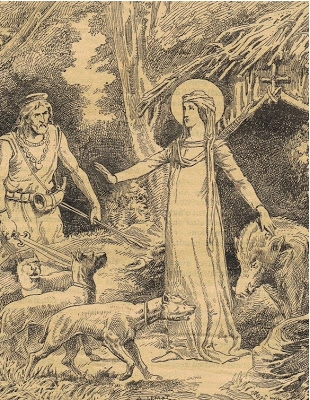 Animal solaire, le sanglier participait des trois fonctions de l’idéologie tripartite des indo-européens, et c’est à ce titre que la compréhension de sa symbolique est particulièrement difficile. Perçu distinctement par les castes, sa valeur magico-religieuse était conflictuelle. Cette situation se maintiendra jusqu’au moyen-âge, illustrée en Seine-et-Marne par la légende de Ste Osmanne.
Animal solaire, le sanglier participait des trois fonctions de l’idéologie tripartite des indo-européens, et c’est à ce titre que la compréhension de sa symbolique est particulièrement difficile. Perçu distinctement par les castes, sa valeur magico-religieuse était conflictuelle. Cette situation se maintiendra jusqu’au moyen-âge, illustrée en Seine-et-Marne par la légende de Ste Osmanne.
La caste sacerdotale, (les druides) participait de la fonction souveraine. Détentrice du savoir et du sacré, elle dominait la société dans ses orientations.
Selon J. Chevalier et A. Geerbrant, (1) le sanglier est en conflit avec la caste guerrière. Comme le druide, il est en rapport étroit avec la forêt, se nourrit du gland du chêne, et la laie, symboliquement entourée de ses neuf marcassins, fouit la terre au pied du pommier, arbre d’immortalité. Aussi bien dans la société druidique que brahmanique, le sanglier y figure l’autorité spirituelle. Il est l’avatâra sous lequel Vishnu ramène la terre à la surface des eaux pour l’organiser.
Dans le monde indou, notre cycle est désigné comme étant celui du sanglier blanc.
Pour la caste guerrière, le sanglier participait du rituel de la chasse, c’est-à-dire du combat loyal contre la force vénérée et distincte, combat par qui la victoire élève vers les dieux. Le mythe de « La Chasse Sauvage » et le légendaire Hubertien (2) ne sont que des avatars populaires et parfois christianisés de ses rituels initiaux.
Pour la caste paysanne, (fonction productrice) l’animal était naturellement celui qui assure la subsistance du groupe. L’animisme aidant, on s’évertuait à acquérir sa force et son courage. Il remplissait les ventres et les âmes.
Comme on le voit, cette perception distincte ne pouvait qu’entrainer des conflits, des interdits comme la chasse, le sacrifice ou la consommation hors certaines périodes.

Le nom du sanglier vient du latin populaire singularis, de singulus = seul. Le mot « singulier », combat d’un seul contre un seul, à la même origine. Le nom de la laie vient du francique lêka (moyen haut allemand liehe). Le même mot, remarque L.R. Nougier, désigne également un chemin forestier. (3)
Au moyen-âge, on évoquait le sengler, ou porcq saingler. Le terme servait aussi à désigner un homme solitaire. (4)
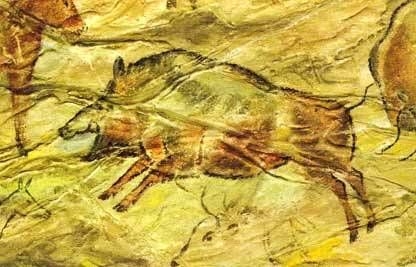
La plus ancienne représentation connue d’un sanglier concerne une peinture pariétale dans la grotte d’Altamira, en Espagne. Elle est d’époque magdalénienne. (Paléolithique supérieur, 12000 ans).
De Perse, de l’Inde, de la Grèce à l’Irlande, il est partout présent dans le monde indo-européen. Il est également présent au Japon et en Chine, au Moyen-Orient, mais sa symbolique se réfère à des mythèmes distincts. (5)
En Grèce, Hercule parvient à rapporter un gigantesque sanglier qui semait la terreur en Arcadie, sur les collines d’Erymanthe. L’animal est transporté vivant sur les épaules. Cet exploit constitue le troisième des douze travaux d’Hercule.
Ailleurs, c’est un autre monstre dévastant l’Etolie, le sanglier de Calydon, que combattent les héros de la Toison d’Or.
Dans la mythologie nordique, le nain Brokk forge un anneau d’or pour Odhin-Wotan, un marteau pour Thor et un sanglier pour Frey.
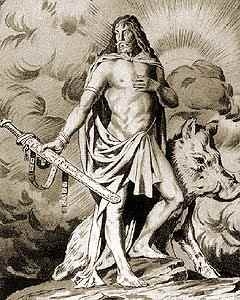 Frey est le dieu de la fertilité, le dieu de la troisième fonction chez les Scandinaves. « Voici un animal qui peut courir nuit et jour, aussi bien sur terre que dans le ciel et sur l’eau. Il va plus vite que n’importe quel cheval. Et ses soies d’or resplendissent tant qu’elles peuvent éclairer les ténèbres les plus profondes. » (6) Du martellement des forges de Brokk, naissent la fidélité, la puissance et la maîtrise. La maitrise du temps et de l’espace.
Frey est le dieu de la fertilité, le dieu de la troisième fonction chez les Scandinaves. « Voici un animal qui peut courir nuit et jour, aussi bien sur terre que dans le ciel et sur l’eau. Il va plus vite que n’importe quel cheval. Et ses soies d’or resplendissent tant qu’elles peuvent éclairer les ténèbres les plus profondes. » (6) Du martellement des forges de Brokk, naissent la fidélité, la puissance et la maîtrise. La maitrise du temps et de l’espace.
C’est en Ardennes (Arduenna sylva), au carrefour des mythes celtes et germaniques, que l’archéologie nous cèdera une petite statuette, hélas décapitée, représentant le seul témoignage connu d’une déesse chevauchant un sanglier. On a évoqué le nom de Diane. Mais celui de Freya, sœur de Frey et déesse de l’amour pourrait s’imposer tout autant.
Chez les Celtes, le sanglier revêt donc une importance fondamentale. Il apparaît sur nombre de monnaies gauloises, et figure comme enseigne ethnique ou guerrière sur les vexillum.

La stèle calcaire d’Euffignix (Haute-Marne), fait état d’un personnage orné d’un torque au cou, avec un sanglier vertical gravé sur sa poitrine. On peut soupçonner le caractère sacertodal de cette stèle, s’il était confirmé que le motif symbolique de la patte droite est bien une crosse. Cette crosse (francique krukkja = béquille) serait de même nature que l’actuel attribut de l’épiscopat chrétien. Il était déjà l’emblème de dignité religieuse sous le paganisme romain, où du nom lituus, il équipait, les augures et les pontifes.
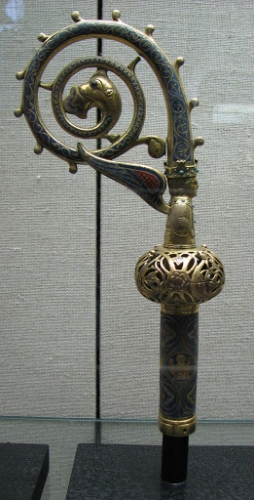 L’archéologie irlandaise de son côté, nous confirme la présence de diverses crosses sur les sites cultuels, de même curieusement, que certains monuments mégalithiques. (7) Sur le côté de la stèle, on peut également distinguer la présence d’un œil. La valeur magico-relieuse de l’ensemble, nous permet d’imaginer le troisième œil, celui qui voit, celui de qui vient la religion. (lat. religio = qui relie)
L’archéologie irlandaise de son côté, nous confirme la présence de diverses crosses sur les sites cultuels, de même curieusement, que certains monuments mégalithiques. (7) Sur le côté de la stèle, on peut également distinguer la présence d’un œil. La valeur magico-relieuse de l’ensemble, nous permet d’imaginer le troisième œil, celui qui voit, celui de qui vient la religion. (lat. religio = qui relie)
Est-ce un hasard, si un autre dieu du panthéon celtique a été trouvé sous le chœur de N.D. de Paris, en 1970 ? Il s’agit de Cernunnos, « le dieu aux cornes de cerf ». On l’a également localisé à Reims, à Vandoeuvres, à Saintes, et il apparaît sur le célèbre chaudron de Gundestrup, accompagné d’un sanglier.
Comme pour relier les fonctions souveraine et productrice, le sanglier constituait la nourriture sacrificielle de la fête de Samain. (ou Samuhain, Samonios dans le calendrier de Coligny, le 1 novembre. La Toussaint en est la survivance christianisée). (8) On le consacre à Lug, qu’on associe à Mercure. (L’un des surnom de Mercure, Moccus = porc, est attesté par une inscription gallo-romaine à Langres).
La légende de Twrch Trwyth (irlandais triath = roi) s’opposant à Arthur, représente le sacerdoce en lutte contre la royauté, à une époque de décadence spirituelle. (9) Le père de Lug, Cian, se transforme en porc druidique, pour échapper à ses poursuivants, avant néanmoins de mourir sous forme humaine.
Paradoxe d’importance, l’ensemble des textes irlandais, même d’inspiration chrétienne, n’accorde pas de mauvaise part au symbolisme du sanglier. Il s’agit là d’une contradiction flagrante avec les tendances de la tradition judéo-chrétienne.
Dans la Bible, le sanglier est associé à l’impureté, aux déchainement des passions, aux forces démoniaques.
Parmi les légendes recueillies par Roger Lecotté, (10) il en est une qui se rapporte au thème du sanglier, et qui concerne le village de Percy, en Seine-et-Marne.
Ste Osmanne, princesse d’Irlande, après de longues pérégrinations, vint s’établir dans la retraite de Féricy. « Avec sa servante, elle bâtit un abri de feuillage et mena une existence austère. Un jour, un jeune seigneur des environs, chassant un sanglier, vit la bête se réfugier auprès de la sainte, alors en prière près d’une fontaine. Malgré les cris des veneurs, les chiens ne pouvaient bouger, et le seigneur, voulant tuer le sanglier demeura figé. Il injuria Osmanne, qu’il prit pour une enchanteresse et se retira. Passant à Sens, il raconta les faits à St Savinien qui se rendit auprès de la solitaire et la reconnut comme une croyante ; aussi il la baptisa avec l’eau de la fontaine, et lui donna, le nom d’Osmanne. »

Le bruit de sa sainteté se répandit partout, et de nombreux fidèles vinrent lui demander soulagement de leurs maux.
Anne d’Autriche délégua deux pèlerins pour obtenir la naissance de Louis XIV, puis envoya un courrier à Féricy pour annoncer l’heureuse nouvelle, et fit don du tabernacle actuel.
Un registre de confrèrie du XVII° siècle porte de nombreuses demandes et procès-verbaux de guérisons ou miracles.
Selon la légende locale, les anciennes cloches de l’église, enfouies en 1789 dans la mare de l’abime, et qui, envasées, n’ont jamais pu être récupérées, se font entendre à ceux qui se penchent au-dessus de l’onde, car elles sonnent encore pour la fête de Ste Osmanne.
Ce texte démontre à lui seul, s’il en était besoin, combien l’animisme est vivace au VII°siècle, (10) et comment il est réintégré par l’Eglise sans autre forme de procès.
A partir de quels critères l’évêque de Sens reconnait-il Osmanne comme une croyante ? Elle dispose de pouvoirs légués par la tradition celto-païenne, c’est-à-dire spécifiques aux coutumes de l’animisme européen. On songe aux oracles de Delphes et à la Pythie officiant en extase, près de la source Castalie. (11)

On songe aux légendes médiévales et aux « sorcières » des forêts profondes. On songe surtout au sanglier comme symbole druidique. On rappellera encore que le nom de « fontaine » désignait initialement une source, et l’on aura posé le décor dans lequel évoluent les acteurs de l’époque.
Sachant que les édifices de la chrétienté médiévale ont été élevés aux lieux même des sites sacrés du paganisme, il resterait à démontrer, au-delà des phénomènes de syncrétisme connus, la part de glissement sacro-religieux réalisée au titre de la Tradition entre la société druidique et la Chrétienté.
Gérard Thiemmonge.
Bibliographie :
- 1) Dictionnaire des symboles, R. Laffont, Paris 1969
- 2) J. Rousseau, La Chasse Sauvage, mythe exemplaire, in Nouvelle Ecole n° 16, Paris 1972
- 3) Au temps des Gaulois, Hachette, Paris 1981
- 4) Dictionnaire de l’ancien français jusqu’au milieu du XIV° siècle, A.J. Greimas, Larousse, Paris 1980
- 5) Chevalier et A. Geerbrant, Op.cit.
- 6) Mabire, les dieux maudits, récits de mythologie nordique, Corpenic, Paris 1978
- 7) Sharkey, Celtic mysteries, the ancient religion, Thames & Hudson, Londres 1975
- 8) J. Rousseau, Op.cit.
- 9) Thème du conflit intrafonctionnel, entre le pouvoir et le sacré.
- 10) Recherches sur les cultes populaires dans l’actuel diocèse de Meaux, CNRS/FF d’Ile-de-France n° IV, Paris 1953
- 11) Basile Pétrakos, Delphes, Editions Clio, Athènes 1977
00:19 Publié dans Traditions | Lien permanent | Commentaires (0) | Tags : traditions, sanglier, bestiaire, bestiaire mythologique, mythologie |  |
|  del.icio.us |
del.icio.us |  |
|  Digg |
Digg | ![]() Facebook
Facebook
jeudi, 31 décembre 2020
Mishima, la mort comme antidote & Mishima et la recherche de l'empereur caché
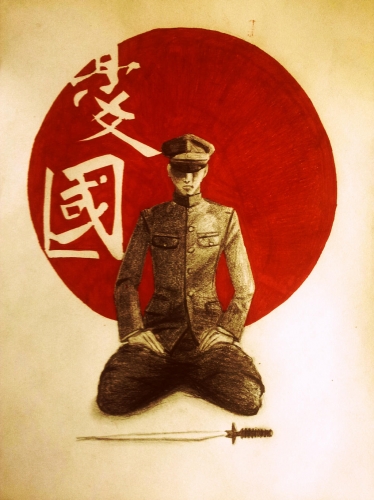
Mishima, la mort comme antidote
Alejandro Linconao
Ex: https://grupominerva.com.ar
La mort comme antidote. L'acier
Mishima interprète l'existence à partir des coordonnées d'un de ses livres de chevet, le Hagakure. Dans L'éthique des samouraïs dans le Japon moderne (Publishing Alliance, 2013), notre auteur fait une analyse de ce classique de l'art martial japonais, visant à donner des réponses à son époque, qui est largement la nôtre. Selon son interprétation du texte classique, nos sociétés sont déséquilibrées. La vie a régné sur l'existence humaine, mais c’est une vie, apathique, superficielle. Une vie de frimeur, une vie opposée à la vertu cachée. Une vie qui a perdu de son intensité parce qu'elle a banni la limite de la mort. Sans cette limite, l'existence est incontrôlable, sans horizons ni objectifs qui méritent d'être nommés ainsi.
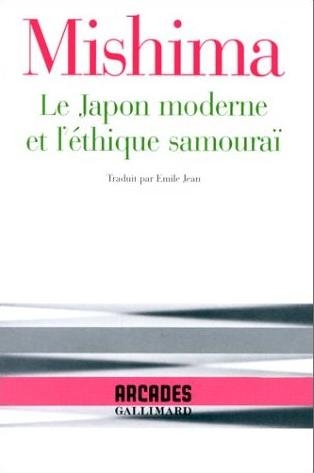 Mishima, dans la lignée de la tradition japonaise, a conçu l'existence comme un équilibre entre des hypothèses opposées, la liberté et la répression, la vie et la mort. La vie est mieux contemplée dans l'ombre de la mort ; sous la teinte mortelle, le vital est lumineux, rayonnant. Embrasser l'existence implique d'embrasser à la fois la vie et la mort, et de cette fusion découlera la vitalité. La vie doit nécessairement être équilibrée avec la mort, sinon la vie sera informe, grotesque, désordonnée.
Mishima, dans la lignée de la tradition japonaise, a conçu l'existence comme un équilibre entre des hypothèses opposées, la liberté et la répression, la vie et la mort. La vie est mieux contemplée dans l'ombre de la mort ; sous la teinte mortelle, le vital est lumineux, rayonnant. Embrasser l'existence implique d'embrasser à la fois la vie et la mort, et de cette fusion découlera la vitalité. La vie doit nécessairement être équilibrée avec la mort, sinon la vie sera informe, grotesque, désordonnée.
Là encore, la pensée japonaise partage des coordonnées avec la pensée occidentale classique. Chez les Grecs, les pères de la philosophie occidentale, l'indésirable est la disproportion, l'illimité, ce qu'ils appelaient l'hybris. Les excès dans tous les domaines, tant dans l'humilité que dans le faste, dans le plaisir et dans la guerre, étaient des déséquilibres répréhensibles. Des déséquilibres qui attirent la colère des dieux et pour lesquels les divinités elles-mêmes peuvent être punies.
L'Occident, déjà perdu dans la pensée de ses origines, détourne son regard de cette condamnation de l'excès et sombre dans l'absurdité de la modernité. La modernité libérale avec sa culture de surproduction, d'hédonisme illimité et de consommation vorace ne donne pas lieu à l'équilibre, à la modération. Tout doit être tiré dans les profondeurs. Pour cette vision d'une jouissance sans douleur, la mort volontaire de Mishima devient un acte de folie. Aveugles au symbole, ils confondent le sacrifice avec le mépris de la vie. Ils ne discernent pas l'acte sacré, le rite qui cherche à rétablir un ordre, à rétablir un équilibre perdu.
Extrait de Mishima et la mort comme antidote dans Mishima Inmortal, Grupo Minerva Ediciones, 2020.
Mishima et la recherche de l'empereur caché
Andrea Scarabelli
Il est évident que la dimension politique est présente dans l’oeuvre de Mishima. Cette oeuvre n'est jamais une chronique, elle ne s'aplatit pas dans la simple réalité, elle s'efforce toujours d'aller au-delà, en passant par des sites métapolitiques inattendus. La Ligue des vents divins fonctionne certes sur le plan politique mais essentiellement sur la base de points de référence spirituels. Il suffit de considérer la division en trois chapitres : le premier consacré à la consultation des dieux, le second à l'action et le troisième à l'épilogue sanglant, au seppuku comme ouverture à la transcendance, à l'anticipation du geste de Mishima et au portrait d'un petit groupe d'hommes jetés au-delà du présent, au-delà de et contre l'histoire, décidés à lutter au nom de toute une civilisation, opprimée par la barbarie. "Ces flammes qui dansaient, partout, à travers l'air dirigé vers le ciel, témoignaient de la fureur avec laquelle les camarades attaquaient. Avec imagination, chacun a vu les courageux personnages de leurs frères d'armes, fidèles jusqu’à la mort, traverser le feu vertigineux, alors qu'ils attaquaient l'ennemi avec des épées brillantes. L'heure tant attendue était arrivée et pour l'atteindre, ils durent retenir longtemps leur colère féroce, tout en aiguisant leurs lames en silence. La poitrine d'Otaguro était enflammée par un vent de joie incontrôlable. "Tous les hommes se battent", murmura-t-il. "Chaque homme".

Ennemi des valeurs modernes et amoureux du Japon traditionnel, Mishima a décidé de faire de sa propre vie le témoignage d'une autre façon d'être au présent : "Je ne fais que répéter les vieux idéaux comme un perroquet, idéaux qui sont maintenant perdus. C'est, si l'on veut, le manifeste de ceux qui se retrouvent nés dans le monde moderne malgré leur appartenance interne à une réalité très différente, thèmes qui relient ce "type humain" à "l'homme différencié" décrit par Julius Evola dans Cavalccare la tigre, 1961. Dans le cas de Mishima, cette "double citoyenneté" est similaire à la "doctrine des deux États" de Sénèque : chacun de nous est simultanément membre de deux communautés, l'une céleste et l'autre terrestre. Bien que nous connaissions tous le monde terrestre, l'autre monde est défini par Evola : « C'est une patrie qui ne peut jamais être envahie, à laquelle on appartient par une naissance différente de la naissance physique, par une dignité différente de toutes celles du monde mondain et qui unit en une chaîne incassable les hommes qui peuvent paraître dispersés dans le monde, dans l'espace et le temps, dans les nations ».
Lorsque la seconde patrie, la patrie céleste, nous oblige à nier les (faux) principes de la première, la mondaine, la désobéissance ne se traduit pas par un anarchisme confus, mais constitue la seule façon de rester fidèle à son propre être. Mais chaque communauté a un empereur, la terrestre a un empereur terrestre, la céleste un empereur céleste. Lorsque l'empereur terrestre laisse tomber son sceptre, ou le donne aux envahisseurs, c'est à l'empereur céleste qu'il faut être fidèle. Une révolution traditionnelle à tous égards, en somme, qui lui fera écrire, en parlant des membres de la Ligue du Vent Divin : "Plus les dieux adoraient, plus ils étaient inquiets de la situation politique du pays. Et au fil du temps, leur ressentiment contre les autorités s'est accru, car ils avaient la preuve qu'ils s'éloignaient de l'idéal de Maître Oen, si bien qu'il fallait vénérer les dieux comme dans les temps anciens. Il est possible que toute la vie de Mishima ait été une recherche ininterrompue de cet empereur occulte.
Japon: monument à Maître Oen.
00:11 Publié dans Littérature, Traditions | Lien permanent | Commentaires (0) | Tags : tradition, traditionalisme, japon, yukio mishima, lettres, lettres japonaises, littérature, littérature japonaise |  |
|  del.icio.us |
del.icio.us |  |
|  Digg |
Digg | ![]() Facebook
Facebook
Sleipnir, le cheval à huit jambes de la mythologie nordique
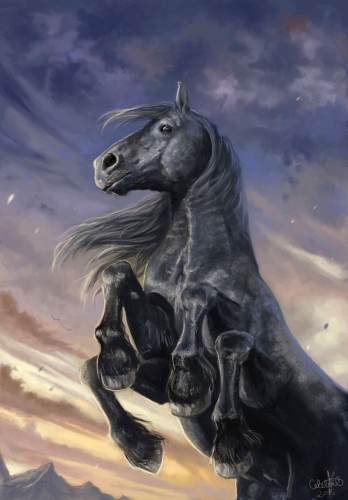
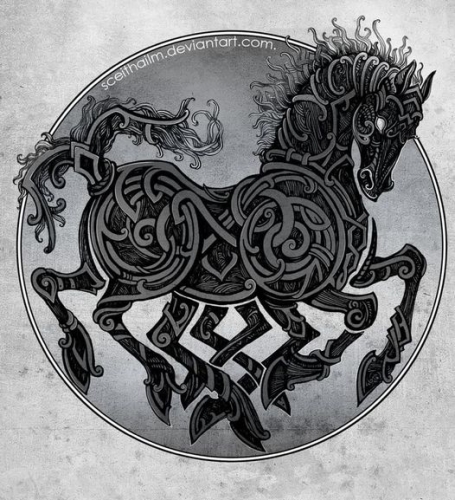
00:05 Publié dans Traditions | Lien permanent | Commentaires (0) | Tags : traditions, mythologie, mythologie nordique, mythologie scandinave, sleipnir, odin, wotan |  |
|  del.icio.us |
del.icio.us |  |
|  Digg |
Digg | ![]() Facebook
Facebook
dimanche, 27 décembre 2020
Eliade et Cioran : l’échange épistolaire sur la fin de l'Europe
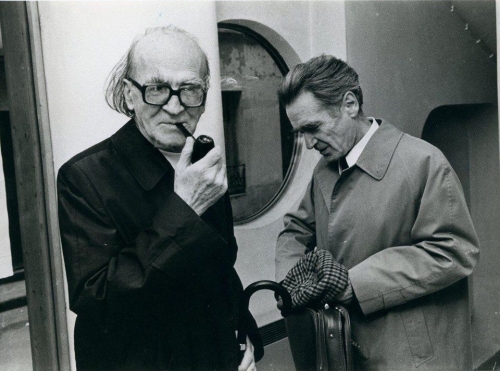
Eliade et Cioran : l’échange épistolaire sur la fin de l'Europe
Par Andrea Scarabelli
Ex : https://blog.ilgiornale.it/scarabelli
Le 22 avril 1986, Mircea Eliade meurt à Chicago. Il avait perdu connaissance deux jours auparavant, abandonné dans sa chaise de lecture : il tenait dans ses mains un livre fraîchement imprimé, contenant un portrait de lui-même, aussi net que sacrément génial. Il s'agissait du livre Exercices d'admiration ; son auteur, Emil Cioran, il l’avait rencontré pour la première fois, de nombreuses années auparavant, autant dires plusieurs vies antérieures, en 1932 de l'autre côté de l'océan. L'"ontologue" Constantin Noica le lui avait présenté. De retour d'une conférence sur Tagore, Eliade était alors l'enfant prodige de la "jeune génération" qui s'était surtout rassemblée autour du "Socrate roumain" Nae Ionescu, chef spirituel d'un groupe d'intellectuels nés à l'aube du XXe siècle, dont beaucoup se sont ensuite répandus à travers l'Europe et le monde dans ce qui fut l'une des dernières diasporas modernes. L'une des plus fécondes, comme l'a souligné Adolfo Morganti il y a quelques années dans le numéro d'Antarès consacré à ce sujet. Elle a dispersé dans le monde entier des génies absolus tels que Cioran et Eliade mais aussi, notamment, Ioan Petru Culianu et Paul Celan, sans oublier Eugène Ionesco, Camilian Demetrescu et Vintilă Horia (selon qui, comme l'indique le titre de l'une de ses œuvres les plus célèbres, même Dieu est né en exil).
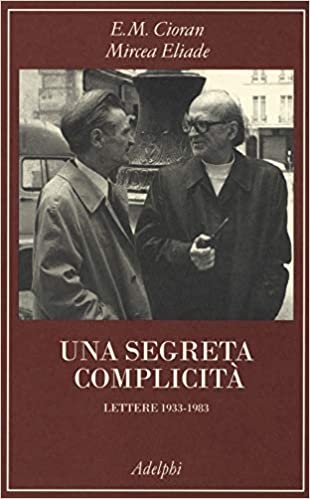 Entre les deux hommes, presque des contemporains, séparés par seulement quatre ans de vie, est née une amitié qui - entre les hauts et les bas de l’existence, comme cela arrive souvent aux hommes dotés de caractère et de profondeur spirituelle - a duré jusqu'à la fin des jours d'Eliade (Cioran le suivra en 1995). Un monument littéraire à cette relation de longue durée entre deux géants de l’esprit est Una segreta complicità (Adelphi), la première édition mondiale de la correspondance entre les deux exilés roumains, d'où émerge une incroyable complémentarité, mêlée d'antagonisme, souvent non exempte de virulente controverse, comme le rappellent les deux éditeurs, Massimo Carloni et Horia Corneliu Cicortaş, mais toujours sous la bannière d’une entente secrète que Cioran a témoigné à Eliade le jour de Noël 1935 :
Entre les deux hommes, presque des contemporains, séparés par seulement quatre ans de vie, est née une amitié qui - entre les hauts et les bas de l’existence, comme cela arrive souvent aux hommes dotés de caractère et de profondeur spirituelle - a duré jusqu'à la fin des jours d'Eliade (Cioran le suivra en 1995). Un monument littéraire à cette relation de longue durée entre deux géants de l’esprit est Una segreta complicità (Adelphi), la première édition mondiale de la correspondance entre les deux exilés roumains, d'où émerge une incroyable complémentarité, mêlée d'antagonisme, souvent non exempte de virulente controverse, comme le rappellent les deux éditeurs, Massimo Carloni et Horia Corneliu Cicortaş, mais toujours sous la bannière d’une entente secrète que Cioran a témoigné à Eliade le jour de Noël 1935 :
"Bien que j'éprouve une sympathie infinie pour vous, je ressens parfois le désir de vous attaquer, sans argument, sans preuve, et sans idées. Chaque fois que j'ai eu l'occasion d'écrire quelque chose contre vous, mon affection s'est accrue. Envers tous les gens que j'aime, j'ai un sentiment si complexe, chaotique et ambigu, que le simple fait d'y penser me donne le vertige. Je suis peut-être le seul, parmi les amis que vous avez, à comprendre vos accès de colère, votre désir de supprimer la continuité de la vie".
C'est, après tout, l'expression vivante d'un personnage titanesque, qui survit non seulement dans la lutte, mais peut-être précisément grâce à la lutte, l'incarnation d'une vision tragique du cosmos, mais en même temps une force vitaliste et foudroyante (ceux qui croient que le sentiment tragique implique une conception sombre et pessimiste de l'existence devraient lire quelque passagers de l’oeuvre de Nietzsche).
Mais l'intérêt de cette correspondance n'est pas seulement biographique. En plus d'enregistrer les étapes et les bifurcations de deux vies exemplaires et paradigmatiques, la succession des lettres - surtout les toutes premières, plus intéressantes de ce point de vue - rend compte directement d'une civilisation à l'agonie, étouffée par la pression des événements, un kaléidoscope des tragédies du XXe siècle, un sinistre prélude à la catastrophe finale, qui retirera à jamais l'Ancien Monde de la liste des acteurs de l'Histoire du Monde. Eliade écrivit à Cioran ce qui suit en novembre 1935, depuis Bucarest:
"Ces dernières semaines, je n'ai fait que penser à la fin apocalyptique de notre époque. J'ai la conviction que tout va s'arrêter très bientôt, peut-être même dans trente, quarante ans ; l'art, la culture, la philosophie - tout ira en enfer. Tout ce qui concerne notre époque (Kali-yuga) va s'effondrer de manière apocalyptique. L'Europe est en train de craquer - de stupidité, d'orgueil, de luciférisme, de confusion. J'espère que la Roumanie n'appartient plus à ce continent qui a découvert les sciences profanes, la philosophie et l'égalité sociale".
Ceux qui naguère auraient défini ces mots comme des "prophéties noires" n'ont qu'à considérer l'état "culturel" actuel de notre civilisation. En comparaison, ces perspectives ne sont peut-être que trop édifiantes.
 De même, la différence entre deux visions du monde opposées concernant l'Est et l'Ouest apparaît chez les deux hommes, Cioran cherchant pour ainsi dire à trouver un Est dans l'Ouest, et Eliade étant poussé à aller dans la direction opposée, sans toutefois se laisser aller à l'exotisme facile, tant à la mode à l’époque que maintenant. Il écrit à Cioran le 23 avril 1941 depuis Lisbonne, où il séjourne en tant qu'attaché de presse à la légation roumaine (le magnifique Journal portugais, publié en italien par Jaca Book, témoigne de son séjour en terres lusitaniennes) : "Vivant face à l'Atlantique, je me sens de plus en plus attiré par des géographies qui m'étaient autrefois insignifiantes. J'essaie de trouver mon salut en dehors de l'Europe. Vasco de Gama est toujours arrivé en Inde".
De même, la différence entre deux visions du monde opposées concernant l'Est et l'Ouest apparaît chez les deux hommes, Cioran cherchant pour ainsi dire à trouver un Est dans l'Ouest, et Eliade étant poussé à aller dans la direction opposée, sans toutefois se laisser aller à l'exotisme facile, tant à la mode à l’époque que maintenant. Il écrit à Cioran le 23 avril 1941 depuis Lisbonne, où il séjourne en tant qu'attaché de presse à la légation roumaine (le magnifique Journal portugais, publié en italien par Jaca Book, témoigne de son séjour en terres lusitaniennes) : "Vivant face à l'Atlantique, je me sens de plus en plus attiré par des géographies qui m'étaient autrefois insignifiantes. J'essaie de trouver mon salut en dehors de l'Europe. Vasco de Gama est toujours arrivé en Inde".
D'ailleurs, avant que son imagination ne revienne des rives ensoleillées de la Lusitanie, l'historien des religions avait été physiquement en Inde une décennie plus tôt. De 1928 à 1931, pour être précis, avant d'être diplômé en 1933 de l'université de Bucarest. Il avait retravaillé et élargi sa thèse de doctorat (dont la version originale a été récemment publiée par les Edizioni Mediterranee, éditée par Cicortaş) pour en faire le volume Yoga. Essai sur les origines du mysticisme indien, publié en 1936 et rapidement envoyé à Cioran, qui le commente comme suit : "En lisant votre Yoga, j'ai réalisé à quel point je suis européen. À chaque étape, j'ai comparé Nietzsche avec lui. Je me sens plus proche des derniers bolcheviks ou derniers hitlériens que de la technique de la méditation. Vos raisons de revenir d'Inde me lient à une vision politique de l'univers".
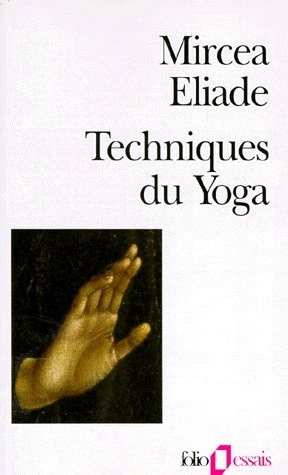 Leur relation épistolaire et humaine survivra à cette Europe dont ils avaient tous deux rédigé le rapport d’autopsie, vivant en ses derniers moments comme l’on vit la fin d'une saison, avec cette amère conscience qui transparaît d'une note du Journal portugais d'Eliade datant de novembre 1942 (un an après la lettre précitée) et écrite dans la ville espagnole d'Aranjuez avec ses mille palais et jardins caressés par le Tage : "Le palais rose. Les magnolias. A côté du palais, des groupes de statues en marbre. Vous pouvez entendre le bruit des eaux du Tage qui se déversent dans la cascade. Une promenade dans le parc du palais : de nombreuses feuilles sur le sol. L'automne est arrivé. Les rossignols. Le minuscule labyrinthe d'arbustes. Des bancs, des ronds-points. Nous sommes les derniers". J'aime à penser que dans cette lointaine année 1942, dans l'œil de la tempête, Eliade parlait implicitement de lui et de son vieil ami, à des centaines de kilomètres de là, mais partageant avec lui un destin bien plus élevé, que même la tragédie européenne qui a suivi n'a pas pu écraser.
Leur relation épistolaire et humaine survivra à cette Europe dont ils avaient tous deux rédigé le rapport d’autopsie, vivant en ses derniers moments comme l’on vit la fin d'une saison, avec cette amère conscience qui transparaît d'une note du Journal portugais d'Eliade datant de novembre 1942 (un an après la lettre précitée) et écrite dans la ville espagnole d'Aranjuez avec ses mille palais et jardins caressés par le Tage : "Le palais rose. Les magnolias. A côté du palais, des groupes de statues en marbre. Vous pouvez entendre le bruit des eaux du Tage qui se déversent dans la cascade. Une promenade dans le parc du palais : de nombreuses feuilles sur le sol. L'automne est arrivé. Les rossignols. Le minuscule labyrinthe d'arbustes. Des bancs, des ronds-points. Nous sommes les derniers". J'aime à penser que dans cette lointaine année 1942, dans l'œil de la tempête, Eliade parlait implicitement de lui et de son vieil ami, à des centaines de kilomètres de là, mais partageant avec lui un destin bien plus élevé, que même la tragédie européenne qui a suivi n'a pas pu écraser.
A partir de 1945, pendant onze ans, ils vivent tous deux à Paris, puis Eliade s'installe aux Etats-Unis, où il reste jusqu'à la fin de ses jours, rencontrant Cioran en France pendant les vacances d'été. Ces "deux Roumains de la ‘jeune génération’, jetés par le destin en Occident" ne cesseront jamais de s'écrire, avec leur patrie tourmentée désormais loin derrière eux, dans une relation destinée à dépasser ce Minuit de l'Histoire qu'était le XXe siècle ("Tout est religieux, puisque l'histoire ne l'est pas" écrivait Cioran à Eliade en 1935, faisant inconsciemment écho au concept de terreur de l'histoire qu'Eliade développerait dans ses écrits, l'idée qu'en dehors de la sphère du sacré, l'histoire s'épuise dans un ensemble d'abattoirs).
Leur relation n'a cessé de se poursuivre, au-delà de l'histoire, au-delà de la douleur: en découvrant le portrait dessiné par son ami, il semble qu'Eliade, juste avant de fermer les yeux et de ne plus jamais les ouvrir, ait souri.
00:47 Publié dans Livre, Livre, Philosophie, Traditions | Lien permanent | Commentaires (0) | Tags : mircea eliade, emilcioran, philosophie, livre, traditions, roumanie |  |
|  del.icio.us |
del.icio.us |  |
|  Digg |
Digg | ![]() Facebook
Facebook
Le culte celtique du gui

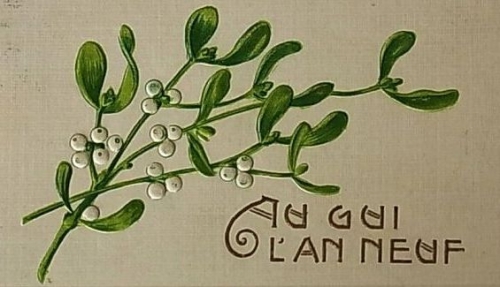
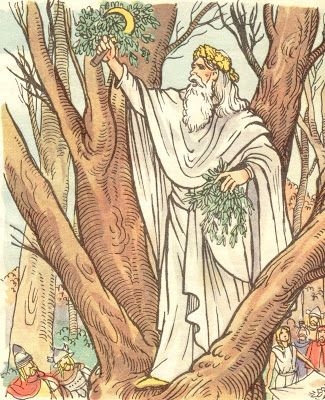
00:45 Publié dans Traditions | Lien permanent | Commentaires (0) | Tags : gui, celtisme, druidisme, traditions |  |
|  del.icio.us |
del.icio.us |  |
|  Digg |
Digg | ![]() Facebook
Facebook
vendredi, 25 décembre 2020
Face au mondialisme, la Table Ronde de la Mémoire
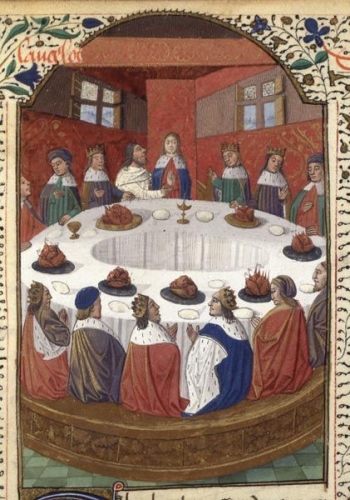
Face au mondialisme, la Table Ronde de la Mémoire
par Paul-Georges Sansonetti
Chers amis,
Voici le texte de la conférence que Paul-Georges devait donner cet été le dimanche matin dans le cadre de la réunion annuelle d'Hyperborée à Roquefavour qui n'a pu se tenir ; texte évidemment capital, mais il y manquera le talent oratoire et les saillies pertinentes et pleines d'humour de notre ami. Ce texte a été envoyé aux habituels participants des journées Hyperborée et à quelques autres amis ; il n'est pas destiné au grand public. Bonne lecture.
Joyeuses fêtes (quand même) à tous.
PEB
Chers Amis,
Cette année sous l’emprise du virus nous plaça dans la pénible obligation de renoncer à notre dimanche matin annuel. Les difficultés se sont multipliées pour nombre d’habitués fidèles à nos partages. L’équipe organisatrice ne pouvait que le déplorer tant ces retrouvailles ne manquent pas d’offrir, avec l’apport amical de chacun, des échanges passionnants à partir de concepts essentiels. Nous ressentons tous que rien ne remplace les rencontres roboratives entre personnes fortement motivées en ce lieu hautement signifiant que constitue la Domus. Peut-être à cause de ce manque et résolument déterminés à s’offrir une revanche, Pierre-Émile Blairon, plusieurs de nos Camarades et votre serviteur se sont décidés à se manifester. À leur demande, J’ai mis par écrit des données - parfois évoquées les autres années - et dont les prolongements et surtout les fondements les plus radicaux devaient être explicités et ramenés à des notions irréductibles car garantes de l’existence d’une société et même d’une civilisation.
En cette période de Solstice d’hiver, l’équipe de Hyperborée Magazine vous adresse des vœux de réussite, de pleine santé et de cette joie que confère la certitude du destin supérieur de l’Europe.
L’ÉCHEC D’UNE FRANCE OPEN FIELD
Ce que nous vivons actuellement apparaît véritablement effarant dès lors que l’on est encore conscient et non partiellement, sinon totalement, décérébré par la «bien-pensance » mondialiste. Des individus de souche étrangère à l’Europe, la plupart incultes, s’érigent en censeur de notre Histoire multimillénaire. Je m’en voudrais de porter un jugement péjoratif sur les communautés bédouine, érythréenne, tamoul ou turkmène. Mais, en inverse, il m’insupporte d’entendre vilipender le génie européen auquel une bonne partie des peuples dit « de couleur » doit l’amélioration des conditions existentielles et, conséquemment, sa survie dont résulte une fécondité des plus proliférative ; nous en subissons – hélas ! – les « débordements ».
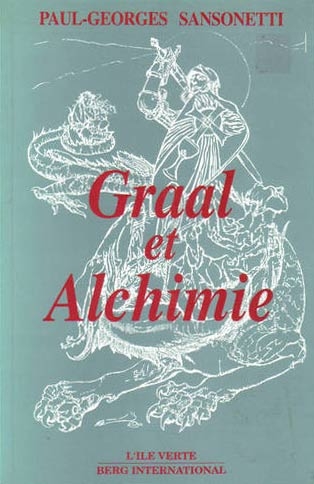 Plusieurs évènements me semblent éminemment symptomatiques de l’effondrement frappant la France et de proches nations européennes. D’abord la fresque peinte à Stains en mémoire de deux figures de la cause « black ». Montrant les visages surdimensionnés de ces personnages, on découvre que le grapheur s’est efforcé d’accentuer ce qui relève de l’appartenance ethnique en épaississant fortement – et même en alourdissant - les morphologies faciales de façon, dirait-on, à les distinguer sans discussion possible d’avec la typologie européenne. Point n’est besoin de les comparer à un visage grec antique ou tiré d’une cathédrale gothique ou encore d’une peinture de la Renaissance pour comprendre que ces deux facies – qu’accompagnait, lors de sa création, une imprécation contre la Police – contribuent à ce qu’une Afrique sub-saharienne impose massivement sa prépondérance en regard d’un autre génotype qualifié, dans le vocabulaire « jeune de banlieue », de « face de craie », de « Gaulois », de « fromage » (sous-entendu « fromage blanc »). « Gaulois » ne m’offusque pas et le rapport à la couleur blanche non plus. Car, à travers ces désignations qui se veulent péjoratives, tout comme par l’apologie de deux représentants du continent noir et quelle que soit la nationalité – américaine et française – qui était la leur, ce qui importe impérativement c’est de proclamer de façon tonitruante que l’on appartient à l’un des quatre (voire cinq) grands groupes raciaux répartis sur notre globe. Victime d’une « sensibilité » inhérente à l’air du temps, le mot « race » ne devrait plus être prononcé. Du reste, on ne cesse de nous assurer d’une façon obsessionnellement réitérée que les races n’existent pas. Il n’y a que l’Humanité avec, admet-on cependant, des apparences différentes. Or, ce sont précisément ces différences qui offrent le plus grand intérêt au niveau civilisationnel. Mais toujours est-il que, selon le message de cette fresque et le slogan Black live matter, renforcé en France par l’affaire Traoré[1], c’est surtout le fait de se reconnaître dans une communauté en fonction de sa couleur de peau qui a favorisé l’émergence d’un mouvement désormais international. Première conséquence, l’idéal d’une société du « vivre ensemble », l’une des facettes de la « mondialisation heureuse » (chère à un célèbre ancien élu bordelais), se voit brutalement remise en cause.
Plusieurs évènements me semblent éminemment symptomatiques de l’effondrement frappant la France et de proches nations européennes. D’abord la fresque peinte à Stains en mémoire de deux figures de la cause « black ». Montrant les visages surdimensionnés de ces personnages, on découvre que le grapheur s’est efforcé d’accentuer ce qui relève de l’appartenance ethnique en épaississant fortement – et même en alourdissant - les morphologies faciales de façon, dirait-on, à les distinguer sans discussion possible d’avec la typologie européenne. Point n’est besoin de les comparer à un visage grec antique ou tiré d’une cathédrale gothique ou encore d’une peinture de la Renaissance pour comprendre que ces deux facies – qu’accompagnait, lors de sa création, une imprécation contre la Police – contribuent à ce qu’une Afrique sub-saharienne impose massivement sa prépondérance en regard d’un autre génotype qualifié, dans le vocabulaire « jeune de banlieue », de « face de craie », de « Gaulois », de « fromage » (sous-entendu « fromage blanc »). « Gaulois » ne m’offusque pas et le rapport à la couleur blanche non plus. Car, à travers ces désignations qui se veulent péjoratives, tout comme par l’apologie de deux représentants du continent noir et quelle que soit la nationalité – américaine et française – qui était la leur, ce qui importe impérativement c’est de proclamer de façon tonitruante que l’on appartient à l’un des quatre (voire cinq) grands groupes raciaux répartis sur notre globe. Victime d’une « sensibilité » inhérente à l’air du temps, le mot « race » ne devrait plus être prononcé. Du reste, on ne cesse de nous assurer d’une façon obsessionnellement réitérée que les races n’existent pas. Il n’y a que l’Humanité avec, admet-on cependant, des apparences différentes. Or, ce sont précisément ces différences qui offrent le plus grand intérêt au niveau civilisationnel. Mais toujours est-il que, selon le message de cette fresque et le slogan Black live matter, renforcé en France par l’affaire Traoré[1], c’est surtout le fait de se reconnaître dans une communauté en fonction de sa couleur de peau qui a favorisé l’émergence d’un mouvement désormais international. Première conséquence, l’idéal d’une société du « vivre ensemble », l’une des facettes de la « mondialisation heureuse » (chère à un célèbre ancien élu bordelais), se voit brutalement remise en cause.
Les tenants forcenés de cette mondialisation péroraient que l’avenir du genre humain serait forcément métissé. J’ai le souvenir d’un certain Nicolas Sarkozy qui, dans un discours en 2008, souhaitait ardemment que la France réussisse « le défi du métissage ». Et, a-t-il ajouté, si cela n’était pas adopté de plein gré par les citoyens, il serait question d’un recours à, je cite, « des méthodes plus contraignantes encore » (grands dieux, lesquelles ?). Toute une intelligentsia n’avait que le mot « métissage » à la bouche et, d’une façon sournoise, durant ces deux dernières années, un nombre conséquent de spots publicitaires, mirent en scène des couples mixtes ou alors une charmante personne issue d’un melting pot afro-caraïbe. La nécessité de prendre en compte l’actuelle modification de population ? Plus que probable, mais aussi, n’en doutons pas, une façon d’habituer le « français de souche » (formule insupportable à des oreilles dûment formatées, de même que le mot « frontière », on va voir pourquoi) à considérer que sa patrie, convertie en un open field, prenait place dans le grand projet planétaire élaboré par le sinistre ploutocrate Georges Soros. Je vais revenir sur open. Auparavant, il nous faut parler d’une série de tragédies à la fois consternantes et significatives.
Le 5 juillet, à Bayonne, un chauffeur de bus se voyait agressé par quatre individus : deux Mohamed, un Moussa et un Selim, tous déjà fort connus, parait-il, des services de Police. Ils se sont acharnés sur leur victime laissée en état de mort cérébrale. La veille, le 4, dans le Lot-et-Garonne, c’est la jeune Mélanie, gendarme de profession, qui était tuée sur le coup par un chauffard, délinquant multirécidiviste, prénommé Yacine quelque chose. Les parents de cette malheureuse jeune femme devaient déclarer, je cite : « Nous portons des valeurs de vivre ensemble et la haine et les messages de haine n’ont pas leur place dans le vivre ensemble ». Tragique ! Et l’on est tenté d’en conclure : laissons-nous assassiner, l’important consiste à ne pas perturber ce fameux et sacro-saint « vivrensemble », instrument prioritaire de l’éradication progressive de notre peuple. Cependant, malgré les prêches lénifiants de la « bien-pensance », ces deux horribles « faits divers » suscitèrent une immense émotion. On pourrait citer des dizaines d’agressions, viols (ou tentatives) mais aussi coups de couteaux dont pâtissent quotidiennement de braves gens qui ont l’infortune de croiser des « chances pour la France ». Le summum de l’horreur fut atteint avec la jeune lyonnaise percutée par une voiture et trainée sur huit-cent mètres. Ajoutons, hélas, une autre jeune femme, assassinée à Nantes dans des conditions effroyables (elle aurait été défigurée). Et puis, au sortir des « vacances » - surtout mentales tant aucune idée force n’habite plus les citoyens - deux nouvelles monstruosités firent l’actualité : décapitation d’un enseignant à Conflans-Ste Honorine. Tragédie suivie d’une seconde décapitation dans la basilique de Nice et un attentat au fusil d’assaut dans la capitale de l’Autriche. Rêvée par de belles consciences allergiques au mot « frontière », l’idéale Humanité, brassant des dizaines d’ethnies non-européennes, sombre chaque jour plus vite dans la violence et le sang. Des mots commencent à sortir des lèvres de politiciens jusque-là idéologiquement frileux : « barbarie », « ensauvagement de la France », « la République en péril ». D’abord simples propos de circonstance destinés à garroter l’hémorragie de leur électorat lorgnant vers les partisans d’un sursaut national, ces mots semblent faibles en regard du terrifiant défi lancé à nos nations européenne : sa soumission par la terreur à un courant religieux, excluant toute concession, qui lui est foncièrement étranger. À l’évidence, nos dirigeants gouvernementaux et les faiseurs d’opinions médiatiques prennent peur. Et pourtant, ils se refusent encore à réagir avec vigueur devant tous ces drames car, pour eux, le seul avenir admissible ne s’inscrit que dans un mélange universel des peuples et des cultures. Alors, posons la question à laquelle ils ne répondront jamais. Pourquoi?
LA NOTION DE FORME ET LA FASCINATION DE L’INFORME.
Depuis des temps fort anciens et sans doute guère possible à dater faute de matériaux narratifs et archéologiques, deux tendances dominantes agissent en sens contraires dans le domaine civilisationnel. La première polarise tout ce qu’exprime l’ordre fait de rigueur et d’harmonie présent dans l’univers. Cet ordre confère à chaque chose une « forme » (une apparence résultant d’une constitution) qui lui correspond ; depuis le plus modeste végétal, sinon minéral, jusqu’à un astre prenant sa place parmi des milliards d’étoiles au sein de la galaxie. Ici, la notion d’ordre est inhérente à celle de « forme » et s’impose comme le contraire de ce que l’on entend en utilisant le terme anglo-saxon open. Il faut redire que la « forme » révèle une identité, autrement dit la capacité d’appartenance à une espèce bien définie. Cette notion est exprimée dans l’Inde arya par le mot Dharma désignant l’ « ordre universel », synonyme de « loi éternelle », et auquel on associe les mots « devoir », « droiture », « vertu ». Le Dharma est emblématisé par une roue comportant généralement huit rayons. Nous sommes là en présence de l’un des symboles fondamentaux. Symbole d’une priorité si l’on veut sortir de l’odieuse parodie de société que nous subissons de nos jours.
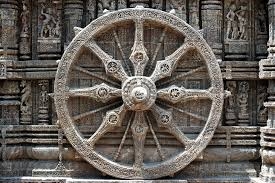
La roue du Dharma, sculpture du temple de Hindu Surya à Konârak, XIIIème siècle. Notez les huit rayons qui manifestent les huit directions cardinales (les quatre principales et les quatre intermédiaires). Plus minces et parfaitement droits, huit autres rayons s’ajoutent à l’ensemble.
Aux personnes qui n’auraient pas dans leur bibliothèque l’indispensable étude intitulée La Roue et le Sablier, de notre ami Pierre-Émile Blairon, nous en conseillons vivement la lecture. Cette roue est une image de référence qui permet de mémoriser le fait qu’entre la périphérie figurant le perpétuel changement – qui marque notre monde – et l’immuabilité du moyeu positionné au centre, il y a les « rayons » énonçant le fait qu’ « éclairement » (de la conscience) et « rectitude » (comportementale) sont indissociables. Le « moyeu » figure ce qui rassemble en un même concept l’origine et l’ultime. Certains parleraient de l’Alpha et de l’Oméga. C’est l’ « invariable milieu » sans lequel tout ce qui existe n’est qu’insignifiance. Expliquons-nous.
Puisqu’il faut aller à l’essentiel, disons que l’une des choses les plus caractéristiques du vécu contemporain c’est l’invraissemblable marécage dans lequel s’enfonce la société. Là, nous abordons la polarité inverse de celle que nous venons d’énoncer. Le mot « marécage » s’impose puisque le socle sur lequel devrait reposer l’état et ses citoyens est devenue meuble, instable, quasiment liquide. De fait, tout ce qui semblait solide se ramollit, se disloque et se décompose. Ainsi en est-il des institutions et des cerveaux qui s’embourbent. Des phrases prononcées par un personnages gouvernemental (remplacé depuis) le prouvent amplement : « manifestation interdite mais autorisée », « l’émotion prime le droit » et surtout « soupçons avérés », impérissable formule car oxymoronique à souhait. Tout cela révèle une dissolution de l’autorité et, par conséquent, le renoncement à maintenir ce qui, depuis longtemps, apparaît comme une République invertébrée au bord de l’écroulement. Face à ce festival de paroles et de réactions, tout à la fois pathétique et burlesque, la symbolisation du Dharma présente un message direct. Et, revenant à la roue, cette figure est de beaucoup plus efficace que la langue de bois (fortement vermoulu) des politiciens et diverses logorrhées ministérielles sinon présidentielles. Dirigeants dépassés et populations désemparées sont emportés par le mouvement de la roue qui, à la fin de notre cycle, s’accélère et semble s’emballer. L’existence du centre – le moyeu - où demeure immuablement ce qui a pouvoir de péréniser un ensemble sociétal est ignoré d’un monde dans lequel les valeurs éthiques ont été remplacées par des concepts aberrants légitimant les faiblesses, les carances, voire les dépravations d’individus désormais sans repères. Et ce, précisément, parce que tout ce qui pouvait reconduire au centre a été effacé ou brisé : les rayons évocateurs de « clarté », de « rectitude », de « droiture » et, en conséquence, de « rigueur » se sont évanouis ; leur existence même est devenue illégitime. Une attitude inflexible, tant sur le plan individuel que collectif, une fermeté au niveau étatique, une exigence face à des propos ou des comportements ineptes sont maintenant impensables dès lors que jugés contraires à je ne sais quel supposé « humanisme » fabriqué afin de dissimuler une veulerie généralisée et, n’hésitons pas à le dire, institutionalisée… Ou peut-être pire encore, témoignant de l’intention non avouée d’altérer les capacités réactives d’un peuple afin, progressivement, de le débiliser. Conditionné au point de n’avoir plus d’instinct de survie, ce peuple est mûr pour son remplacement par une grande armée d’envahisseurs venue d’autres continents.
LA TABLE RONDE COMME EXEMPLE
Repassé récemment sur Arte, un film des années cinquante, signé Richard Thorpe[2], Les Chevaliers de la Table Ronde, montrait une image qui, chez certaines personnes de ma génération, s’imprima emblématiquement : on voyait la fameuse assemblée circulaire des preux arthuriens et leurs épées toutes posées sur la grande table de pierre, pointes vers le centre. Visuellement un soleil de fer ! Moralement une puissance décisionnaire prête à intervenir à tout instant. Les rayons de la « roue dharmique » se sont mués en lames redoutables. Ce rassemblement des épées induit immédiatement l’idée d’unité d’une nation. Unité s’affirmant par le pouvoir de ces aciers lorsque c’est nécessaire. Nos responsables politiques devraient afficher dans leur bureau la photo d’une pareille circularité évacuant toutes les dérisoires « tables rondes » supposées conciliatrices à force de parlottes. Avec le thème d’une élite chevaleresque disposée ainsi, c’est une société « prenant forme » à partir d’un « centre » que manifeste Arthur, personnage dont le nom, de par son origine celtique (art signifiant « ours »), reconduit aux deux constellations marquant le Nord (la Grande Ourse) et le Pôle (la Petite Ourse), autrement dit le double rappel d’un foyer civilisationnel à l’origine de l’Europe.
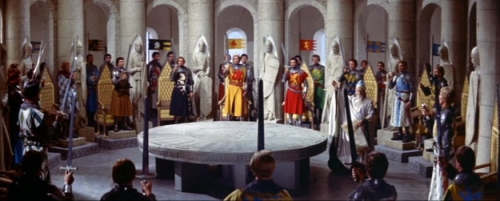
Une image du film de Richard Thorpe. Sur la photo, chaque chevalier s’apprête à poser son épée sur la célèbre Table, pointe vers le centre. En blanc, Merlin lève sa dextre pour consacrer l’assemblée. Image reprise des décennies plus tard dans un second film intitulé Lancelot, premier chevalier, dans lequel Richard Gere incarnait Lancelot et Sean Connery campait un impressionnant roi Arthur. Opus de Jerry Zucker, 1994. Ci-dessous une image de cette production : la Table Ronde rassemblant les épées. Au centre du cercle un feu rituel est allumé. Comme on le voit, une épée manque. C’est celle du chevalier félon, Méléagant.
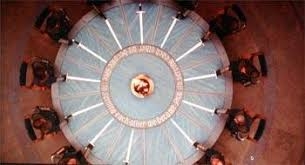
On notera que le centre de la Table reproduit le hiéroglyphe du Soi (un cercle avec un point au milieu) symbolisant le « soleil intérieur », , la partie immortelle d’un être. Ce signe se retrouve sur les gravures rupestres de la Vallée des Merveilles ainsi qu’à Bohuslan en Scandinavie.
Le malheur, aujourd’hui, c’est qu’une telle image n’a plus le pouvoir d’interpeller la mémoire de nos dirigeants et autres postulants aux responsabilités étatiques. Et ne nous leurrons pas, comment parlerait-elle à une partie (conséquente, hélas !) de notre jeunesse française que l’on sait étourdie par un climat sociétal exaltant un hédonisme débridé à base de « shit », d’alcool et d’un vacarmisme musical. Reste, comme toujours, une minorité qui, à rebours d’une indifférence mortifère, se veut farouchement déterminée à ne pas sombrer. Bien que restreint, ce nombre saura voir dans le cercle des épées, évocateur du rougeoiment des forges et d’une brillance héroïque, l’équivalent européen de la roue du Dharma.
En allant à l’essentiel, au point le plus radical du présent imbroglio politico-idéologique, nous dirons que toute l’Histoire de l’Humanité se ramène à l’irréductible antagonisme entre ce qui valorise la (notion de) « forme » et ce qui s’y oppose. Pour la première fois peut-être depuis des temps oubliés, on dirait qu’un courant doctrinaire, disposant de prosélytes dans nombre de nations, a décidé d’éradiquer ce qui, chez divers peuples, se reliait encore, même de façon ténue, à un ordre « principiel ». D’où l’enragement actuel consistant à s’attaquer à l’identité – impliquant, au premier chef, l’épiderme – de ce qu’il est désormais convenu de nommer, dans notre mouvance, « Albo-Européens ». Cette dernière formule, bien que n’étant nullement agressive, voire provocatrice, envers d’autres éthnies sera, n’en doutons pas, considérée de façon malveillante par tout les individus endémiquement déterminés à dénoncer les actes de dissidence d’avec le brassage perçu comme obligatoire des peuples et des cultures.
LE GRAAL AU RENDEZ-VOUS DE L’HISTOIRE
Plusieurs enluminures médiévales montrent la table ronde sous l’aspect d’un disque dont la partie centrale, découpée, présente un vide. Et c’est sur ce circulaire espace que se tient le Graal porté par deux silhouettes immatérielles ailées.
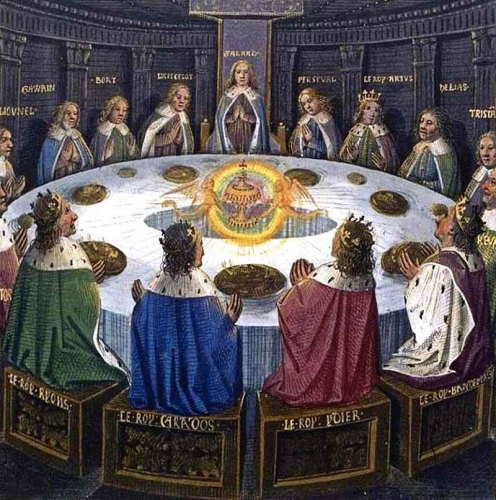
Nimbé d’arc-en-ciel, l’objet surnaturel a l’apparence d’un ciboire d’or et non d’un calice. L’artiste privilégie un réceptacle entièrement clos, sans doute pour occulter ce qu’il contient. Mais, si cette sorte de ciboire émet un rayonnement c’est que, d’une façon évidente, son contenu n’appartient pas au monde humain. On sait qu’il s’agit du sang christique recueilli, dit-on, au moment où le centurion Longinus porta le coup de lance au flanc droit du Galiléen. Or, ce dernier avait, sur le mont Thabor, révélé sa surnature - à Pierre, Jacques et Jean - par la luminosité de ce qu’il est convenu de nommer le « corps glorieux ». Sur l’enluminure, le « sang-lumière » irradie à travers le métal du ciboire. Dans divers articles, il m’a été donné de montrer que ce thème du corps glorieux, fondamental dans l’ésotérisme chrétien, est en fait la transcription de ce qu’incarne Apollon dans le paganisme grec et BaldR dans celui des Germano-Scandinaves ; état que le professeur Régis Dutheil dénomme l’Homme superlumineux. Il s’agit de la cime de l’accomplissement de l’être. Un tel corps de lumière est synonyme d’immortalité et prend place dans l’éternité. Mais le plus important c’est que le sang se révèle porteur de cette lumière. Le sommet de notre identité spirituelle dépend donc d’un sang méritant d’être qualifié de supérieur. Compte tenu que le thème apollinien est indissociable du royaume hyperboréen, allusif à l’origine du génotype « albo-européen », et qu’à leur façon les rédacteurs des récits du Graal exprimèrent une idée semblable, on pourrait dire que l’image du sang-lumière est la transcription d’un apanage suprahumain. Ajoutons à cela que, comportant les fameux quatre Âges, la doctrine du cycle étant commune à tous les peuples indo-européens on comprendra aisément que le retour annoncé de l’ « état » (à la fois sociétal et individuel) premier et, donc, de la toute-puissance que cela suppose, ne peut qu’apparaître intolérable à tous les individus viscéralement (disons psycho-somatiquement) aux antipodes de ce qu’un tel « état » signifie. J’ai montré dans un autre ouvrage en quoi, dans le Perceval de Chrétien de Troyes, la symbolique du Graal et plus particulièrement de son cortège, dans le Perceval, renvoyait à une spécificité génotypique inhérente à l’Europe[3].
Il est possible d’affirmer que le thème du Graal a été conçu, par le biais d’une interrogation sur ce que représente cet objet surnaturel, de façon à raviver la conscience des origines fondatrices de notre nature d’ « Albo-Européens ». C’est comme si le (en fait, je serais tenté d’écrire les) créateur(s) de ce légendaire si prégnant avai(en)t compris que la fin du cycle annonçait un risque majeur de disparition de nos peuples causée par une substitution de population. À l’encontre d’un tel effarant programme, combien révélateur de l’achèvement de ce cycle, les intelligences veillant au devenir de l’Europe (et, principalement, de notre nation, la France) conçurent le thème du Graal. Le lumineux calice d’or fut imaginé afin de remettre en mémoire l’origine civilisationnelle (à l’intention de qui saurait en décrypter la signification véritable) et de livrer une fascinante image porteuse du message suivant : le sang est consubstantiel à l’excellence. En l’occurrence un sang tellement pur qu’il se change en lumière ; et ce, afin, sans doute, d’illuminer l’avenir espéré. Ne dirait-on pas qu’à travers le péril principal qui menace nos peuples, à savoir, redisons-le, un remplacement de population, c’est bien d’un sursaut voué à sauvegarder l’homogénéité ethnique auquel on assiste actuellement dans l’irruption partout de mouvements identitaires confluant avec le bouillonnement des populismes ?
LES U. S. A. AU BORD D’UNE TEMPÊTE POLITIQUE
Quelques mots concernant les U. S. A. Au moment où nous terminions ce texte, les élections présidentielles américaines, aux dires d’informations multiples ne venant pas seulement du camp « trumpiste », ont été accompagnées par un festival de fraudes sans précédent. Si cela devait s’avérer vrai et que les partisans de Trump (je précise bien Trump et non républicain tant un certain nombre d’élus sous cette étiquette se révèlent aussi acquis à l’idéologie mondialiste que leurs adversaires démocrates) parviennent à révéler la forfaiture dans toute son ampleur, alors, indéniablement, nous aurions la preuve qu’un Deep State dirige l’Amérique. Et surtout qu’une énorme entreprise de subversion a été mise en œuvre, selon les vœux des Soros, Clinton et Obama pour mondialiser cette nation en ouvrant les vannes d’une immigration massive. La n° 2 du parti Démocrate, Kamala Harris, incarnant, par ses origines (jamaïcaine et indienne), ce melting pot tant espéré par les sans-frontiéristes enragés, est emblématique d’une société à laquelle travaillent depuis des décennies les concepteurs d’un monde à l’opposé de ce que représente la notion de « forme » évoquée plus haut.
La façon dont, de part et d’autre de l’Atlantique, les médias main stream se sont empressés d’annoncer la victoire de Biden marque de leur part l’irrépressible nécessité de se rassurer : ouf ! Le monde de l’intelligentsia peut respirer, Trump – qui n’a jamais été considéré comme un humaniste à leur sauce – est éliminé du jeu politique. Sauf que d’innombrables fraudes ont été commises par les démocrates et que le camp républicain accumule chaque jour une pléthore de preuves. Si Trump gagne juridiquement, ce sera bien plus qu’un coup de tonnerre dans le ciel de la « bien-pensance ». Ses partisans parlent d’une « tempête » qui se lève sur l’Amérique. Ne nous y trompons pas, nous sommes peut-être à la veille d’un évènement sans précédent qui marquerait la première grande défaite des mondialistes et de leur chef de file, Georges Soros.
Nous ne tarderons pas à savoir ce qu’il en est. En attendant de nous retrouver, excellente continuation à toutes et tous.
Publications de l’équipe d’Hyperborée Magazine :
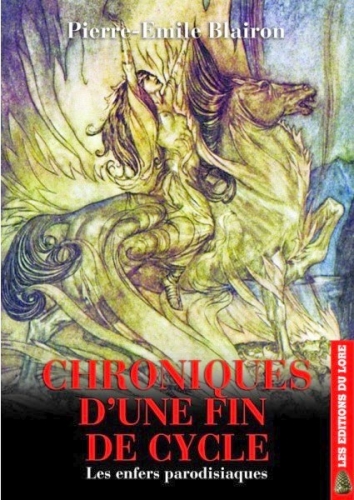
Pierre-Émile Blairon : Chroniques d’une Fin de Cycle. Les enfers parodisiaques. Éditions Les Diffusions du Lore.

Paul-Georges Sansonetti : Les Runes et la Tradition primordiale, réédition d’un ouvrage épuisé. Éditions Les Amis de la Culture européenne.
Présence de la Tradition primordiale (E. A. Poe, G. Meyrink, H. P. Lovecraft, J. R. R. Tolkien, Stanley Kubrick et d’autres…). Éditions de L’œil du Sphinx.

Arcanes Polaires, Éditions Arqa.
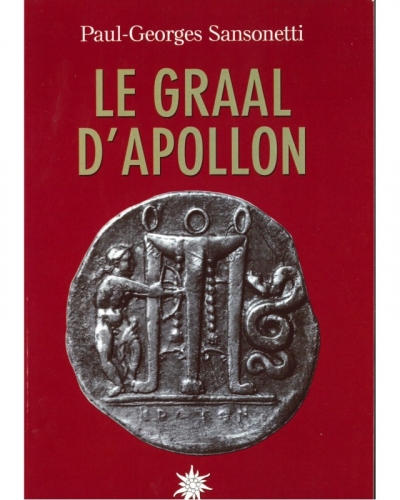
Le Graal d’Apollon, Éditions Terre et Peuple.
Notes:
[1] Comme on vient de l’apprendre, sa sœur, Assa, est consacrée personnalité de l’année par le magazine Time. Après cela, de beaux esprits oseront encore prétendre qu’il n’existe pas un « centre de commandement » transmettant des directives destinées à influencer les esprits.
[2] Robert Taylor tenait le rôle de Lancelot, Ava Gardner celui de Guenièvre et Mel Ferrer du roi Arthur.
[3] Dans Le Graal d’Apollon, Éditions Terre et Peuple, Forcalquier, 2020, chapitre V.
00:31 Publié dans Actualité, Traditions | Lien permanent | Commentaires (0) | Tags : actualité, table ronde, tradition, traditionalisme, paul-georges sansonetti |  |
|  del.icio.us |
del.icio.us |  |
|  Digg |
Digg | ![]() Facebook
Facebook
mercredi, 23 décembre 2020
Evola et l'espace germanophone

Evola et l'espace germanophone
Alberto Lombardo
Ex : http://www.centrostudilaruna.it/
L'Allemagne et, en général, le monde de la culture allemande ont eu une importance centrale pour Evola. Dès son plus jeune âge, il apprend l'allemand afin d'aborder les œuvres de la philosophie idéaliste ; sa doctrine philosophique doit beaucoup à l'idéalisme, mais plus encore à Nietzsche, Weininger et Spengler. En 1933, il fait son premier voyage en Autriche ; tout au long des années 1930 et 1940, il continue à se tenir au courant des productions littéraires et philosophiques allemandes en lisant des essais scientifiques sur les différents sujets qu'il traite lui-même : de la Rome antique (Altheim) à la préhistoire (Wirth, Günther), de l'alchimie (Böhme) à la raciologie (Clauß, Günther encore), de la théorie politique (Spann, Heinrich) à l'économie (Sombart), etc. En général, compte tenu de l'appareil de notes, des références culturelles, et dans un équilibre qui tient compte de toutes les contributions, je ne pense pas du tout exagérer en affirmant que le poids des études publiées en allemand est au moins égal à celui des études italiennes dans l'ensemble de l'œuvre d'Evola.
 Tout cela est très révélateur de l'influence de la culture allemande sur l'œuvre d'Evola. Mais il faut ajouter d'autres données : en rappelant ici ce qui a été mentionné dans la biographie d’Evola, au premier chapitre, je me souviens de l’évocation des longs séjours d'Evola en Autriche et en Allemagne, des nombreuses conférences qui s'y sont tenues, de ses relations avec les représentants de la tradition aristocratique et conservatrice d'Europe centrale et de la révolution conservatrice, etc. En outre, dans les pays germanophones, Evola jouissait, au moins jusqu'à la fin de la Seconde Guerre mondiale, d'une notoriété différente de celle qu'il avait en Italie, car il y fut reçu comme l'exposant d'un courant particulier de la pensée italienne, et cela depuis 1933, année de la publication de Heidnischer Imperialismus. Voici l'opinion d'Adriano Romualdi sur le sujet : "L'action d'Evola en Allemagne n'était pas politique, même si elle a contribué à dissiper de nombreux malentendus et à préparer une entente entre le fascisme et le national-socialisme. Elle a investi le sens de ces traditions qui, en Italie et en Allemagne, ont été évoquées par les régimes, comme le symbole romain et le mythe nordique, le sens du classicisme et du romantisme, ou des oppositions artificielles, comme celle entre la romanité et le germanisme".
Tout cela est très révélateur de l'influence de la culture allemande sur l'œuvre d'Evola. Mais il faut ajouter d'autres données : en rappelant ici ce qui a été mentionné dans la biographie d’Evola, au premier chapitre, je me souviens de l’évocation des longs séjours d'Evola en Autriche et en Allemagne, des nombreuses conférences qui s'y sont tenues, de ses relations avec les représentants de la tradition aristocratique et conservatrice d'Europe centrale et de la révolution conservatrice, etc. En outre, dans les pays germanophones, Evola jouissait, au moins jusqu'à la fin de la Seconde Guerre mondiale, d'une notoriété différente de celle qu'il avait en Italie, car il y fut reçu comme l'exposant d'un courant particulier de la pensée italienne, et cela depuis 1933, année de la publication de Heidnischer Imperialismus. Voici l'opinion d'Adriano Romualdi sur le sujet : "L'action d'Evola en Allemagne n'était pas politique, même si elle a contribué à dissiper de nombreux malentendus et à préparer une entente entre le fascisme et le national-socialisme. Elle a investi le sens de ces traditions qui, en Italie et en Allemagne, ont été évoquées par les régimes, comme le symbole romain et le mythe nordique, le sens du classicisme et du romantisme, ou des oppositions artificielles, comme celle entre la romanité et le germanisme".
À partir de 1934, Evola tient des conférences en Allemagne : dans une université de Berlin, à la deuxième Nordisches Thing de Brême, et au Herrenklub de Heinrich von Gleichen, représentant de l'aristocratie allemande (il était baron) avec lequel il noue une "amitié cordiale et fructueuse". Evola a rappelé cette expérience importante en 1970 : « Chaque semaine, une personnalité allemande ou internationale était invitée à ce club de Junkers. Je dois dire, cependant, que si nous nous étions attendus à voir des géants blonds aux yeux bleus, la déception aurait été grande, car pour la plupart, ils étaient petits et ventrus. Après le dîner et le rituel des toasts, l'invité devait donner une conférence. Pendant que ces messieurs fumaient leurs cigares et sirotaient leurs verres de bière, j'ai parlé. C'est alors qu'Himmler a entendu parler de moi ».
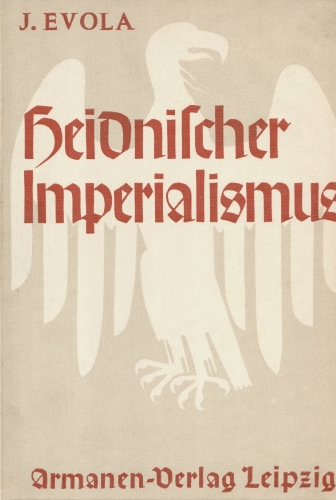
Il est en effet très probable que l'attention des milieux officiels pour Evola soit née après ses premières conférences en Allemagne. Ses relations avec le national-socialisme étaient ceux d’une collaboration externe, et surtout avec divers secteurs de la SS, dont l'Ahnenerbe ; Evola a exprimé des paroles très positives à l'égard de "l'ordre" dirigé par Himmler, même dans l'après-guerre, ce qui lui a valu, d'une part, la critique prévisible de ses détracteurs et, d'autre part a conduit à une réinterprétation - dans l'historiographie et le même "sentiment mondial" de la droite radicale d'après-guerre - du national-socialisme en tant que mouvement populaire dirigé par une élite guerrière-ascétique. Des nombreuses données d'archives publiées aujourd'hui, il ressort une image d'Evola qui a été prise en considération mais toujours soigneusement observée par les milieux officiels allemands.
Après la guerre mondiale, la renommée d'Evola dans les pays germanophones a diminué; son immobilité physique semble l'avoir empêché, entre autres, de poursuivre ses voyages à l'étranger. Ce n'est qu’au cours de ces dernières décennies qu'Evola a fait l'objet d'une sorte de redécouverte, grâce surtout à Hans Thomas Hansen, qui a traduit (et retraduit) une bonne partie de ses œuvres, avec le consentement d'Evola lorsqu'il était encore en vie, et qui est considéré à juste titre comme l'un des plus grands connaisseurs de la pensée et de la vie d'Evola. Outre la revue fondée et animée par Evola, Gnostika (qui, comme son titre l'indique, a des intérêts essentiellement ésotériques), ces dernières années, diverses activités sont nées qui s'inspirent de diverses manières de l'œuvre d'Evola, parmi lesquelles méritent d'être mentionnées les revues allemandes Elemente et Renovatio Imperii et surtout la revue autrichienne Kshatriya, dirigée par Martin Schwarz (auteur de la bibliographie la plus complète d'Evola à ce jour), avec une empreinte "d’orthodoxie évolienne" plus marquée. En outre, des conférences sur le penseur et des traductions de ses autres œuvres commencent s’organiser.
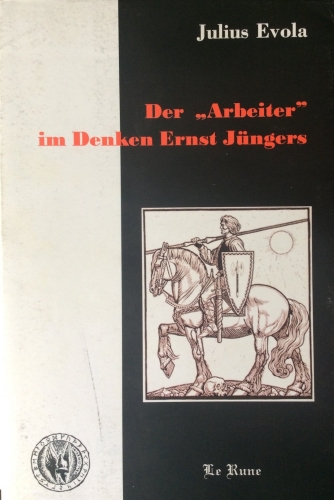
En outre, le centenaire de la naissance d'Evola, en 1998, a été l'occasion pour diverses publications allemandes de se souvenir de lui avec de nombreux articles, parmi lesquels ceux qui ont été publiés dans la revue Nation & Europa (qui a été publié pendant un demi-siècle, et auquel Evola lui-même a collaboré au début des années 50), Criticon et la prestigieuse Zeitschrift für Ganzheitforschung, autre revue à laquelle Evola a contribué (au début des années 60) et qui a été fondée et dirigée pendant longtemps par Walter Heinrich (jusqu'à sa mort en 1984), qui était un grand ami d'Evola. Par curiosité, nous tenons à signaler que pour l'occasion, de nombreux groupes et ensembles musicaux allemands et autrichiens ont consacré un disque à l'écrivain traditionaliste, intitulé Riding the Tiger.
* * *
Bien que certains éléments politiques de l'histoire de l'Italie et de l'Allemagne semblent similaires (le processus d'unification nationale dans la seconde moitié du XIXe siècle, la participation commune à la Triple Alliance, l'Axe Rome-Berlin), Evola identifie dans la "tradition germanique" des traits qui différencient clairement - dans un sens positif - les pays germanophones de l'Italie. Ainsi, tout d'abord, "on peut dire qu'en Allemagne, le nationalisme démocratique de masse de type moderne n'a fait qu'une apparition fugace. […]. Le nationalisme en ce sens, sur fond démocratique, n'a pas dépassé le phénomène éphémère du parlement de Francfort de 1848, en liaison avec les soulèvements révolutionnaires qui, à cette époque, faisaient rage dans toute l'Europe (il est significatif que le roi de Prusse Frédéric Guillaume IV ait refusé l'offre, qui lui avait été faite par ce parlement, de devenir le chef de toute l'Allemagne car en l'acceptant, il aurait également accepté le principe démocratique - le pouvoir conféré par une représentation populaire – l’obligeant à renoncer à son droit légitime, même s'il était limité à la seule Prusse). Et Bismarck, en créant le second Reich, ne lui a pas du tout donné une base "nationale", voyant dans l'idéologie correspondante le principe de désordres dangereux pour l'ordre européen, tandis que les conservateurs du Kreuzzeitung accusaient le nationalisme d'être un phénomène "naturaliste" et régressif, étranger à une tradition et à une conception supérieures de l'État". En marge de cette forme "naturaliste" de nationalisme, les pays germanophones ont cultivé un esprit différent, celui du Volk, qui a animé l'esprit pangermanique. Le courant Völkisch, qui a également joué un rôle considérable dans la genèse du national-socialisme, trouve ses racines dans les discours de Fichte à la nation allemande, dans Arndt, Jahn et Lange et surtout dans le Deutschbund et la Deutsche Bewegung . C'est dans cette diversité d'origines que nous avons le premier écart entre l'Italie et l'Allemagne.
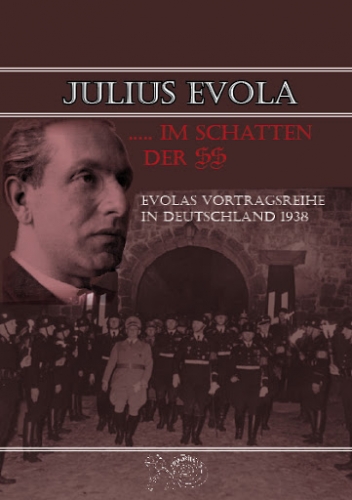 Mais les différences, du point de vue de l’environnement, sont beaucoup plus marquées. Dans son essai sur le Troisième Reich, qui décrit les courants culturels complexes et souvent irréductibles qui ont coopéré à sa genèse, Evola écrit : "Après la Première Guerre mondiale, la situation en Allemagne était nettement différente de celle de l'Italie. [...] Mussolini a dû créer presque tout à partir de rien, en ce sens qu'au moment de combattre la subversion rouge et de remettre l'État sur pied, il ne pouvait pas se référer à une tradition au sens le plus élevé du terme. Tout bien considéré, ce qui était menacé n'était que l'extension de l'Italie démocratique du XIXe siècle, avec un héritage du Risorgimento influencé par les idéologies de la Révolution française, avec une monarchie qui régnait mais ne gouvernait pas et n’avait pas d’articulations sociales solides. En Allemagne, les choses étaient différentes. Même après l'effondrement militaire et la révolution de 1918, et malgré le marasme social, il y avait encore des vestiges profondément enracinés dans ce monde hiérarchique, parfois encore féodal, centré sur les valeurs de l'État et de son autorité, faisant partie de la tradition précédente, en particulier du prussianisme. […]. En fait, en Europe centrale, les idées de la Révolution française n'ont jamais pris autant d'ampleur que dans les autres pays européens" .
Mais les différences, du point de vue de l’environnement, sont beaucoup plus marquées. Dans son essai sur le Troisième Reich, qui décrit les courants culturels complexes et souvent irréductibles qui ont coopéré à sa genèse, Evola écrit : "Après la Première Guerre mondiale, la situation en Allemagne était nettement différente de celle de l'Italie. [...] Mussolini a dû créer presque tout à partir de rien, en ce sens qu'au moment de combattre la subversion rouge et de remettre l'État sur pied, il ne pouvait pas se référer à une tradition au sens le plus élevé du terme. Tout bien considéré, ce qui était menacé n'était que l'extension de l'Italie démocratique du XIXe siècle, avec un héritage du Risorgimento influencé par les idéologies de la Révolution française, avec une monarchie qui régnait mais ne gouvernait pas et n’avait pas d’articulations sociales solides. En Allemagne, les choses étaient différentes. Même après l'effondrement militaire et la révolution de 1918, et malgré le marasme social, il y avait encore des vestiges profondément enracinés dans ce monde hiérarchique, parfois encore féodal, centré sur les valeurs de l'État et de son autorité, faisant partie de la tradition précédente, en particulier du prussianisme. […]. En fait, en Europe centrale, les idées de la Révolution française n'ont jamais pris autant d'ampleur que dans les autres pays européens" .
A une occasion bien précise, Evola mentionne la théorie juridique du droit international de Carl Schmitt. Le philosophe politique allemand avait exprimé l'idée de l'effondrement du droit international coutumier européen (ius publicum europaeum), qui s'est produit, approximativement, après 1890, et l'affirmation conséquente d'un droit international plus ou moins formalisé. Ici, cependant, nous ne sommes pas entièrement de l'avis de Schmitt", écrit Evola, expliquant que "contrairement à l'opinion de beaucoup, en ce qui concerne l'action menée par Bismarck, tant en Allemagne qu'en Europe, tout n'est pas "en ordre". […]. Plus que Bismarck, il nous semble que Metternich a été le dernier "Européen", c'est-à-dire le dernier homme politique qui ait su ressentir le besoin d'une solidarité entre toutes les nations européennes qui ne soit pas abstraite, ou dictée uniquement par des raisons de politique "réaliste" et d'intérêts matériels, mais qui fasse également référence aux idées et à la volonté de maintenir le meilleur héritage traditionnel de l'Europe". Contrairement à Baillet, Evola était donc plutôt critique à l'égard de Bismarck, qui n'avait pas, selon la vision traditionnelle des évoliens, le courage de s'opposer de manière systématique et rigoureuse au monde moderne et à la subversion (sous sa forme économico-capitaliste), mais devait dans certains cas s'y résoudre.
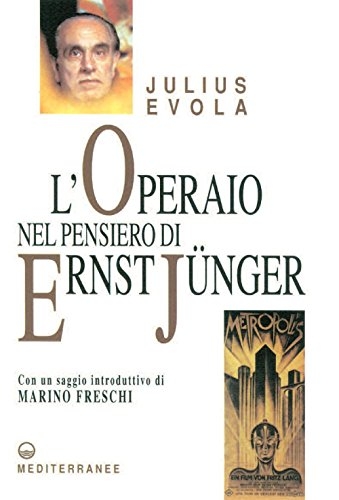 La même Allemagne de Frédéric II puis de Guillaume II, tout en conservant les structures et l'ordre d'un État traditionnel (Obrigkeitsstaat), dans lequel la même bureaucratie et le même appareil d'État apparaissaient presque comme les organes d'un ordre, contenait les germes de la dissolution, due aux idées des Lumières qui avaient commencé à filtrer - de façon plus subtile qu'ailleurs - dans les différentes instances. Si le jugement d'Evola sur le code de Frédéric, préservant l'ordre divisé en Stände est positif, c'est parce que, pour l'époque où il a été créé, ce code a mieux préservé que tout autre les structures féodales et hiérarchiques précédentes. Celles-ci, à travers la tradition prussienne, s'enracinent dans l'Ordre des Chevaliers Teutoniques et leur reconquête des terres baltes : un ordre ascético-chevaleresque formé par la discipline et une organisation hiérarchique stricte. Ainsi, dès son plus jeune âge, Evola pressent l'absurdité de la "guerre civile européenne" qu'il va devoir néanmoins mener, en tant que très jeune officier, à la frontière austro-italienne, celle du Karst : l'Italie prend parti contre ce qui reste de la meilleure tradition européenne. "En 1914, les Empires centraux représentaient encore un vestige de l'Europe féodale et aristocratique dans le monde occidental, malgré des aspects indéniables d'hégémonie militariste et quelques alliances suspectes avec le capitalisme présent surtout dans l'Allemagne wilhelminienne. La coalition contre eux était ouvertement une coalition du Troisième pouvoir contre les forces résiduelles du Deuxième pouvoir [...]. Comme peu d'autres dans l'histoire, la guerre de 1914-1918 présente toutes les caractéristiques d'un conflit non pas entre États et nations, mais entre les idéologies de différentes castes. Les résultats directs et attendus ont été la destruction de l'Allemagne monarchique et de l'Autriche catholique, les résultats indirects l'effondrement de l'empire du tsar, la révolution communiste et la création, en Europe, d'une situation politico-sociale si chaotique et contradictoire qu'elle contenait toutes les prémisses d'un nouvel embrasement. Et ce fut la Seconde Guerre mondiale" .
La même Allemagne de Frédéric II puis de Guillaume II, tout en conservant les structures et l'ordre d'un État traditionnel (Obrigkeitsstaat), dans lequel la même bureaucratie et le même appareil d'État apparaissaient presque comme les organes d'un ordre, contenait les germes de la dissolution, due aux idées des Lumières qui avaient commencé à filtrer - de façon plus subtile qu'ailleurs - dans les différentes instances. Si le jugement d'Evola sur le code de Frédéric, préservant l'ordre divisé en Stände est positif, c'est parce que, pour l'époque où il a été créé, ce code a mieux préservé que tout autre les structures féodales et hiérarchiques précédentes. Celles-ci, à travers la tradition prussienne, s'enracinent dans l'Ordre des Chevaliers Teutoniques et leur reconquête des terres baltes : un ordre ascético-chevaleresque formé par la discipline et une organisation hiérarchique stricte. Ainsi, dès son plus jeune âge, Evola pressent l'absurdité de la "guerre civile européenne" qu'il va devoir néanmoins mener, en tant que très jeune officier, à la frontière austro-italienne, celle du Karst : l'Italie prend parti contre ce qui reste de la meilleure tradition européenne. "En 1914, les Empires centraux représentaient encore un vestige de l'Europe féodale et aristocratique dans le monde occidental, malgré des aspects indéniables d'hégémonie militariste et quelques alliances suspectes avec le capitalisme présent surtout dans l'Allemagne wilhelminienne. La coalition contre eux était ouvertement une coalition du Troisième pouvoir contre les forces résiduelles du Deuxième pouvoir [...]. Comme peu d'autres dans l'histoire, la guerre de 1914-1918 présente toutes les caractéristiques d'un conflit non pas entre États et nations, mais entre les idéologies de différentes castes. Les résultats directs et attendus ont été la destruction de l'Allemagne monarchique et de l'Autriche catholique, les résultats indirects l'effondrement de l'empire du tsar, la révolution communiste et la création, en Europe, d'une situation politico-sociale si chaotique et contradictoire qu'elle contenait toutes les prémisses d'un nouvel embrasement. Et ce fut la Seconde Guerre mondiale" .
Comme mentionné ci-dessus, Evola a exprimé une opinion nettement positive sur la tradition autrichienne. La ligne dynastique continue des Habsbourg a joué un rôle important dans cette évaluation (Evola s'était exprimé en termes très positifs envers Maximilien Ier) ; dans la période où il vivait à Vienne, Evola a respiré ce qui restait de l'ancienne atmosphère de la Felix Austria (de « l’Autriche heureuse », et il est entré en contact avec ce climat culturel et spirituel et surtout avec des hommes chez qui, pour reprendre les mots d'Ernst Jünger, "la catastrophe avait certes quitté ses ombres [...], mais elle s'était limitée à en effacer la sérénité innée sans la détruire. On pouvait parfois voir [...] une patine de cette souffrance que l'on pourrait appeler autrichienne et qui est commune à tant de vieux sujets de la dernière vraie monarchie. Avec elle, on a détruit une forme de plaisir de vivre qui était inimaginable dans d'autres pays européens depuis des générations, et les traces de cette destruction se font encore sentir chez les individus. […]. Ici, dans le Reich, si l'on ne tient pas compte de l'épuisement général des forces, on commence tout au plus à constater la disparité des couches sociales ; ici, en revanche, les différences entre les différentes ethnies s'ouvrent comme des gouffres".
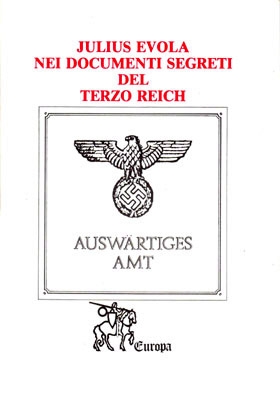 Dans cet humus historique des années de l'entre-deux-guerres, dans lequel les liens sentimentaux et éthiques de beaucoup avec la tradition impériale précédente étaient encore forts - la monarchie des Habsbourg d'Autriche avait au moins formellement conservé, jusqu'au Congrès de Vienne, la propriété du Saint Empire romain - Evola a également eu l'occasion de percevoir directement l'attachement populaire généralisé à la monarchie, et de l'expliquer en ces termes : "Sans exhumer des formes anachroniques, au lieu d'une propagande qui "humanise" le souverain pour captiver les masses, presque sur le modèle de la propagande américaine pour les élections présidentielles, il faut voir dans quelle mesure les traits d'une figure caractérisée par une certaine supériorité et dignité innées peuvent avoir une action profonde, dans un cadre approprié. Une sorte d'ascétisme et de liturgie du pouvoir pourrait jouer un rôle ici. Précisément ces traits, s'ils renforceront le prestige de celui qui incarne un symbole, devraient pouvoir exercer sur l'homme grossier une force d'attraction, voire une fierté à l'égard du sujet. En outre, même à une époque assez récente, nous avons eu l'exemple de l'empereur François-Joseph qui, tout en plaçant entre lui et ses sujets le vieux cérémonial sévère, sans pour autant imiter du tout les rois "démocratiques" des petits États du Nord, jouissait d'une popularité particulière, non vulgaire". Dans la même veine, en 1935, écrivant sur la possibilité d'une restauration impériale en Autriche, Evola rapporte ce que les représentants de la pensée conservatrice et monarchique dans ce pays préconisaient : "Le postulat, quant à lui, est celui auquel tout esprit non encombré de préjugés peut également adhérer, à savoir que le régime monarchique, en général, est celui qui peut le mieux garantir un ordre, un équilibre et une pacification intérieure, sans avoir à recourir au remède extrême de la dictature et de l'État centralisé, à condition qu'il subsiste chez les individus la sensibilité spirituelle requise par tout loyalisme. Cette condition, selon ces personnalités, serait présente dans la majeure partie de la population autrichienne, ne serait-ce que pour la force d'une tradition et d'un mode de vie pluriséculaire".
Dans cet humus historique des années de l'entre-deux-guerres, dans lequel les liens sentimentaux et éthiques de beaucoup avec la tradition impériale précédente étaient encore forts - la monarchie des Habsbourg d'Autriche avait au moins formellement conservé, jusqu'au Congrès de Vienne, la propriété du Saint Empire romain - Evola a également eu l'occasion de percevoir directement l'attachement populaire généralisé à la monarchie, et de l'expliquer en ces termes : "Sans exhumer des formes anachroniques, au lieu d'une propagande qui "humanise" le souverain pour captiver les masses, presque sur le modèle de la propagande américaine pour les élections présidentielles, il faut voir dans quelle mesure les traits d'une figure caractérisée par une certaine supériorité et dignité innées peuvent avoir une action profonde, dans un cadre approprié. Une sorte d'ascétisme et de liturgie du pouvoir pourrait jouer un rôle ici. Précisément ces traits, s'ils renforceront le prestige de celui qui incarne un symbole, devraient pouvoir exercer sur l'homme grossier une force d'attraction, voire une fierté à l'égard du sujet. En outre, même à une époque assez récente, nous avons eu l'exemple de l'empereur François-Joseph qui, tout en plaçant entre lui et ses sujets le vieux cérémonial sévère, sans pour autant imiter du tout les rois "démocratiques" des petits États du Nord, jouissait d'une popularité particulière, non vulgaire". Dans la même veine, en 1935, écrivant sur la possibilité d'une restauration impériale en Autriche, Evola rapporte ce que les représentants de la pensée conservatrice et monarchique dans ce pays préconisaient : "Le postulat, quant à lui, est celui auquel tout esprit non encombré de préjugés peut également adhérer, à savoir que le régime monarchique, en général, est celui qui peut le mieux garantir un ordre, un équilibre et une pacification intérieure, sans avoir à recourir au remède extrême de la dictature et de l'État centralisé, à condition qu'il subsiste chez les individus la sensibilité spirituelle requise par tout loyalisme. Cette condition, selon ces personnalités, serait présente dans la majeure partie de la population autrichienne, ne serait-ce que pour la force d'une tradition et d'un mode de vie pluriséculaire".
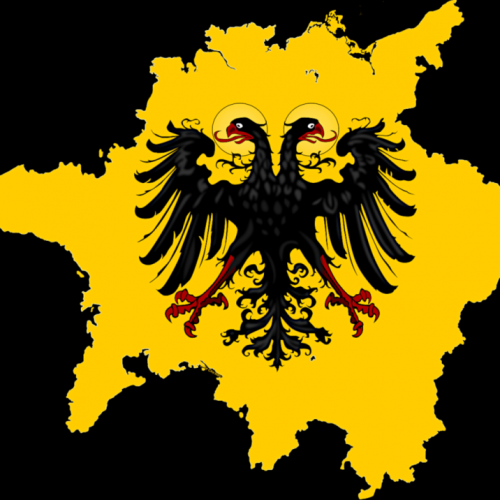
Le problème de l'Anschluss, de l'annexion de l'Autriche à l'Allemagne nationale-socialiste, a été, dans les années qui l'ont précédé, au centre d'un vaste débat international. Les juristes et les hommes politiques l'ont abordée sous des angles différents ; Evola n'était pas d'accord sur ce point avec son ami Othmar Spann, qui, écrit Evola, n'était apprécié ni en Autriche ni en Allemagne pour la courageuse cohérence de ses idées. En parlant du sociologue viennois, Evola a déclaré : "Les Autrichiens ne lui pardonnent pas ses sympathies pour l'Allemagne, tandis que les Allemands ne lui pardonnent pas les critiques qu'il a formulées à l'encontre du matérialisme raciste". Elargissant son regard à l'école organiciste viennoise et au monde culturel autrichien, Evola a exposé ses vues en ces termes : "On ne peut pas se résigner à abaisser une nation, qui a la tradition que l'Autriche a eue, au niveau d'un petit Etat balkanique. Ce n'est pas une simple question d'autonomie politique, c'est essentiellement une question de culture et de tradition. Historiquement, la civilisation autrichienne est inséparable de la civilisation germanique. Il n'est pas possible aujourd'hui pour l'Autriche de s'émanciper à cet égard et de commencer à suivre sa propre voie. C'est précisément parce qu'elle est paralysée, réduite à l'ombre de son ancien moi, qu'elle est obligée de se lier le plus étroitement possible à l'Allemagne, de s'appuyer sur elle, d'en tirer les éléments qui peuvent garantir l'intégrité de son patrimoine allemand". Evola a poursuivi en affirmant que, du côté positif, l'Autriche aurait à son tour beaucoup à transmettre à l'Allemagne en termes de tradition culturelle. Mais au-delà du niveau purement intellectuel, "Dans le domaine des traditions politiques, l'antithèse est encore plus visible. Il faut demander à ces intellectuels germanophiles ce qu'ils entendent par tradition germano-autrichienne. La tradition autrichienne était une tradition impériale. Héritier du Saint-Empire romain, le Reich autrichien, du moins formellement, ne pouvait pas se dire allemand. En droit, elle était supranationale, et en fait elle négligeait un groupe de peuples dont la race, les coutumes et les traditions étaient très différentes, un groupe dont l'élément allemand ne constituait qu'une partie. Il n'est pas non plus nécessaire de dire que la direction de l'Empire autrichien avait néanmoins un caractère allemand et était dirigée par une dynastie germanique. Du point de vue des principes, cela compte aussi peu que le fait que les représentants du principe supranational de l'Église romaine étaient en grande partie italiens. Si l'on doit parler d'une tradition autrichienne, conclut Evola, c'est à une tradition impériale qu'il faut se référer. Maintenant, qu'est-ce qu'une telle tradition peut avoir à faire avec l'Allemagne, si l'Allemagne signifie aujourd'hui le national-socialisme" . Francesco Germinario a écrit à ce propos que pour Evola "une Autriche liée à ses racines catholiques, et dans laquelle, surtout, la mémoire des Habsbourg est restée vivante, était beaucoup plus proche des valeurs de la Tradition qu'une Allemagne submergée par la nouvelle vague de modernisation promue par le nazisme".
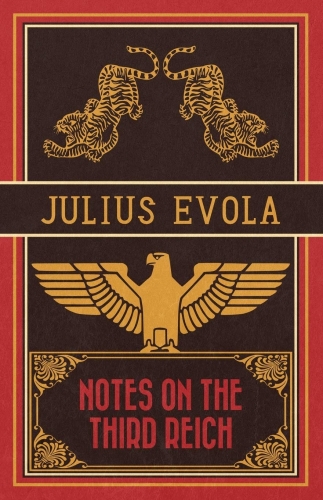
Les positions critiques d'Evola à l'égard du nazisme s'exprimaient déjà en ces termes en 1935, dont le philosophe traditionaliste accusait les excès populistes, sociaux et gauchistes. Le ton est particulièrement critique dans ce cas, car la comparaison est avec l'Autriche, en laquelle Evola a vu précisément l'héritière spirituelle de la plus haute tradition européenne. D'autre part, c'est une ligne d'interprétation et d'historiographie appréciable, et qu'Evola a maintenue même dans l'après-guerre, tendant à séparer les différents éléments et les divers courants qui opéraient dans le national-socialisme pour les juger séparément. Il a conclu sa lecture politique de la situation internationale en déclarant : "Si l'on ne veut pas se résigner à la perte de l'ancienne tradition supranationale d'Europe centrale, l'Autriche devrait tourner son regard non pas tant vers l'Allemagne que vers les États qui lui succéderont, en ce sens qu'elle devrait voir dans quelle mesure il est possible de reconstruire une conscience commune d'Europe centrale comme base non seulement pour la solution de problèmes économiques et commerciaux très importants mais éventuellement [...] aussi pour la formulation d'un nouveau principe politique unitaire de type traditionnel".
En ce qui concerne la Seconde Guerre mondiale, dont l'issue est sans doute considérée par Evola comme la dernière phase de l'effondrement de la civilisation européenne, l'écrivain traditionaliste dénonce les fautes morales des puissances occidentales : "Himmler a été responsable d'une tentative de sauvetage in extremis (considérée par Hitler comme une trahison). Par l'intermédiaire du comte Bernadotte, il a transmis une proposition de paix séparée aux Alliés occidentaux afin de pouvoir poursuivre la guerre uniquement contre l'Union soviétique et le communisme. On sait que cette proposition, qui, si elle avait été acceptée, aurait peut-être pu assurer un destin différent à l'Europe, en évitant la "guerre froide" qui a suivi et la communisation de l'Europe au-delà du "rideau de fer", a été clairement rejetée sur la base d'un radicalisme idéologique aveugle, tout comme l'offre de paix faite par Hitler, de sa propre initiative, à l'Angleterre en des termes raisonnables dans un célèbre discours de l'été 1940, lorsque les Allemands étaient le camp vainqueur.
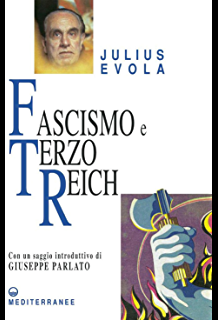 Même après la Seconde Guerre mondiale, Evola a gardé un œil sur les pays germanophones. Sa vision était celle d'une admiration pour la nouvelle résurrection économique opérée par les Allemands après être sortie du champs de ruines qu’elle était dans la seconde période de l'après-guerre ("cette nation a pu se relever complètement d'une destruction sans nom. Même sous l'occupation, elle a surpassé les nations victorieuses elles-mêmes sur le plan industriel et économique et a repris sa place de grande puissance productrice"). et pour le courage avec lequel la République fédérale avait banni le danger communiste de sa politique ("Les Allemands font toujours les choses avec cohérence. Donc aussi dans le jeu de la conformité démocratique. Ils ont mis en place une démocratie modèle comme un système "neutre" - nous dirions presque administratif, plutôt que politique - à la fois équilibré et énergique. Contrairement à l'Italie, l'Allemagne, précisément du point de vue d'une démocratie cohérente, a proscrit le communisme. La Cour constitutionnelle allemande a statué ce qui correspond à l'évidence même des choses, à savoir qu'un parti qui, comme le parti communiste, ne suit les règles démocratiques que dans une fonction purement tactique et de couverture, ayant pour objectif final déclaré la suppression de tout courant politique opposé et l’avènement de la dictature absolue du prolétariat, ne peut être toléré par un État démocratique qui ne veut pas creuser sa propre tombe") . Mais, malgré cela, la guerre avait alors produit un vide, un vide spirituel qui n'était plus comblé : "Contre tout cela, il est surprenant, en République fédérale, l'absence de toute idée, de tout "mythe", de toute vision supérieure du monde, de toute continuité avec l'Allemagne précédente". Toujours dans le domaine de la culture, Evola constate un glissement général, une sorte d'"échec" général aux positions courageuses et avant-gardistes des intellectuels allemands dans les années - selon Evola, très prospères et rentables sous le profil culturel - du Reich national-socialiste. Dans son jugement négatif, Evola prend comme exemple de cet effondrement Gottfried Benn et Ernst Jünger (tombant avec cela dans des erreurs de vue assez grossières).
Même après la Seconde Guerre mondiale, Evola a gardé un œil sur les pays germanophones. Sa vision était celle d'une admiration pour la nouvelle résurrection économique opérée par les Allemands après être sortie du champs de ruines qu’elle était dans la seconde période de l'après-guerre ("cette nation a pu se relever complètement d'une destruction sans nom. Même sous l'occupation, elle a surpassé les nations victorieuses elles-mêmes sur le plan industriel et économique et a repris sa place de grande puissance productrice"). et pour le courage avec lequel la République fédérale avait banni le danger communiste de sa politique ("Les Allemands font toujours les choses avec cohérence. Donc aussi dans le jeu de la conformité démocratique. Ils ont mis en place une démocratie modèle comme un système "neutre" - nous dirions presque administratif, plutôt que politique - à la fois équilibré et énergique. Contrairement à l'Italie, l'Allemagne, précisément du point de vue d'une démocratie cohérente, a proscrit le communisme. La Cour constitutionnelle allemande a statué ce qui correspond à l'évidence même des choses, à savoir qu'un parti qui, comme le parti communiste, ne suit les règles démocratiques que dans une fonction purement tactique et de couverture, ayant pour objectif final déclaré la suppression de tout courant politique opposé et l’avènement de la dictature absolue du prolétariat, ne peut être toléré par un État démocratique qui ne veut pas creuser sa propre tombe") . Mais, malgré cela, la guerre avait alors produit un vide, un vide spirituel qui n'était plus comblé : "Contre tout cela, il est surprenant, en République fédérale, l'absence de toute idée, de tout "mythe", de toute vision supérieure du monde, de toute continuité avec l'Allemagne précédente". Toujours dans le domaine de la culture, Evola constate un glissement général, une sorte d'"échec" général aux positions courageuses et avant-gardistes des intellectuels allemands dans les années - selon Evola, très prospères et rentables sous le profil culturel - du Reich national-socialiste. Dans son jugement négatif, Evola prend comme exemple de cet effondrement Gottfried Benn et Ernst Jünger (tombant avec cela dans des erreurs de vue assez grossières).
* * *
Extrait de Via della Tradizione 125 (2002), pp. 37-50.
Cet article a été republié sans les notes de bas de page.
00:54 Publié dans Révolution conservatrice, Traditions | Lien permanent | Commentaires (0) | Tags : julius evola, allemagne, autriche, révolution conservatrice, europe centrale, mitteleuropa, tradition, traditionalisme |  |
|  del.icio.us |
del.icio.us |  |
|  Digg |
Digg | ![]() Facebook
Facebook
mardi, 22 décembre 2020
Les amoureux de la fin du monde : le mouvement chrétien sioniste
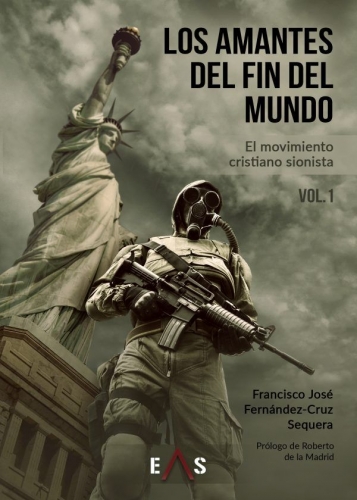
Les amoureux de la fin du monde : le mouvement chrétien sioniste
Introduction au livre « Les amoureux de la fin du monde ». Sur le mouvement chrétien sioniste
par Francisco José Fernàndez-Cruz Sequera
"Je bénirai ceux qui te béniront, et je maudirai ceux qui te maudiront ; et en toi seront bénies toutes les familles de la terre ».
Genèse 12:3.
Une croyance, c’est un modèle mentalement produit au départ d'un fait, réel ou imaginaire, qui cherche simultanément à satisfaire un désir, parfois perçu comme un besoin par l'individu, modèle pour lequel une explication rationnelle est inconnue ou inacceptable. Les individus qui partagent une croyance ou un modèle idéal, rendent bien compte de cette définition. Cela donne lieu à la naissance de dogmes, posés comme s'il s'agissait de faits réels. Ces dogmes élaborent des normes morales conséquentes, nécessaires pour les maintenir dans la durée.
Cette croyance irrationnelle donne lieu à l'apparition de formes de pensée que nous appelons « pensée magique » et « pensée religieuse », qui se situent au même niveau en ce qui concerne leur vérification empirique. La magie [1] et la religion [2] sont des modi operandi d’une pensée, qui se connecte à un type de connaissance sans fondement rationnel, en prétendant que la pensée religieuse a son origine dans une connaissance révélée par une divinité. Par conséquent, ce type de pensée place son origine dans un mystère, compris comme englobant toute réalité qui dépasse les possibilités humaines de leur compréhension. Julio Caro Baroja[3] a déclaré que la religion et la magie dans le monde ancien faisaient partie d'un seul et même système, dans lequel les rites religieux étaient souvent liés à des actes magiques, et que chaque groupe de croyances religieuses avait sa propre magie particulière. Cela étant, on peut affirmer que la pensée magique consiste en un mode de pensée et de raisonnement qui conduit à tirer des conclusions ou des idées basées sur des hypothèses non justifiées empiriquement, souvent de nature surnaturelle, en attribuant une relation de cause à effet, soit un lien logique de cause à effet, entre elles, pour expliquer un phénomène extérieur à la personne elle-même.
La pensée magique est une forme de raisonnement, dans laquelle la logique déductive rationnelle est utilisée pour expliquer une réalité extérieure, pour expliquer le fonctionnement de celle-ci, sans aucun support empirique. Comme on dirait vulgairement, c'est "tricher dans la solitude"... pour toujours gagner. Ainsi, la pensée magique projette les propriétés de son expérience psychologique sur une réalité biologique ou inerte, avec un but ou une intention prédéterminée. Elle consiste à croire que les pensées personnelles en soi peuvent avoir des effets sur la réalité en dehors de la personne ou du groupe, ou que penser à quelque chose équivaut à le faire. Il s'agit donc d'un type de raisonnement causal qui cherche des coïncidences entre des actes et des événements, ce qui génère la croyance erronée que ses propres pensées, paroles ou actions vont causer ou éviter un fait concret, d'une manière qui défie les lois naturelles de cause à effet communément acceptées par la logique et la science. S'inscrit également dans la pensée magique, le transfert de concepts issus de l'observation biologique, sur la manière dont fonctionnerait la nature inanimée. La conséquence de ce qui précède est que le sujet ou le groupe social dans lequel il est intégré, attribue des relations causales entre des actions et des événements qui ne sont pas rationnellement liés entre eux, ou dont le lien de causalité logique n'est pas empiriquement démontrable, et que le consensus scientifique n'accepte pas comme valables.

Cette façon de penser est prédominante en matière de religion, de religiosité populaire et de superstition, car dans ces formes de pensée, on part d'un présupposé qui met en relation les rituels religieux, les prières, les sacrifices ou l'observance d'un tabou ou les croyances non critiques dans les dogmes, avec certaines attentes de sanction, de bénéfice et de récompense dans la réalité matérielle actuelle, ou dans une hypothétique réalité future ou parallèle de caractère surnaturel. En psychologie clinique, elle peut amener un patient à éprouver la peur d'accomplir ou de s'abstenir d'accomplir certains actes, ou d'héberger certaines pensées, en raison de sa croyance dans la corrélation entre ce comportement et son résultat souvent désastreux pour lui-même.
A tout moment et en tout lieu, la pensée magique a pris une forme religieuse pour tenter d'expliquer, par son eschatologie, l'origine et la fin du monde. Il y a toujours eu des groupes religieux qui, à partir d'une croyance irrationnelle, ont fixé la date, le jour et l'heure de la fin du monde ou de la « fin des temps » ; mais, au moins jusqu'au moment d'écrire ces lignes, celle qui annonçait la fin des temps ou du monde, n'est pas arrivée.
Les chrétiens n'ont pas été étrangers à cette vision magique de l'existence, héritée dans leur cas des juifs dont sont issues leurs croyances. Dans le judaïsme, les différentes écoles rabbiniques associées à des traditions différentes, associent l'arrivée d'un "sauveur" du peuple "choisi" par leur Dieu, le Messie, comme un signe eschatologique, qu'elles attendent depuis des milliers d'années comme un événement historique, variant notamment de l'une à l'autre, sans préjudice du fait que toutes partagent leur origine dans les prophéties du Tanakh, ou canon hébreu de la Bible, et fondent leur croyance sur des interprétations consolidées dans la littérature rabbinique. Il en va de même pour l'idée de la restauration du Temple de Jérusalem, ou pour celle du retour du peuple d'Israël sur la "Terre promise", qui sont également comprises et interprétées comme des prophéties eschatologiques ou des événements historiques futurs d'occurrence inexorable. Et cette diversité de croyances et d'interprétations ayant le même fondement, s'étend à des questions telles que la résurrection des morts, le jugement final, la création ou le gouvernement divin. Il n'est donc pas surprenant que l'eschatologie chrétienne soit si proche de celle du judaïsme, puisqu'elle se fonde sur les évangiles du premier siècle qui reflètent la tradition juive et sur les enseignements des théologiens ultérieurs basés sur cette tradition.
Les premiers chrétiens attendaient avec impatience la seconde venue du Christ[4], et cette croyance avait sa raison d'être dans les revendications mêmes de Jésus, le rabbin à l'origine du mouvement chrétien. Selon les textes de ses propres disciples, il a annoncé son retour après sa propre mort : "En vérité, je vous le dis, il y en a ici qui ne mourront pas avant d'avoir vu le Fils de l'homme venir dans son royaume" (Mt. 16, 28).
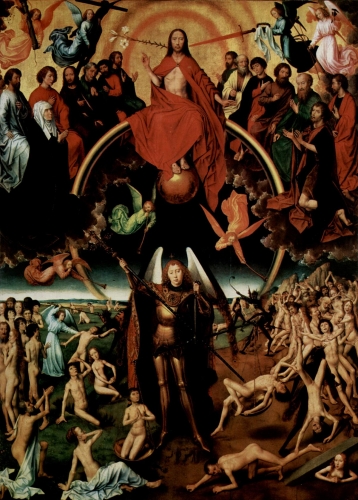
Mais les chrétiens de l'Église primitive, après les premières décennies sans le retour de celui qu'ils reconnaissaient comme le fils de Dieu, ont réalisé que l'histoire pouvait durer beaucoup plus longtemps qu'ils ne le pensaient initialement, ce qui a amené certains à s'interroger sur l'accomplissement de la prophétie du Nouveau Testament, en disant
"Qu'est-il advenu de la promesse que le Christ viendrait, car depuis la mort de nos ancêtres, tout est resté le même depuis que le monde a été fait ?" (2 Pet. 3:4) [5]
Et l'apôtre Pierre leur répondit : "Frères, n'oubliez pas que pour le Seigneur, un jour est comme mille ans, et mille ans sont comme un jour. (2 Pet. 3:8).
À partir du cinquième siècle, le christianisme a dû faire face à la concurrence d'autres religions ou d'initiatives philosophiques comme le mithraïsme, qui a donné lieu à des pratiques de sortilèges et d'incantations, en plus de l'astrologie ; ou à des doctrines d'un niveau spirituel excentrique comme le néoplatonisme, contre lequel le christianisme, par le biais de la controverse philosophique, s'est battu. L'aspect le plus important de ce débat est peut-être la différenciation ultérieure entre la theurgia, magie cérémonielle, propre à une vision du monde donnée ; et la goeteia, qui en vient à être la "magie inférieure", peut-être associée par la suite à la "magie noire".
Une fois le monde antique détruit par le christianisme, et établi comme seule religion pouvant être professée, déjà au cours du Moyen Age et de la Réforme protestante, la théologie chrétienne a traité des quatre derniers états de l'être humain : la mort, le jugement, l'enfer et la gloire ; qui s'expliquent à partir de l'eschatologie chrétienne, en partant de la prophétie des événements qui sont censés se produire, de la Grande Tribulation, dans laquelle le rôle de l'Antéchrist deviendra prépondérant, à la Parousie, "glorieuse venue" ou seconde venue de Jésus-Christ, puisque la première se serait produite entre l’an 6 av. J.C. et la fin de l'existence de Jésus, coïncidant avec la "fin des temps".

Sur la base de ces éléments, les croyances chrétiennes divergent dans l'interprétation des textes et des prophéties évangéliques, forgeant leurs propres multiples versions de ce qui doit arriver. Mais ce sur quoi ils s'accordent, c'est qu'il y aura des signes qui précéderont la "fin des temps", bien qu'ils ne soient pas d'accord non plus sur ce que sont exactement ces signes. Mais, en général, prenons comme point de référence ceux annoncés par l'apôtre Paul, qui soulignait qu'après un temps d'attente, et avant la venue du Christ, trois choses devraient se produire :
1) La proclamation de l'Evangile doit atteindre toutes les nations : "Et ce message du Royaume sera prêché dans le monde entier, afin que toutes les nations le connaissent ; et alors viendra la fin" (Mt. 24:14).
2) A la fin de l'histoire, Israël sera réconcilié avec le Christ et sera sauvé : "Une partie d'Israël tiendra jusqu'à ce que tous les païens soient entrés, alors tout Israël sera sauvé" (Rom. 11:25).
3) Et enfin, "l'apostasie générale", une crise religieuse mondiale dans laquelle l'Antéchrist régnera :
"Ne craignez aucun message spirituel comme si c'était le jour du Seigneur qui est déjà venu. Avant ce jour, la rébellion contre Dieu doit venir en premier, quand l'homme du péché qui sera assis dans le temple de Dieu et sera adoré apparaîtra, il viendra avec une grande puissance et avec des signes mensongers et des miracles. Il utilisera toutes sortes de maux pour tromper" (2 Thess. 2:1-12).
La seule chose qu'un observateur objectif et impartial sait bien, c'est que si l’adepte d’une religion messianique de ce type n'aime pas une série d'événements ou de prévisions sur ce qui va se passer, il a tellement de possibilités de choisir qu'il trouvera difficilement une "heure de fin" à son goût et à sa mesure. Les avantages de la pensée magique.
Et la vérité est qu'il n'y a pas de mal à croire en ce que l'on veut, ni à se donner, seul ou en groupe, les explications de l'origine et de la fin de ce qui existe. Notre but n'est pas de nier l'existence d'une réalité surnaturelle, qui ne peut être démontrée empiriquement, puisque l'acceptation ou non d'une proposition religieuse ou d’une autre relève de la sphère très personnelle de chaque individu et de chaque communauté humaine. Il s'agit de mettre en évidence la volonté des juifs, des sionistes et des chrétiens sionistes de déduire de leurs croyances particulières un destin politique pour la planète entière, qui serait d'application générale, forcée et violente, imposée au reste de l'espèce humaine et à la planète entière en général. Et c'est ce qui s'est déjà produit avec différentes religions en différents lieux et à différents moments, c'est ce qui se produit aujourd'hui avec le mouvement sioniste chrétien évangélique comme bélier du sionisme et du judaïsme, qui tente de nous conduire à une guerre finale dans laquelle se réalisent les prophéties de son eschatologie biblique millénariste, née bien avant l'arrivée du premier juif en Europe et la contamination de la culture occidentale par la vision juive de l'existence. Un fait qui s'est produit grâce à l'influence de la communauté juive elle-même insérée en Europe, des hérésies chrétiennes du judaïsme et, enfin, du sionisme.
Pour commander l'ouvrage: https://editorialeas.com/producto/los-amantes-del-fin-del-mundo/
Notes :
1] L'art ou la science cachée qu'il est censé produire, par certains actes ou paroles, ou avec l'intervention d'êtres imaginaires, donne des résultats contraires aux lois naturelles.
2] Le culte de l'être humain envers les entités auxquelles sont attribués des pouvoirs surnaturels, à travers lesquels on recherche une connexion avec le divin et le surnaturel, ainsi qu'un certain degré de satisfaction spirituelle par la foi ou la dévotion, afin de surmonter la souffrance et d'atteindre le bonheur.
3] Caro Baroja, Julio. Les sorcières et leur monde. Madrid. Alianza Editorial. 1961. Pages 38 à 49.
4] "Bientôt, très bientôt, viendra celui qui doit venir et ne tardera pas" (Hebr. 10, 37). "Dieu, qui est le juge, est déjà à la porte. "La fin de toutes choses est proche" (1 P. 4, 7). "Oui, venez vite, amen. Viens, Seigneur Jésus" (Apoc. 22:20).
5] La Reina Valera est l'une des traductions espagnoles de la Bible les plus fréquemment utilisées par les protestants hispanophones. L'actuelle Reina Valera est le résultat d'une série de révisions effectuées par les Sociétés bibliques unies sur l'une des premières traductions de la Bible en espagnol: la Bible de l'ours de 1569. Dans un sens plus large, elle inclut les révisions faites par d'autres entités qui se basent sur les textes de la Reina Valera. La traduction du moine espagnol con-verti au protestantisme, Casiodoro de Reina, connue sous le nom de Bible de l'Ours de 1569, a la particularité d'être la première traduction de la Bible à être faite à partir des textes en langue originale ; utilisant le Texte Masorétique pour l'Ancien Testament, et le Textus Receptus pour le Nouveau Testament. Avant la publication de l'œuvre complète de Casiodoro de Reina, les Bibles existantes (ou une partie d'entre elles) en langue espagnole étaient des traductions faites à partir de la Vulgate de Saint Jérôme de Stridon. La Bible de l'ours a été publiée à Bâle, en Suisse, le 28 septembre 1569, et son traducteur était Casiodoro de Reina, un religieux espagnol converti au protestantisme. Elle a été surnommée Reina Valera parce que Cipriano de Valera en a fait la première révision en 1602. La Reina Valera a été largement répandue pendant la Réforme protestante du XVIe siècle. Pendant plus de quatre siècles, elle a été la seule Bible en usage au sein de l'église protestante hispanophone. Aujourd'hui, la Reine Valera, avec plusieurs révisions au fil des ans (1862, 1909, 1960, 1995, 2011), est l'une des Bibles en langue espagnole les plus utilisées par de nombreuses églises chrétiennes issues de la Réforme protestante, y compris les églises évangéliques, ainsi que par d'autres groupes confessionnels chrétiens, tels que l'Église adventiste du septième jour, l'Église de Jésus-Christ des Saints des Derniers Jours, l'Église de Dieu Ministère de Jésus-Christ International, le Gideons International et d'autres chrétiens protestants non confessionnels. Avant la Réforme protestante, la traduction des Saintes Écritures dans les langues vernaculaires était interdite par le décret du Concile de Trente, et les quelques traductions qui existaient devaient prendre comme base textuelle la Vulgate latine, qui était le texte officiel de l'Église catholique. Le travail de Casiodoro de Reina a la particularité d'être la première traduction complète de la Bible en espagnol faite à partir des langues originales, en utilisant, comme mentionné ci-dessus, le texte dit Masorétique pour l'Ancien Testament, et le texte dit Textus Receptus, pour le Nouveau Testament. La Bible préalpine et la Bible alphonsine (premières versions de la Bible complète en espagnol) sont des traductions faites à partir du latin. Avant la publication de la Bible de l'Ours, il n'existait que des versions partielles de la Bible des langues hébraïque et grecque en espagnol, telles que la Bible d'Albe et la Bible de Ferrare (contenant l'Ancien Testament) et les textes de Juan Pérez de Pineda et Francisco de Enzinas (Nouveau Testament). La Bible de Casiodoro de Reina reflète la beauté littéraire de ce qu'on appelle l'âge d'or de la littérature espagnole. Dans Historia de los heterodoxos españoles, le savant catholique Marcelino Menéndez Pelayo fait l'éloge de La Biblia del Oso d'un point de vue littéraire, qu'il considère comme mieux écrite que les versions catholiques de Felipe Scío de San Miguel (1793) et Félix Torres Amat (1825).
00:23 Publié dans Livre, Livre, Traditions | Lien permanent | Commentaires (0) | Tags : livre, traditions, traditionalisme chrétien, christianisme, chrétiens sionistes, théologie politique, eschatologie, millénarisme |  |
|  del.icio.us |
del.icio.us |  |
|  Digg |
Digg | ![]() Facebook
Facebook
lundi, 21 décembre 2020
Boris Nad : préface à son livre The Reawakening of Myth

Boris Nad : préface à son livre The Reawakening of Myth
(Éditions PRAV, 2020)
https://pravpublishing.com/the-reawakening-of-myth/
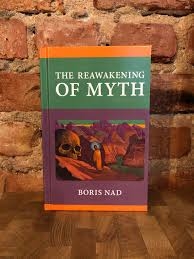 Le livre qui vous est présenté, The Reawakening of Myth, est la suite de deux ouvrages : The Return of Myth et The Awakening of Myth. Le premier, The Return of Myth, a été publié en Serbie en 2010. Le livre initialement intitulé The Awakening of Myth a été, pour diverses raisons, intitulé par l'éditeur Towards the Post-History of the World et publié à Belgrade en 2013. The Return of Myth était un ouvrage assez volumineux, comptant plus de trois cents pages, composé de plusieurs livres de différents genres littéraires, comprenant aussi un recueil de poésie. Le deuxième livre était une sélection d'essais explorant et abordant divers topoi mythiques. Au risque de se donner un satisfecit, on pourrait dire que, dans ces derniers livres, l'auteur a exploré des domaines très divers : de la géographie et de l'histoire sacrée à l'histoire de l'art, de la géopolitique à la mythologie, de la "théorie hyperboréenne" à la technocratie, de "l'idée du centre" et de la notion que ce centre représente réellement quelque chose qui est maintenant perdu, à l'opposition moderne entre l'Orient et l'Occident. Towards the Post-History of the World se termine par un survol de l'Apocalypse chrétienne.
Le livre qui vous est présenté, The Reawakening of Myth, est la suite de deux ouvrages : The Return of Myth et The Awakening of Myth. Le premier, The Return of Myth, a été publié en Serbie en 2010. Le livre initialement intitulé The Awakening of Myth a été, pour diverses raisons, intitulé par l'éditeur Towards the Post-History of the World et publié à Belgrade en 2013. The Return of Myth était un ouvrage assez volumineux, comptant plus de trois cents pages, composé de plusieurs livres de différents genres littéraires, comprenant aussi un recueil de poésie. Le deuxième livre était une sélection d'essais explorant et abordant divers topoi mythiques. Au risque de se donner un satisfecit, on pourrait dire que, dans ces derniers livres, l'auteur a exploré des domaines très divers : de la géographie et de l'histoire sacrée à l'histoire de l'art, de la géopolitique à la mythologie, de la "théorie hyperboréenne" à la technocratie, de "l'idée du centre" et de la notion que ce centre représente réellement quelque chose qui est maintenant perdu, à l'opposition moderne entre l'Orient et l'Occident. Towards the Post-History of the World se termine par un survol de l'Apocalypse chrétienne.
L'idée fondamentale Boris Nad à travers ces travaux, c’est qu'aujourd'hui (contrairement à la préhistoire ou à la post-histoire) nous vivons dans un monde historique, un monde dont les forces mythiques se sont retirées - mais jamais entièrement. D'une manière mystérieuse, le mythe se répète dans l'histoire, que nous en soyons conscients ou non. Max Weber a discerné que nous vivons dans un "monde désenchanté" et que nous sommes condamnés à vivre dans une "cage de fer". Ce "mode de vie", qui est un signe d'éloignement du sacré et de négation de l'existence même du sacré, dont le mythe lui-même est une expression, est ce qui constitue le fondement même de l'ère moderne. Pourtant, ce constat n'est que partiellement vrai : les forces mythiques se retirent et se sont effectivement retirées, mais elles reviennent aussi et reviennent dans le monde historique, et toujours de manière inattendue. La "démythologisation" et la "re-mythologisation" sont des processus qui se produisent constamment, parfois en même temps : certains mythes disparaissent pour être remplacés par de "nouveaux" (parfois sous la forme des "anti-mythes" de l'ère moderne). Ceux-ci peuvent être "nouveaux" dans leur forme mais pas dans leur contenu, qui appartient toujours au monde des archétypes profondément enracinés. Un exemple en est le début de l'ère chrétienne, lorsque les anciens mythes ont été remplacés par de "nouveaux" mythes sur le Sauveur, dans lesquels les théologiens et les Pères de l'Église ne voyaient pas le mythe mais l'histoire littérale et véritable et, en fait, l'événement central de l'histoire (tel qu'il est enregistré et décrit dans les Evangiles).
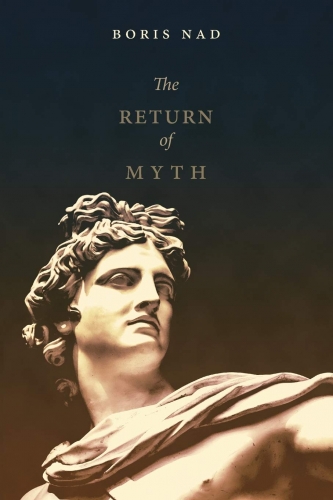
Une nouvelle vague de démythologisation a commencé avec le siècle des Lumières, mais ce "nouvel âge de la raison", dans lequel l'homme, pour le moins, revendique et semble avoir assumé pour lui-même l'autorité et le statut divins, n'était lui-même "qu'un mythe" - le mythe de "l'homme éclairé", peut-être celui de Prométhée, "celui qui pense vite", ou plus sinistrement, le mythe des Titans qui assaillent l'Olympe (le Ciel), le monde des dieux, et même le "père des dieux et des hommes" (Zeus).
Dans tous les cas de figure, parler de "retour du mythe" à l'époque moderne peut sembler anachronique. En effet, à l'"âge de la raison", le mythe est relégué à une place très modeste : il peut être l'objet d'études (marginales), un objet de ridicule, de mépris ou de moquerie comme s’il relevait de la "superstition" des "sauvages", comme s’il était une tentative simpliste d'"explication du monde", ou simplement une histoire amusante des temps passés qui, bien que non dépourvue d'imagination et de poésie, n'est au fond que du "délire de primitifs". La raison est censée éclairer le mythe de sa lumière froide. L'essence du mythe, cependant, échappe à la raison. Le mythe n'est ni l'histoire ni une superstition, mais une réalité intemporelle, une réalité qui n'est peut-être "jamais arrivée du tout ou nulle part", mais qui se répète constamment dans l'histoire et, de plus, est une réalité qui détermine et définit l'histoire. Un mythe n'a pas besoin d'avoir eu lieu de la manière dont il est décrit, et il n'a en fait jamais eu lieu de cette manière, mais il aurait pu avoir lieu et il a eu lieu dans une certaine mesure. Comme l'a fait remarquer Novalis dans son oeuvre : "Seul ce qui n'est jamais arrivé nulle part est vrai."
 Le XXe siècle n'a pas manqué d'érudits lucides et pénétrants du mythe. Il suffit de mentionner ici deux d'entre eux : le penseur et écrivain roumain Mircea Eliade, qui a surmonté le faux dualisme du sacré opposé au profane, car "il n'y a pas d'existence profane", et l'écrivain allemand Ernst Jünger, qui réfléchissait constamment au rapport entre les mondes mythique et historique. Rappelons quelques points de référence importants d’Eliade. Selon Eliade, les images, les symboles et les mythes qui ont été oubliés ou supprimés en Occident depuis le XIXe siècle nous révèlent les modalités les plus cachées de l'être humain. Le rôle spirituel des œuvres littéraires à l'époque moderne ? Elles ont préservé et transmis de nombreux mythes, bien que parfois sous une forme dégradée. Eliade a également souligné le fait que le regain d'intérêt pour le symbolisme et le mythe en Europe occidentale a coïncidé temporellement avec l'entrée des peuples asiatiques sur la scène historique, à commencer par la révolution de Sun Yat-sen. Par ailleurs, nous devons également au XXe siècle la découverte que toute connaissance "objective", "scientifique" n'est, en réalité, pour citer Alexandre Douguine, qu'"une variation particulière de la mythologie", et que "le développement et le progrès ont un caractère cyclique". En d'autres termes, le progrès - cette invention des modernes - n'est qu'illusoire. L'humanité, malgré tous les changements qu'elle a subis, reste essentiellement "telle qu'elle a toujours été". L'ère du positivisme et du matérialisme optimistes est terminée pour l’essentiel : "À sa place est venue une nouvelle compréhension des constructions mythologiques" et "la réhabilitation de ces diverses disciplines et sciences qui ont été trop hâtivement classées comme dépassées et primitives". Cette prise de conscience fait également s'effondrer le sentiment de suprématie ou de scepticisme à l'égard del’antique héritage de l'humanité et des civilisations du passé lointain (la soi-disant préhistoire). Notre époque n'est pas privilégiée par rapport aux autres époques de l'histoire humaine qui l'ont précédée. Ce serait plutôt l'inverse : nous sommes en présence d'une involution et d'un déclin spirituel patent.
Le XXe siècle n'a pas manqué d'érudits lucides et pénétrants du mythe. Il suffit de mentionner ici deux d'entre eux : le penseur et écrivain roumain Mircea Eliade, qui a surmonté le faux dualisme du sacré opposé au profane, car "il n'y a pas d'existence profane", et l'écrivain allemand Ernst Jünger, qui réfléchissait constamment au rapport entre les mondes mythique et historique. Rappelons quelques points de référence importants d’Eliade. Selon Eliade, les images, les symboles et les mythes qui ont été oubliés ou supprimés en Occident depuis le XIXe siècle nous révèlent les modalités les plus cachées de l'être humain. Le rôle spirituel des œuvres littéraires à l'époque moderne ? Elles ont préservé et transmis de nombreux mythes, bien que parfois sous une forme dégradée. Eliade a également souligné le fait que le regain d'intérêt pour le symbolisme et le mythe en Europe occidentale a coïncidé temporellement avec l'entrée des peuples asiatiques sur la scène historique, à commencer par la révolution de Sun Yat-sen. Par ailleurs, nous devons également au XXe siècle la découverte que toute connaissance "objective", "scientifique" n'est, en réalité, pour citer Alexandre Douguine, qu'"une variation particulière de la mythologie", et que "le développement et le progrès ont un caractère cyclique". En d'autres termes, le progrès - cette invention des modernes - n'est qu'illusoire. L'humanité, malgré tous les changements qu'elle a subis, reste essentiellement "telle qu'elle a toujours été". L'ère du positivisme et du matérialisme optimistes est terminée pour l’essentiel : "À sa place est venue une nouvelle compréhension des constructions mythologiques" et "la réhabilitation de ces diverses disciplines et sciences qui ont été trop hâtivement classées comme dépassées et primitives". Cette prise de conscience fait également s'effondrer le sentiment de suprématie ou de scepticisme à l'égard del’antique héritage de l'humanité et des civilisations du passé lointain (la soi-disant préhistoire). Notre époque n'est pas privilégiée par rapport aux autres époques de l'histoire humaine qui l'ont précédée. Ce serait plutôt l'inverse : nous sommes en présence d'une involution et d'un déclin spirituel patent.
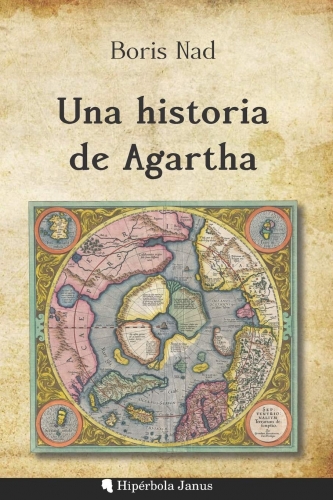
Après tout, nous ne connaissons pas le passé ancien de l'humanité, ou nous ne le connaissons pas suffisamment, car "l'histoire officielle", comme l'a noté René Guénon, ne va nulle part au-delà des six mille dernières années, une période qui est négligeable par rapport à la durée totale de l'existence de l'homme sur Terre. Une obscurité dense s'abat sur tout le reste. Devant toutes nos tentatives de connaître le passé lointain, un mur mystérieux et impénétrable émerge. Il n'est pas accessible à la "raison" (à la connaissance scientifique), car la portée de la "raison" (les connaissance et recherche rationnelles) est tout à fait modeste ; la raison a ses limites évidentes. Cela ne signifie pas pour autant que la "raison" doive être bannie, tout comme l'ère positiviste a tenté de se débarrasser de toutes ces forces qu'elle qualifiait d'"irrationnelles" et de "choses relevant du passé mort". L'écrivain allemand Jünger a proposé une approche différente et probablement beaucoup plus difficile et exigeante : l'utilisation simultanée des deux optiques, de deux angles d'observation, des méthodes de connaissance "rationnelles" et "irrationnelles". La lune, par exemple, est à la fois un corps physique et cosmique qui fait l'objet d'observations et de mesures scientifiques, ainsi qu'un fait mythologique ou même une entité métaphysique ; la lune n'est pas simplement un objet mort pour la connaissance scientifique, "objective", qu'un scientifique peut aborder "froidement" et sans préjugés.
Boris Nad n'est pas un scientifique ou un érudit, mais seulement un écrivain. Cela lui donne une plus grande liberté, une plus grande accessibilité, tout en le libérant de l'obligation de suivre la méticulosité scientifique. Le mythe, cependant, est un topos auquel, en tant qu'écrivain, il est souvent revenu. Sa première œuvre littéraire, publiée dans son pays natal, a été un court roman "épique-fantastique" intitulé The Feast of the Victor (2005). En gros, cette histoire mythique se déroule à un moment où différentes perspectives temporelles et spatiales se croisent. En fait, cette histoire, bien que suscitée par des événements immédiats (la guerre dans le pays qui s’appelait la Yougoslavie), se déroule dans un lieu intemporel ou "uchronie". Cette approche présente des similitudes avec celle employée par Jünger dans sa nouvelle Sur les falaises de marbre (1939). Cette comparaison ne concerne bien sûr que l'approche, et non la valeur de l'œuvre littéraire. Son livre The Silent Gods (2008), qui est un recueil de nouvelles, de notes et de prose, et le recueil de récits fantastiques intitulé The Invisible Kingdom (2016) étaient centrés sur des thèmes mythiques et sur mes propres variations d'intrigues mythiques bien connues.
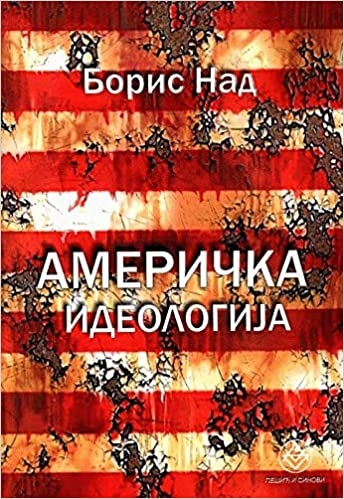 Le livre qui s’offre maintenant aux lecteurs est une sorte de sélection d'écrits par le biais de laquelle Boris Nad se présente au public anglophone de manière plus complète que jamais. En fait, ce livre se compose de trois ouvrages, dont le premier est l'édition anglaise abrégée de The Return of Myth, publié à l'origine en 2016 à Melbourne, en Australie, par Manticore Press. Ce texte a été réédité et partiellement retraduit pour l'occasion et annexé à un texte non traduit auparavant, The Golden Fleece. La deuxième partie est un court roman, A Tale of Agartha, c'est-à-dire un récit du royaume souterrain qui a, pendant des milliers d'années, influencé de manière invisible et mystérieuse les événements à la surface de la Terre, l'histoire et le monde des nations. C'est l'un des grands mythes de l'Orient que l'auteur aborde de la manière caractéristique d'un écrivain : sous la forme d'un conte fantastique. La troisième partie de ce livre, Sacred History and the End of the World, complète les deux premières, comprenant des textes qui ont été laissés de côté dans l'édition anglaise précédente de Return of Myth ainsi que d'autres textes, non traduits et non publiés auparavant, dans lesquels il aborde des sujets connexes d'une manière extrêmement libre, à la façon d’un essayiste. Ces sujets comprennent, entre autres, la notion d'histoire sacrée, l'apparition de l'Antéchrist et la seconde venue du Christ (qui est d'une importance particulière pour le christianisme oriental), et les relations entre l'Orient et l'Occident. Cette dernière partie ne concerne pas seulement la crise de l'Occident, mais aussi la crise dans laquelle les sociétés (et civilisations) orientales sont de plus en plus impliquée dans une phase descendante - des crises qui, sans aucun doute, ont essentiellement la même racine spirituelle. Aujourd'hui plus que jamais, il est nécessaire que l'Est et l'Ouest se rapprochent plutôt que, comme cela a été le cas au cours de l'ère moderne (contrairement à certaines périodes historiques antérieures), de s'éloigner davantage l'un de l'autre et de se diviser. La première et nécessaire condition pour cela est que l'Est et l'Ouest se connaissent mieux et engagent enfin le dialogue (sinon, ils ne cesseront d’être en guerre).
Le livre qui s’offre maintenant aux lecteurs est une sorte de sélection d'écrits par le biais de laquelle Boris Nad se présente au public anglophone de manière plus complète que jamais. En fait, ce livre se compose de trois ouvrages, dont le premier est l'édition anglaise abrégée de The Return of Myth, publié à l'origine en 2016 à Melbourne, en Australie, par Manticore Press. Ce texte a été réédité et partiellement retraduit pour l'occasion et annexé à un texte non traduit auparavant, The Golden Fleece. La deuxième partie est un court roman, A Tale of Agartha, c'est-à-dire un récit du royaume souterrain qui a, pendant des milliers d'années, influencé de manière invisible et mystérieuse les événements à la surface de la Terre, l'histoire et le monde des nations. C'est l'un des grands mythes de l'Orient que l'auteur aborde de la manière caractéristique d'un écrivain : sous la forme d'un conte fantastique. La troisième partie de ce livre, Sacred History and the End of the World, complète les deux premières, comprenant des textes qui ont été laissés de côté dans l'édition anglaise précédente de Return of Myth ainsi que d'autres textes, non traduits et non publiés auparavant, dans lesquels il aborde des sujets connexes d'une manière extrêmement libre, à la façon d’un essayiste. Ces sujets comprennent, entre autres, la notion d'histoire sacrée, l'apparition de l'Antéchrist et la seconde venue du Christ (qui est d'une importance particulière pour le christianisme oriental), et les relations entre l'Orient et l'Occident. Cette dernière partie ne concerne pas seulement la crise de l'Occident, mais aussi la crise dans laquelle les sociétés (et civilisations) orientales sont de plus en plus impliquée dans une phase descendante - des crises qui, sans aucun doute, ont essentiellement la même racine spirituelle. Aujourd'hui plus que jamais, il est nécessaire que l'Est et l'Ouest se rapprochent plutôt que, comme cela a été le cas au cours de l'ère moderne (contrairement à certaines périodes historiques antérieures), de s'éloigner davantage l'un de l'autre et de se diviser. La première et nécessaire condition pour cela est que l'Est et l'Ouest se connaissent mieux et engagent enfin le dialogue (sinon, ils ne cesseront d’être en guerre).
Pourtant, ici, dans les pages de ce livre, ce n'est pas l'Est et l'Ouest qui se rencontrent, mais surtout le lecteur et l'écrivain. L'ambition de l'écrivain n'est pas d'expliquer ou d'interpréter quoi que ce soit ; il ne cherche pas à persuader, mais plutôt à poser des questions, à parler simplement de ce qui est important pour lui avec sa propre voix et en suivant le flux de ses propres pensées. Il n'est pas nécessaire que le lecteur et l'écrivain soient toujours d'accord sur tout, mais il est nécessaire qu'il y ait une certaine affinité entre eux. Ce sont les désaccords et les disputes qui rendent le dialogue souhaitable et possible. Le rôle du lecteur n'est pas moins exigeant que celui de l'écrivain, car c'est au lecteur de faire revivre l'œuvre de l'écrivain. Si ce livre facilite cela, ne serait-ce qu'au niveau symbolique, alors il aura atteint son but. Après tout, tout ce qui est important se passe d'abord au niveau des symboles, dans le domaine où l'esprit règne souverainement, et ne provoque qu'ensuite des conséquences dans le monde que nous appelons si maladroitement "matériel".
Boris Nad,
Serbie, août 2020.
00:29 Publié dans Livre, Livre, Traditions | Lien permanent | Commentaires (0) | Tags : boris nad, tradition, traditionalisme, mythe, livre |  |
|  del.icio.us |
del.icio.us |  |
|  Digg |
Digg | ![]() Facebook
Facebook
jeudi, 17 décembre 2020
Noël, fête immémoriale en Europe

Noël, fête immémoriale en Europe
Par Robert Steuckers
Article rédigé pour la revue Cultura Identità (Naples)
La sédentarisation des tribus en Europe, et ailleurs dans le monde indo-européen, implique l’émergence définitive de l’agriculture et donc l’obligation pratique de tenir compte des saisons et d’observer le rythme de l’astre solaire. Les hommes vivront dans notre continent septentrional au rythme d’une liturgie. La liturgie est de fait le fondement le plus solide de la religion : nul autre livre ne l’explique mieux que celui de David Herbert Lawrence, intitulé Apocalypse. L’année est de fait un cycle où l’on trouve un point le plus bas (et le plus froid) et un point le plus haut (le plus chaud). Ce sont les solstices : l’un, estival, annonce pourtant le déclin du soleil ; l’autre, hivernal, annonce son retour, le triomphe de la vie sur la mort de la nature, qui avait commencé avec les premiers frimas de l’automne. Le solstice d’été est une fête triste pour nos ancêtres, qui s’affairaient à rentrer les récoltes, à faire des conserves pour la saison froide. Le solstice d’hiver, en revanche, est une fête joyeuse, où l’on consomme dans la joie, où l’on offre des mets et des cadeaux, où l’on promet, à ses proches, gentillesse et affabilité.
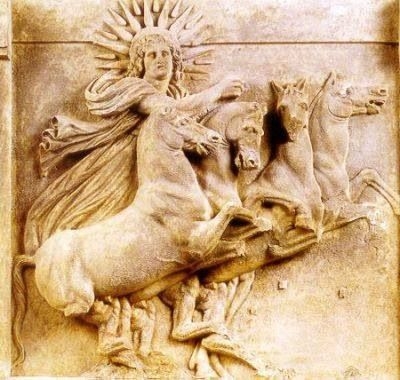 Les festivités solsticiales de l’hiver ont été célébrées depuis des temps immémoriaux : ce furent les premiers rites romains des Saturnales, qui finirent par avoir mauvaise réputation mais qui, au départ, avaient le sens de la mesure et de la tenue. Dans le Nord de l’Europe, on célèbre notamment Iduna, déesse de la jeunesse et de la fertilité, des fruits et des pommiers, qui pourra à nouveau s’épanouir grâce au retour du Soleil. Parallèlement à ces cultes d’Europe du Nord et du Sud, la période de l’Empire romain a également connu l’existence d’une fête solsticiale mithraïque, apportée sous nos latitudes par les cavaliers sarmates engagés dans les légions romaines.
Les festivités solsticiales de l’hiver ont été célébrées depuis des temps immémoriaux : ce furent les premiers rites romains des Saturnales, qui finirent par avoir mauvaise réputation mais qui, au départ, avaient le sens de la mesure et de la tenue. Dans le Nord de l’Europe, on célèbre notamment Iduna, déesse de la jeunesse et de la fertilité, des fruits et des pommiers, qui pourra à nouveau s’épanouir grâce au retour du Soleil. Parallèlement à ces cultes d’Europe du Nord et du Sud, la période de l’Empire romain a également connu l’existence d’une fête solsticiale mithraïque, apportée sous nos latitudes par les cavaliers sarmates engagés dans les légions romaines.
Le christianisme primitif, issu de traditions sémitiques où de tels cultes avaient disparu, entendait mettre un terme aux Saturnales et, plus tard, aux rites liés au retour certain de la fertilité en Europe du Nord. La Bible ne parle jamais de « solstice », terme signifiant étymologiquement l’ « arrêt du soleil », sauf dans Josué, 10, v. 12 à 14. Yahvé arrête la course du soleil pour que les Hébreux puissent massacrer leurs ennemis les Amorites. La règle générale est donc une hostilité rabique à l’encontre des traditions païennes européennes, à l’instar de ce que manifestent aujourd’hui les témoins de Jéhovah ou les salafistes radicaux, qui aiment à perturber les festivités de Noël dans nos villes, en adoptant un comportement agressif, contraire à la mansuétude que nos traditions veulent que nous manifestons.
L’impossibilité d’éradiquer les festivités solsticiales ou leurs rituels transposés dans la pratique des masses christianisées contraint les premiers théologiens chrétiens à la souplesse, surtout parce que le culte de Mithra, véhiculé par les légions de Rome, risquait bel et bien de les supplanter. C’est la raison pour laquelle les conciles finissent par fixer la date de la naissance du Christ au 25 décembre, date de la principale fête mithraïque. La même tolérance vaut alors pour tous les symboles utilisés par la coutume, telles les garnitures faites de feuilles de houx, de branches de sapin, etc. autant d’éléments végétaux vus comme impérissables et, par conséquent, liés à la pérennité de la vie.
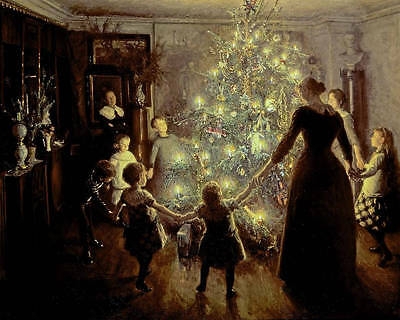
Les princes et les rois, eux aussi, n’ont jamais renoncé aux rites traditionnels immémoriaux des peuples européens, même quand ils utilisaient la puissance de l’Eglise pour consolider leur pouvoir. Le jour de Noël, ils offrent des banquets ; dansent, distribuent des aliments aux miséreux et choisissent le 25 décembre pour se faire couronner et commencer leur règne, en le plaquant sur le début d’un nouveau cycle solaire. Ainsi, Charlemagne se fait couronner Empereur le jour de Noël de l’an 800. Ces banquets, jeux, danses et saynètes seront vus d’un mauvais œil par les théologiens sourcilleux mais rien n’y fera : ils seront maintenus. Quand les saynètes étaient dans le collimateur des théologiens les plus fanatiques, elles ont été remplacées par des mises en scènes figées, faites de figurines sommaires qui donneront à terme les santons de nos crèches.
Noël est donc une christianisation des Saturnales, des rites agraires de toute l’Europe et du culte de Mithra. L’Eglise, ne pouvant éradiquer ces cultes, va plaquer sur les journées qui suivent les solstices deux fêtes de sa propre liturgie : celle de Saint Jean Baptiste (le 24 juin) et celle de Saint Jean l’Evangéliste (le 27 décembre). Le 24 juin donnait lieu, dans les campagnes, à des brèves festivités solaires, consistant souvent à lancer du haut de monticules des roues enflammées, lesquelles amorçaient donc un mouvement descendant comme le soleil qui commençait à perdre de sa vigueur. Le 27 décembre, la fête de Saint Jean d’hiver annonce la Bonne Nouvelle, comme le sont les Evangiles, dont celui du disciple préféré du Christ. L’annonce de la Bonne Nouvelle par le plus jeune des disciples du Christ est assimilée au retour victorieux du Soleil, astre invaincu, comme disaient les Romains.

En France, récemment, le philosophe en vogue Michel Onfray, qui se pose comme non chrétien et anticlérical, a produit une excellente vidéo montrant que la religiosité populaire a toujours fait l’équation entre le Christ (plus pantocrator que souffrant) et les cultes solaires immémoriaux : les chœurs des églises reçoivent les rayons du soleil sur le maître autel le jour du solstice d’été, les coqs de métal surmontent les clochers parce que le coq est l’animal qui annonce chaque matin le lever du soleil.
Dans les pays catholiques, cette fusion des cultes agraires et christiques n’a que rarement fait problème mais, avec l’avènement de filons fanatiques lors de la Réforme, surtout dans les territoires soumis au calvinisme et aux presbytériens, les fêtes de Noël sont interdites ; ce fut le cas en Ecosse en 1583 et en Angleterre en 1642, quand les puritains de Cromwell tinrent provisoirement le haut du pavé. Sous Cromwell, les Anglais avaient l’obligation de travailler le 25 décembre. Les sectes protestantes, qui animent encore et toujours le deep state des Etats anglo-saxons, ont tout de même vaincu d’une certaine manière car les festivités de Noël se sont, depuis lors, repliées sur la sphère privée et familiale, n’ont plus eu vraiment droit de cité sur les places publiques. L’offensive généralisée des milieux protestants et salafistes, sionistes chrétiens et sectaires, contre la fête de Noël prend aujourd’hui une tournure inattendue : l’expression de leur radicalisme iconoclaste est désormais la pratique économique du néolibéralisme, qui tente de garder ouverts les supermarchés jusqu’à la dernière minute avant la veillée de Noël, tente de supprimer les fêtes du calendrier liturgique (immémorial ou chrétien). Un bel exemple de ces efforts pour détruire définitivement nos traditions les plus belles et les plus innocentes est bien, de nos jours, la France de Macron, créature des Young Leaders néolibéraux qui prennent leurs modèles et leurs ordres dans les officines du deep state aux Etats-Unis. Ce néolibéralisme macronien est couplé au voltairianisme persifleur du filon laïque et révolutionnaire à la française, qui est un avatar particulièrement pervers des volontés éradicatrices toujours à leur œuvre de destruction dans l’histoire : Notre-Dame a brûlé, pas une semaine ne se passe sans qu’une église ou une statue mariale ne soit détruite par le feu ou à coups de maillet, les crèches sont interdites par une flicaille particulièrement brutale : le travail des théologiens du Bas-Empire, des presbytériens, des puritains de Cromwell, des sans-culottes fanatiques et des djihadistes salafistes (alliés objectif du pouvoir en place) est bel et bien parachevé dans les anciennes provinces gauloises de l’Imperium Romanum.

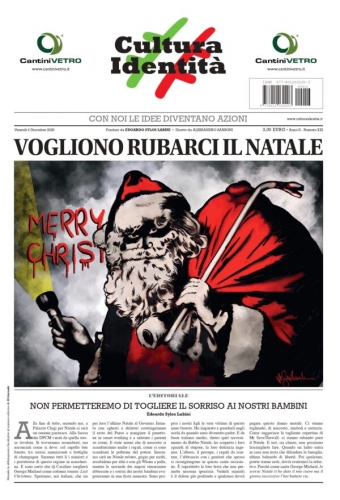
00:04 Publié dans Synergies européennes, Traditions | Lien permanent | Commentaires (0) | Tags : noël, solstices, culte solsticial, paganisme, tradition, robert steuckers |  |
|  del.icio.us |
del.icio.us |  |
|  Digg |
Digg | ![]() Facebook
Facebook
mercredi, 16 décembre 2020
Rome : Temples et cultes du Soleil
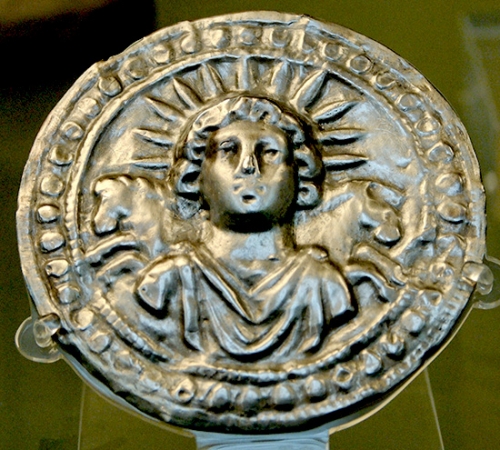
TEMPLUM SOLIS INDIGETIS (9 décembre)
Rome : Temples et cultes du Soleil
Le Temple du Soleil a été inauguré à Rome par l'empereur Aurélien (214 - 275) et consacré au Sol Invictus en 275, suite à un vœu prononcé lors de sa conquête de Palmyre en 272. Pour ce culte a été créé un collège de pontifices (Dei) Solis et aussi des Ludi ou jeux annuels avec des courses au cirque, en plus des jeux quadriennaux (Agon Solis) qui se tiennent à la fin des Saturnales, des fêtes autour du temple de Saturne et évoquant le mythique âge d'or. À l'époque impériale, elles se déroulaient du 17 au 23 décembre, comme l'avait fixé Domitien (51 - 96).
D'après les sources, nous savons que le temple était situé dans la regio VII "Via Lata", dans le Campus Agrippae, et qu'il était décoré avec le butin de guerre pris à Palmyre. Le bâtiment était entouré de portiques, où se trouvait le magasin de vina fiscalia, le vin vendu à prix réduit à la plèbe de Rome au temps d'Aurélien. L'emplacement coïncide avec l'actuelle Piazza di San Silvestro, près de l'église de San Silvestro in Capite.
DESCRIPTION
On ne connaît pas exactement l'orientation du Temple par rapport à la Via Lata, aujourd'hui Via del Corso. Nous savons cependant qu'elle avait deux entrées, dont l'une était l'Arche du Portugal, démolie en 1662. Elle avait deux cours, la première de 55 m x 75 m avec deux hémicycles sur les petits côtés, dont les murs étaient décorés de deux colonnades qui encadraient des niches ; tandis que les entrées voûtées étaient encadrées par des colonnes géantes sur toute la hauteur.
Une petite pièce carrée de 15 m x 15 m donnait accès à une deuxième cour, plus grande dont les dimensions étaient de 130 m x 90 m, placée sur le même axe, avec trois niches rectangulaires sur les longs côtés. Parmi celles-ci, les deux latérales, plus larges, avaient deux colonnes et une petite abside, tandis qu'il y avait trois autres niches sur le petit côté à l'arrière, celle centrale semi-circulaire et les latérales également rectangulaires, toutes avec une entrée à deux colonnes.
Au centre du deuxième portique, Palladio a conçu un temple circulaire, mais sans mesures contrairement aux autres structures et probablement inventé par l'architecte sur le modèle du temple d'Hercule à Tivoli.

SANCTUAIRE DE TORVAIANICA
"Le jour dit du Soleil, tous les habitants des villes ou des campagnes se réunissent en un seul lieu, disent les mémoires des apôtres ou les écritures des prophètes, dans la mesure où le temps le permet ; puis, lorsque le lecteur a terminé, le président instruit en paroles et exhorte à l'imitation de ces bons exemples. Ensuite, nous nous levons tous pour prier et, comme nous l'avons dit juste avant, lorsque les prières sont terminées, on apporte du pain, du vin et de l'eau, et le président offre des prières et des remerciements, selon ses capacités, et le peuple donne son consentement, en disant Amen ».
Viennent ensuite la distribution et la participation à ce qui a été donné par des actions de grâce, et à ceux qui sont absents une portion est apportée par les diacres. Ceux qui peuvent, et veulent, donnent autant qu'ils pensent le pouvoir : l’ensemble des dons est déposé auprès du président, qui l'utilise pour les orphelins et les veuves et pour ceux qui, malades ou empêchés, sont dans le besoin, pour ceux qui sont enchaînés et pour les étrangers qui vivent avec nous, bref pour tous ceux qui en ont besoin".
(Justin, 2e siècle après J.-C.)
TEMPLUM SOLIS INDIGETIS
C'est une fête qui a eu lieu le 9 décembre, la deuxième fête de l'année en l'honneur du Sol Indiges, le soleil originel de toutes choses.
Le temple de Torvaianica
À Torvaianica, près de Rome, on a découvert les restes du sanctuaire de Sol Indiges et ceux de deux autels où Énée a fait le premier sacrifice pour remercier les dieux du débarquement sur une terre riche en eau et en nourriture. La zone située entre l'aéroport militaire de Pratica di Mare et la côte de Torvaianica était autrefois occupée par une grande lagune qui n'a été asséchée qu'au XVIe siècle.
Ici, les recherches archéologiques de l'Université de Rome "La Sapienza", ont mis au jour les restes d'un sanctuaire qui se trouvait près du port d'escale de la ville et où les auteurs antiques ont fixé le légendaire débarquement d'Enée. Les fondations en blocs de tuf appartenant à un temple rectangulaire sur un podium bas sont visibles.
La cellule était adossée au fond et il est possible de reconstruire la façade du temple, qui était entourée de colonnes de tous les côtés sauf celui du bas. Le bâtiment était délimité par une grande enceinte quadrangulaire composée de blocs de tuf de différentes variétés et complétée par une porte d'accès et deux tours défensives (ce qui n'est pas trop étrange étant donné l'existence du port et de la piraterie).
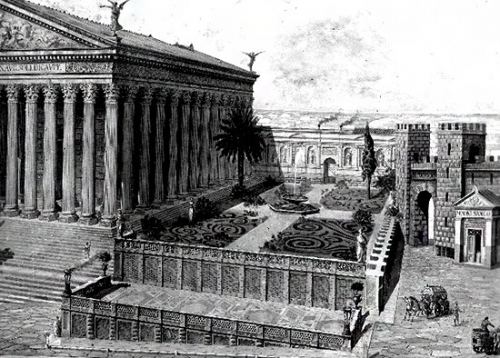
RECONSTRUCTION DU TEMPLE DE SOL INDIGES SUR LE QUIRINAL
Le temple du Quirinal
Ce jour-là tombait l'anniversaire de la dédicace du temple du Sol Indiges, où en réalité on célébrait le Sol Invictus, Hélios, El-Gabal et Mithra, qui ont fini par être assimilés à l'époque de la dynastie Sévère.
Contrairement au précédent culte rural du Sol Indiges ("Soleil indigène" ou "Soleil invoqué" ou "Soleil progéniteur" ; l'étymologie et la signification du terme indiges sont incertaines), le titre Deus Sol Invictus a été formé par analogie avec le titre impérial Pius, Felix, Invictus (Pie, Fortuné, Invaincu).
En fait, le Sol Indiges était l'équivalent du Sol Pater, une sorte de monothéisme qui admettait beaucoup d'autres Dieux mais de rang inférieur, un peu comme la Fortuna Primigenia ou plus généralement la Grande Mère Méditerranéenne.
Ici, en bas, l'empereur Marc-Aurèle Probo (vers 280), avec la couronne rayonnante due à Sol et, à l'arrière, le Sol Invictus conduisant un quadrige.
C'est l'empereur Héliogabale qui a introduit le culte à Rome en érigeant un temple dédié à la nouvelle divinité sur la colline du Palatin. Avec la mort violente de l'empereur en 222 après J.-C., le culte a cessé à Rome, bien que de nombreux empereurs aient continué à être représentés sur des pièces de monnaie avec l'iconographie de la couronne de soleil rayonnant pendant près d'un siècle ; mais il n'a pas cessé en province ou même dans les régions italiennes, la seule différence c’est que le culte de public est devenu privé.
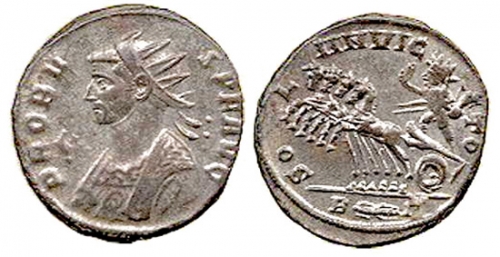
CULTE PAGANO-CHRÉTIEN
Ce culte a ses origines en Orient. Par exemple, les célébrations du rite de la naissance du Soleil en Syrie et en Égypte étaient d'une grande solennité et prévoyaient que les célébrants qui se retiraient dans des sanctuaires spéciaux partaient à minuit, annonçant que la Vierge avait donné naissance au Soleil, représenté comme un nourrisson.
Selon toute probabilité, la date a été fixée (en 440 après J.-C.) au 25 décembre pour remplacer la fête de Natalis Solis Invicti par la célébration de la naissance du Christ, indiquée dans le livre de Malachie comme le nouveau "soleil de la justice" (cf. Malachie III, 20). Ainsi, Noël constituerait la christianisation d'une fête païenne préexistante.

LES RESTES DES COLONNES DU TEMPLE DANS LA COUR DE L’ÉGLISE DE ST. SYLVESTRE
En fait, la date coïncide avec les anciennes célébrations du solstice d'hiver et les festivités des saturnales romaines (du 17 au 23 décembre). Sans noter que le terme Natalis était déjà utilisé pour le Natalis Romae (21 avril), qui commémorait la naissance de la ville et le Dies Natalis Solis Invicti, la fête dédiée à la naissance du Soleil (Mithra), introduite à Rome par Héliogabale (empereur de 218 à 222) et officialisée pour la première fois par Aurélien en 274 après J.-C. avec la date du 25 décembre.
Le dieu grec Dionysos était considéré comme l'enfant divin né miraculeusement d'une vierge céleste. Dionysos avait été latinisé sous le nom de Mithra, dont la fête était célébrée en Orient le soir du 24 décembre. Il était le Dieu iranien des mystères, de l'amitié et de l'ordre cosmique, né de la pierre et porteur de la nouvelle lumière "Genitor luminis".
L'empereur Constantin (280-337) a ainsi unifié le culte du soleil, dont il était un grand adepte, avec le culte du dieu Mithra et avec le christianisme, et c'est précisément sous son règne qu'apparaît la fête de Noël. De Rome, Noël s'est répandu en Afrique, en Espagne et en Italie du Nord, mais ce n'est que sous l'empereur Justinien (527-565 après J.-C.) que Noël a été reconnu comme un jour férié légal en Occident.
Le Sol Invictus est né dans une grotte comme l'enfant Jésus, mais Mithra aussi est né dans une grotte mais d'une pierre très semblable à l'omphalos, c'est-à-dire une pierre conique et convexe traversée par des lignes transversales pour imiter la peau du serpent, en référence à la Terre Mère, au python qui lui est sacré et aux divinatres Pitié ou Pizie sur les trépieds sacrés.
En fait, nous sommes devant une fête très ancienne, où le 25 décembre a été célébré la renaissance du Père Solaire, le Grand Dieu qui après le solstice (Sol stat) en hiver vainc les ténèbres, parce que le soleil se lève plus haut à l'horizon et les jours redeviennent plus longs, et la lumière gagne sur les ténèbres. Selon les informations fournies par Marcus Terentius Varron et ensuite soutenues par Dionysos d'Halicarnasse, le culte de Sol Indiges a été introduit à Rome déjà par le roi Titus Tatius, donc un culte qui est aussi sabin.
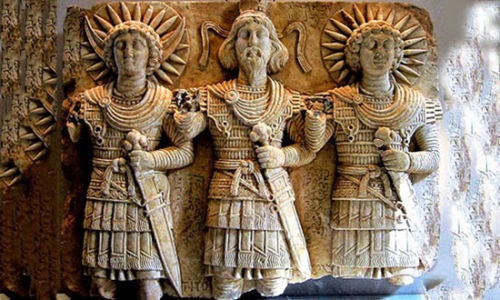
LA FÊTE
"...beaucoup croient que le Dieu chrétien est le Soleil car il est bien connu que nous prions le Soleil source et que le jour du Soleil nous nous donnons à la joie".
(Tertullien, Ad nationes, apologeticum, de testimonio animae)
Lors des Saturnales qui se déroulaient du 17 au 21 décembre et lors de la fête du Sol Invictus le 25, mais aussi pour la fête du Templum Sol Indigetis, les mêmes symboles de la jeunesse éternelle de Dionysos ont été utilisés : myrte, laurier, lierre. C'est pourquoi les temples et les processions abondaient de branches de myrte, de couronnes de laurier et de lierre.
Selon certains, la fête de Sol Indiges a eu lieu le 11 décembre avec le début de l'agonalia, qui a en fait commencé le 10 décembre. A Sol Indiges, qui avait un sanctuaire sur le Quirinal, des sacrifices ont été offerts à l'occasion du 9 août, il semble qu'une chèvre lui ait été sacrifiée qui faisait référence aux sacrifices de Dionysos-Bacchus et de la Terre Mère.
La procession partait du Quirinal où se trouvait le temple et traversait le forum en suivant la Via Sacra jusqu'au Capitole, retraçant la Via dei Trionfi suivie par les généraux romains victorieux, car le Soleil était à son tour Invictus, victorieux des ténèbres.
Pendant la fête, les prêtres offraient au peuple les "Vini fiscalia", c'est-à-dire des coupes de vin pour libérer les Dieux. Il semble qu'au début, le vin était offert à bas prix, mais comme les gens étaient réticents à dépenser, même des sommes modestes, les libations n'avaient pas lieu et les dieux pouvaient être offensés. C'est pourquoi, afin de remonter le moral, l'Invincibilité du Soleil offrait le vin gratuitement et le peuple romain se libérait ainsi généreusement, peut-être même trop.
Pour l'occasion, les gens festoyaient dans les maisons ou à travers les nombreux étals proposant des pizzas aux olives et au fromage, des lupins, de la viande séchée et du poisson salé, le tout accompagné de "Vini fiscalia" offerts par l'État. Les musiciens et les danses ne manquaient pas, mais surtout les courses de chevaux au Circus maximus.
BIBLIOGRAPHIE:
- Jacqueline Calzini Gysens & Filippo Coarelli - "Sol, templum" - in Eva Margareta Steinby (a cura di) - Lexicon Topographicum Urbis Romae - IV - Roma - 1999 -
- George Dumezil - La religione romana arcaica (La religion romaine archaïque, avec un'appendice sur la religion des Étrusques - Parigi - Payot - 1964) - Milano - Rizzoli - 1977
- George Dumezil - Mithra -Varuna, essai sur deux représentations indo-européennes de la Souveraineté - Paris - Presses Universitaires de France - 1940 -
- Nino Burrascano - I misteri di Mithra - Genova - Il Basilisco - 1979
-- George Dumezil - Mithra-Varuna, essai sur deux représentations indo-européennes de la Souveraineté - Paris - Presses Universitaires de France - 1940 -
00:55 Publié dans Traditions | Lien permanent | Commentaires (0) | Tags : tradition, culte solaire, sol invictus, noël, natalis, rome antique, antiquité romaine |  |
|  del.icio.us |
del.icio.us |  |
|  Digg |
Digg | ![]() Facebook
Facebook
Rome antique: les Saturnales (17-23 décembre)
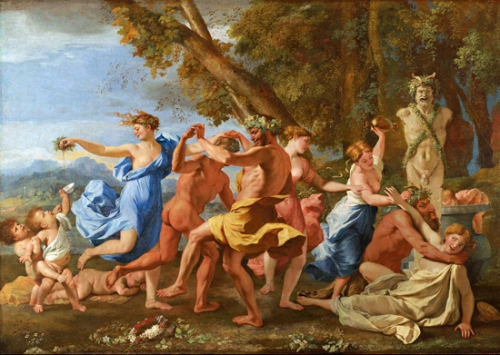
Rome antique: les Saturnales (17-23 décembre)
Ex : https://www.romanoimpero.com
SATURNALIA ET OPALIA
Les Saturnales constituaient un cycle de festivités célébrées du 17 au 23 décembre, période fixée à l'époque impériale par Domitien, en l'honneur de Saturne (Chronos) et de la déesse de l'abondance des fruits de la terre, Ops, son épouse. Dans la religion catholique, les Saturnales ont été remplacées par le cycle de festivités qui vont de la Noël au Nouvel An. Lors de ces festivités païennes, il y avait également des décorations dans les villes, des guirlandes, des torches, des braseros allumés devant les temples, des rubans, des branches et des fleurs d'hiver.
Les Saturnales ont été consacrées à l'installation dans le temple du Dieu Saturne, au mythique âge d'or. Selon le mythe, Saturne a été chassé du ciel par Jupiter et accueilli par Janus sur le sol italique, qui a dès lors pris le nom de Saturnia, où il a régné pendant l’âge d'or, enseignant aux hommes à cultiver la terre et établissant les premières lois.
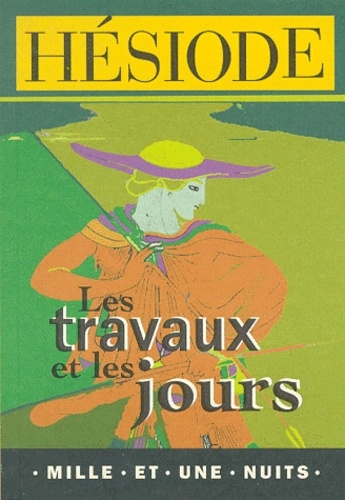 Selon Hésiode, c'était le premier âge mythique, où "une lignée de mortels ‘en or’ a créé dans les premiers temps les immortels qui habitaient l'Olympe". Ils vivaient au temps de Kronos, lorsqu'il régnait au ciel ; comme des dieux, ils passaient leur vie, l’âme sans angoisse, loin du labeur et de la misère ; et leur misérable vieillesse ne leur pesait pas... (Hésiode - Les travaux et les jours).
Selon Hésiode, c'était le premier âge mythique, où "une lignée de mortels ‘en or’ a créé dans les premiers temps les immortels qui habitaient l'Olympe". Ils vivaient au temps de Kronos, lorsqu'il régnait au ciel ; comme des dieux, ils passaient leur vie, l’âme sans angoisse, loin du labeur et de la misère ; et leur misérable vieillesse ne leur pesait pas... (Hésiode - Les travaux et les jours).
Que ce soient les hommes qui créent les Dieux et non l'inverse est une hypothèse également soutenue par Plutarque dans ses Dialogues Delphiques, comme pour dire que les religions sont inventées par les hommes, ce qui ne nie pas les puissances supérieures du cosmos, mais montre que l'homme les a senties, représentées et finalement polluées par ses désirs et ses projections, les déformant totalement.
En l'honneur de Saturne, pendant sept jours, les temps de son règne heureux sont commémorés par des divertissements, des échanges de cadeaux et des banquets, auxquels les esclaves étaient invités parce qu'il n'y avait pas de différences de classe sous la règle de ce dieu. En fait, pendant l'âge d'or, les hommes vivaient sans avoir besoin de lois, sans cultiver de haine ni se faire la guerre entre eux, et ne cultivaient pas la terre parce que les plantes y poussaient spontanément. C'était toujours le printemps, il n'était donc pas nécessaire de construire des maisons ou de s'abriter dans des grottes. Avec l'avènement de Jupiter, l'âge d'or s'est terminé et l'âge d'argent a commencé.
Hésiode dit que l'âge d'argent avait plusieurs défauts, car les enfants restaient longtemps chez leur mère (au lieu d'aller à la gymnastique pour apprendre la guerre) et les adultes étaient querelleurs (mais il n'y avait pas de guerres). Jupiter les a punis pour cela en les exterminant. L'âge d'or a dû être la période primitive et instinctive, où l'homme n'avait pas conscience de sa propre mort.
L'âge d'argent est celui du matriarcat (l'argent, la lune et l'eau sont tous des éléments du féminin), où aucune guerre n'a été faite, Jupiter (le nouveau patriarcat) les a exterminés en mettant fin à l'âge d'argent et en commençant l'âge de fer (toujours selon Hésiode) où les guerres ont été menées.
La fin de l'âge d'or se produisit à cause d'une femme, (mais là on oublie que le ‘bon’ Saturne a dévoré ses enfants et que pour cette raison il a été détrôné), parce que Prométhée, ayant eu pitié des hommes qui n'avaient pas de feu pour cuisiner, le vole aux dieux pour le donner aux humains. Jupiter, qui n'aime manifestement pas les humains, punit Prométhée et comme il y a aussi des hommes, coupables à ses yeux, il les punit aussi en envoyant Pandore, la femme curieuse. C'est elle qui ouvre la boîte interdite, donc fatale pour les humains. Étrange, car le principe de toute science et de tout progrès est la curiosité.

Les Saturnales commençaient par de grandes processions, des sacrifices, de riches banquets avec de la nourriture et du vin en abondance, pour lesquels, comme il n'y avait pas de condamnation du sexe, même les relations plutôt licencieuses étaient autorisées. L'Eglise catholique a classé ces festivités de décembre dans la catégorie condamnable des orgies, parce que les Romains les aimaient trop. Catulle a appelé ces fêtes l’ "Optimo dierum" (le meilleur des jours).
Les invités de la fête échangeaient alors le souhait "Je suis les Saturnales" (ego Saturnalia), qui selon les auteurs était l'abréviation du souhait de passer des Saturnales heureuses (ego tibi optimis Saturnalia auspico). "Je suis les Saturnales" ne semble pas avoir beaucoup de sens, d'autant plus que c'était une fête très conviviale.
La première interprétation semble donc la plus valable, d'autant plus que le souhait était accompagné de petits cadeaux symboliques, appelés strenne (de la déesse Strenua, la déesse du solstice d'hiver), à base de bougies, de noix, de dattes et de miel.
En fait, les esclaves pendant la fête devenaient des hommes libres, ils n'avaient pas à servir leurs maîtres mais parfois c'étaient les maîtres eux-mêmes qui les servaient, ou du moins qui organisaient un banquet pour eux ; en souvenir du fait que, pendant le règne de Saturne, il n'y avait ni serviteurs ni esclaves. En outre, un "princeps", caricature de la classe noble, était élu par tirage au sort, à qui était attribué tout le pouvoir sur la fête elle-même, vêtu d'un drôle de masque et de couleurs vives parmi lesquelles le rouge, couleur des dieux et des empereurs, prédominait (Sénèque, Apocol., 8).
Le princeps, qui organisait la fête, en assurant son bon déroulement, représentait une divinité inférieure, Saturne ou Pluton, gardiens des morts, mais aussi protecteur des campagnes et des cultures. Dans les Saturnales, les jeux d'argent étaient également autorisés, interdits le reste de l'année, y compris les jeux de dés.
Les Saturnales étaient également célébrées dans l'armée ; la fête était appelée "Saturnalicium castrense", où de simples soldats s'asseyaient à côté des généraux en égaux et portaient un toast en même temps que la fête qui détendait des fatigues et des tensions du combat.
À l'époque romaine, on croyait que ces dieux (Saturne, Pluton, Proserpine), sortis du sous-sol, erraient en procession pendant toute la période hivernale, lorsque la terre se reposait sans être cultivée en raison du gel hivernal. Ils devaient ensuite être apaisés par l'offrande de cadeaux et de fêtes en leur honneur pour les rendre bienveillants, puis retourner dans l'en-deçà, où, en tant que dieux des profondeurs infernales, ils protégeraient les graines, les faisaient germer au printemps et favorisaient les récoltes de la saison estivale.
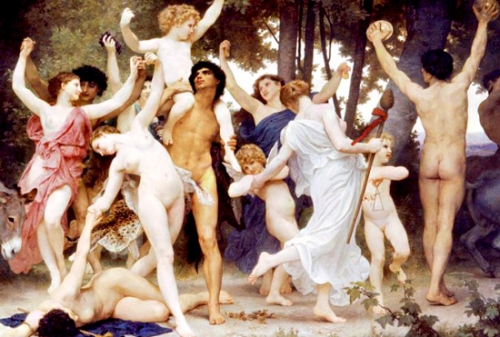
Pendant les Saturnales, il n'y avait pas de jours tristes et le deuil était aboli. En effet, Suétone, pour faire comprendre combien Germanicus était aimé des Romains et combien ils pleuraient sa mort, rapporte le fait exceptionnel que le deuil de la population se poursuivait exceptionnellement aussi pendant ces fêtes. "Ainsi, à l'époque des saturnales, Suétone dit que le deuil de Germanicus était tel qu'il dura même en ces temps"
LE MYTHE DE SATURNE
Le dieu Saturne, ou plutôt son correspondant grec Kronos, ou Chronos, qui était aussi la divinité de l'époque, fut exilé par Zeus et ses fils olympiens à la fin de la Titanomachie. Il avait, selon certaines sources, déplacé son royaume vers un endroit que, d'abord les Grecs et ensuite les Romains, appelèrent les "îles bénies" qu’à partir de Claude Ptolémée (100 - 175 après J.C.) on a toujours prétendu qu'elles coïncidaient avec les îles Canaries.
Un autre mythe, purement italien, raconte que Saturne a été lié et enterré par Jupiter dans un endroit secret du Latium. Le nom de cette région remonte à "latere" (se cacher) et le Latium fait allusion au lieu caché du tombeau du dieu. Qui aurait pu découvrir le tombeau aurait pu obtenir la "graine d'or" que Saturne gardait dans sa tombe, graine qui aurait rendu heureux et immortel celui qui l'aurait possédée.
Pendant les Saturnales, les tribunaux et les écoles étaient fermés : il était interdit de commencer ou de participer à des guerres, d'établir des peines de mort, de porter le deuil et, en tout cas, dese livrer à toute autre activité que la célébration. Les Saturnales ont lieu dans la période précédant le solstice d'hiver, à la veille de la veille du Noël du Soleil : le nouveau Soleil renaît après sa mort symbolique.
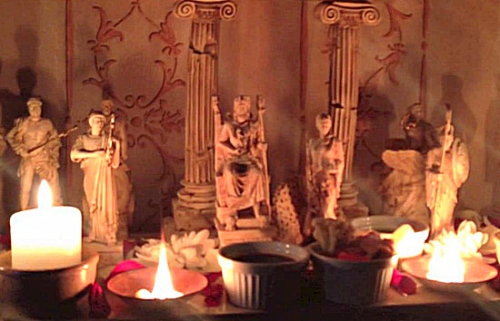
C'était la fête la plus prisée des Romains car elle était suivie par tout le peuple, une fête qui se déroulait dans tout l'empire surtout dans les rues, avec des foires, des spectacles et des marchés, d'où nos marchés de Noël. C'est pourquoi il n'a pas été bien vu par certains moralisateurs qui n'aimaient pas les mélanges entre les différentes classes sociales et surtout entre les hommes et les femmes.
La partie officielle de la fête consistait en un sacrifice solennel dans le temple où la tête du dieu était découverte et au cours duquel les bandages de laine qui enveloppaient les pieds du simulacre de Saturne fondaient. Un banquet public suivait, au cours duquel tous les participants échangeaient des toasts et des bons vœux.
Jusqu'à la fin de l'année, Saturne est resté détaché pour remplir ses fonctions de fondateur d'une ère nouvelle. Saturne est mort au solstice d'hiver pour renaître en tant qu'enfant de Dieu au début de l'année.

Les SATURNALIA CASTRENSIS
Les Saturnales étaient également célébrées dans l'armée ; la fête était appelée "Saturnalicium castrense" ; dans les castra, les soldats décoraient les salles où étaient organisés les banquets et les toasts, et les rangs inférieurs s'asseyaient, pour une seule fois dans l’année, à côté des rangs supérieurs de l'armée romaine. C'était aussi l'occasion pour les supérieurs de faire connaissance avec certains de leurs légionnaires et peut-être, s'ils étaient impressionnés par leurs allures ou leurs propos, de leur confier des tâches plus importantes afin de se démarquer et peut-être de monter en grade.
LES JOURS DE FÊTE
- 17 décembre - ante diem sextum decimum Kalendas Ianuarias - Saturnalia -
- Les Saturnales commençaient par le rite du "lectisternium" : les statues de Jupiter et des douze dieux étaient disposées sur les lits dans une attitude commensale, évidemment les Romains avaient des statues ad hoc pour ce rite ; on leur parlait, et avec beaucoup de respect, on leur demandait leur protection pour Rome et ses citoyens, en leur expliquant les problèmes actuels ; puis on leur offrait de la nourriture qui était ensuite consommée publiquement par les participants, dans certains cas, quand il y avait un danger imminent, la nourriture était plutôt brûlée en offrande aux Dieux.
- Puis il y avait la célébration religieuse avec une procession au temple de Saturne placé au pied du Capitole et des sacrifices d'animaux étaient faits.
- Les bougies étaient allumées et un grand banquet était organisé dans le quartier, avec des focaccias, du fromage, des olives et du vin dilué, auquel tout le monde était invité ; des toasts et des vœux étaient également portés. Tout cela aux frais de l'État.
- À partir du 17, les festivités commençaient sans qu'aucun travail ne soit effectué, des cadeaux et des cartes de vœux s’échangeaient, souvent des épigrammes, ainsi que les trois symboles des saturnales : le myrte, le laurier et le lierre (sacré pour Vénus, Apollon et Bacchus).
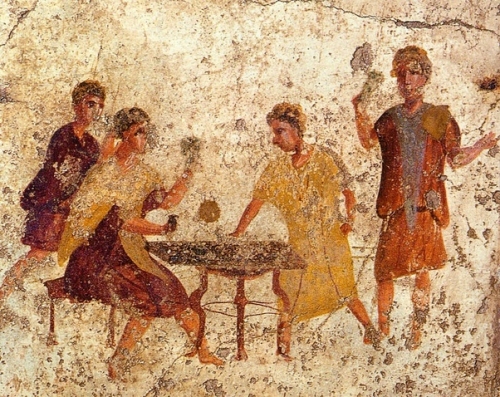
- De grands banquets étaient organisés et le "Princeps Saturnalicius" était élu pour diriger la fête. Même les robes portées changeaient : la toge étaient abandonnée et la synthesis était portée (une robe de maison très décontractée), et le pileus (un chapeau en forme de capuchon) s’utilisait comme coiffe.
"Dans le culte de sa personne et dans son habillement, il était si négligé que ses cheveux étaient toujours coupés en escabeau et, après le voyage en Grèce, lui tombaient même sur la nuque ; de plus, il sortait en public presque toujours sans ceinture et pieds nus, en robe de chambre (synthesis) et avec un mouchoir autour du cou" (Suetonius, La vie de Néron)
Selon une autre tradition, les Saturnales ont été établies par les compagnons d'Hercule qui sont restés en Italie.
Varro faisait remonter plutôt les Saturnales aux Pélasgiens qui s’étaient installés en Italie après en avoir chassé les Siculiens. En tout cas, les fêtes de Saturne sont bien antérieures à la fondation de Rome.
La fête, dont le règlement fut fixé en 217 av. J.-C., durait deux jours au temps de César, quatre jours au temps de Caligula et sept jours au temps de Domitien, car les Romains aimaient prendre des vacances.
Les esclaves erraient dans la ville déguisés et portant le chapeau phrygien (le chapeau de la libération, lorsqu'ils cessaient d'être esclaves et devenaient citoyens romains), s'abandonnant aux réjouissances les plus folles, mais les citoyens romains n'étaient pas moins nombreux dans les rues. Il est clair que pendant la semaine des Saturnales, Rome était en proie au chaos, au bruit et à la confusion, comme le rapportent Sénèque et Pline le Jeune : ce dernier nous raconte que pendant les festivités, il s'est réfugié dans une maison de banlieue, loin du bruit et de la fête.
- 18 décembre - ante diem quintum decimum Kalendas Ianuarias - Saturnalia -
Deuxième jour des festivités de Saturne. Toujours des banquets publics et privés, tout le monde invitait tout le monde, Rome était remplie d’échoppes, de jongleurs, de danseurs et de musiciens, les édicules dédiés aux Dieux étaient ornés de rubans et de fleurs. Ils furent rejoints par la fête d'Éponie, dédiée à Épona et particulièrement chère aux cavaliers, car Epona était la déesse celtique des chevaux, conservatrice et dispensatrice d'abondance et de fertilité. De plus, les 18, 19 et 20 ont été les jours de Mercatus, équivalents des foires et marchés d'aujourd'hui.
- 19 décembre - ante diem quartum decimum Kalendas Ianuarias - Opalia -
Troisième jour des Saturnales, en l'honneur de la déesse Ops ou Opis, ancienne déesse de l'Abondance, protectrice d'une riche récolte, considérée comme l'épouse de Saturne. C’est aussi l’anniversaire de la dédicace du temple du Capitole. La déesse était d'origine sabine, le culte a été introduit à Rome à l'époque de Titus Tatius. On lui demandait des grâces et des vœux se prononçaient.
- 20 décembre - ante diem tertium decimum Kalendas Ianuarias - Sigillaria -
Dans les Saturnales, il y avait aussi la fête des statuettes en terre cuite, appelées sigillaria, cire, pâtes ou figurines en terre cuite, comme offrandes votives et bons vœux. qui s’échangeaient pendant les Saturnales et étaient offertes aux dieux lares ; mais elles étaient aussi offertes au dieu Saturne, car il était le dieu du temps et donc aussi de la mort, rite effectué comme pour détourner celle-ci des siens : l'offrant donnait au dieu le sigillum à la place de sa propre personne.
- 21 décembre - ante diem duodecimum Kalendas Ianuarias - Saturnalia -
- Cinquième jour des festivités de Saturne. Rome était remplie de gens issus de tout l'empire et d'ailleurs, qui venaient voir la merveille de la fête romaine, où l'Urbs donnait le meilleur d'elle-même dans des spectacles sur les places. De la nourriture, des souvenirs, des sealaria, des vêtements, des ornements et des bijoux étaient vendus dans les rues. Des artisans de tous horizons proposaient des articles en cuir, en bois, en terre cuite, en bronze, en laiton, en argent et en succin (ambre jaune de la Baltique).
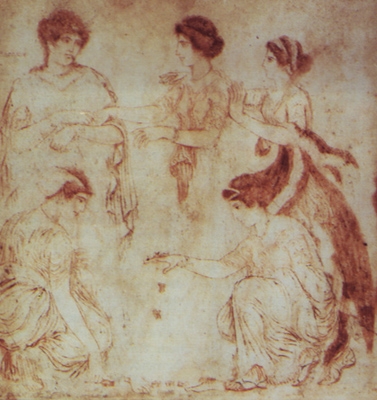
- 22 décembre - ante diem undecimum Kalendas Ianuarias - Saturnalia -
Sixième jour des fêtes en l'honneur de Saturne. Comme la fête concernait tout l'empire, les compagnies de danseurs et de mimes qui se produisaient sur les places se rendaient à Rome depuis d'autres villes. En 84, Martial publie les Xenia (cadeaux pour les invités), ses écrits sur les cadeaux que les Romains s’échangeaient à l'occasion des Saturnales.
- 23 décembre - ante diem decimum Kalendas Ianuarias - Saturnalia -
Septième et dernier jour des festivités en l'honneur de Saturne. Les dieux sont remerciés par une nouvelle procession, les rues grouillent de torches et de braseros, et la journée se passe entre les banquets et les bains décorés de rubans et de guirlandes pour l'occasion. Les festivités s’achèvent au coucher du soleil.
BIBLIOGRAPHIE :
- Aulo Gellio - Noctes Atticae - libro II -
- Macrobio - I Saturnali - a cura di Nino Marinone - Unione Tipografico-Editrice Torinese - Torino - 1967 -
- Ambrogio Teodosio Macrobio - I Saturnali - a cura di Nino Marinone - classici latini - UTET - 1987 -
- G. Frazer - The golden bough - Il ramo d'oro - III - Londra - 1911 -
- G. Dumézil - La religione romana arcaica - Milano - 2001 -
- John F. Donahue - "Towards a Typology of Roman Public Feasting" in Roman Dining: A Special Issue of American Journal of Philology - University Press - 2005 -
00:50 Publié dans Traditions | Lien permanent | Commentaires (0) | Tags : traditions, rome antique, saturnales, fêtes romaines, paganisme, cultes solsticiaux, antiquité romaine |  |
|  del.icio.us |
del.icio.us |  |
|  Digg |
Digg | ![]() Facebook
Facebook
samedi, 12 décembre 2020
Distanciation sociale et fraternité spirituelle

Distanciation sociale et fraternité spirituelle
Un message du Groupe "Heliodromos" (Italie)
A méditer pendant le confinement et l'obligation à la distanciation sociale
Ex: https://www.azionetradizionale.com
Ce qui s'assemble aujourd'hui, artificiellement, jour après jour, sous nos yeux, prend de plus en plus le caractère sans équivoque d'une civilisation mécanique et anti-humaine, fondée sur une forme de barbarie sociale et politique dans laquelle, s'inspirant d'Ortega y Gasset, l'homme d’excellence ("celui qui exige beaucoup de lui-même"), est supplanté par l'homme vulgaire ("celui qui n'exige rien, mais se contente de ce qu'il est, et reste admiré de lui-même"), prêt à sacrifier toute liberté, dont il ne sait que faire, pour prolonger d'un jour seulement sa propre misérable et inutile survie terrestre. Le remplacement radical du paradigme sur lequel reposait l'existence de tout un chacun, il y a seulement quelques mois, est le signe d'un véritable tournant d'époque, qui laisse entrevoir une étape supplémentaire et définitive de l'action anti-traditionnelle, dont René Guénon nous a magistralement fait prendre conscience.
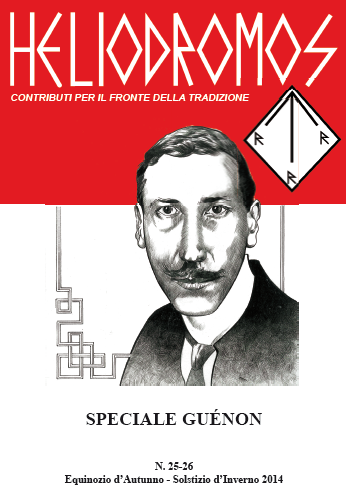 Pour rester dans l'ère moderne, il s'est passé quelque chose de semblable, et tout aussi extrême et définitif, avec l'Humanisme, introduit suite à la Peste noire qui a clos le Moyen-Âge, entraînant la dissolution politique qui a vaincu l'Empire en le remplaçant par les Nations ; la dissolution religieuse et spirituelle marquée par la Réforme protestante ; la dissolution anthropologique, artistique et culturelle représentée par la Renaissance : après cette période, rien n'était plus vraiment comme avant. Jusqu'à ce que, par le truchement des Lumières, la Révolution française achève le travail de sape des siècles précédents et forme la matrice de toutes les tendances subversives et anti-humaines ultérieures.
Pour rester dans l'ère moderne, il s'est passé quelque chose de semblable, et tout aussi extrême et définitif, avec l'Humanisme, introduit suite à la Peste noire qui a clos le Moyen-Âge, entraînant la dissolution politique qui a vaincu l'Empire en le remplaçant par les Nations ; la dissolution religieuse et spirituelle marquée par la Réforme protestante ; la dissolution anthropologique, artistique et culturelle représentée par la Renaissance : après cette période, rien n'était plus vraiment comme avant. Jusqu'à ce que, par le truchement des Lumières, la Révolution française achève le travail de sape des siècles précédents et forme la matrice de toutes les tendances subversives et anti-humaines ultérieures.
La qualification négative croissante (qu'il serait plus correct d'appeler "disqualification") des agents humains est désormais bien visible : ces agents sont devenus les instruments et les porteurs de germes dissolvants, et ont obtenu l'accès au sommet des organes de l'État et des institutions publiques, lesquels sont de plus en plus "défectueux", voués aux vices, à la dépravation et à des perversions plus ou moins cachées. Ce processus involutif avait encore naguère pour vecteurs-accélérateurs l'inadéquation et le manque de qualité croissants de ceux qui étaient censés contrer ces processus, les réduisant à la seule vague concrétisation et à l'organisation de simples actes réactifs. On a donc recours à une attitude passive et perdante, car ceux qui réagissent partent d'une position de faiblesse, ayant déjà pris "gifles et coups", et se retrouvent à se battre sur le terrain choisi par l'adversaire.
Le fait est que les civilisations fondées sur des principes traditionnels, comme l'ont été les civilisations romaine et médiévale dans nos régions du monde, dans lesquelles l'homme a encore joué un rôle actif, devenant en même temps à la fois le récepteur et l’émetteur des influences spirituelles que ces réalités animaient, ont été suivies d'expressions de plus en plus partielles et incomplètes telles que, pour en rester aux étapes subversives mentionnées ci-dessus, la Contre-Réforme de l'Église catholique, le Légitimisme contre-révolutionnaire du XIXe siècle, jusqu'aux Fascismes européens du siècle dernier : les derniers émetteurs du témoin et le flambeau d'un feu toujours moins pur et moins vivant.
En arrivant à l'époque contemporaine et en regardant la farce sanitaire actuelle, tous ceux qui tentent, avec mérite, d'échapper (- avec des nuances et des points de vue différents, pas toujours conciliables les uns avec les autres -) au chœur bêlant du troupeau terrifié par le virus, ne font finalement que "répondre" et "réagir" à la narration officielle du pouvoir pharmaceutique et de ses infâmes serviteurs, en acceptant leurs arguments et leur champ de bataille, à commencer par la bataille de l'information. Peut-être quelqu'un se sentira-t-il encore libre et en pleine possession de ses facultés intellectuelles, simplement parce que le Pouvoir lui permet (pour peu de temps encore, vous verrez !) de se livrer au sarcasme et à l'ironie - comme toujours amplifiés dans les moments de crise et de difficulté - en se moquant des éléments marginaux et périphériques de toute l'orchestration. Se réduisant ainsi à utiliser les mêmes thèmes avec lesquels cette énorme fiction a été construite, en essayant seulement d'en inverser le sens, et d'en expliquer les données et le contenu d'un point de vue partiel ; manquant la vue d'ensemble, qui ne peut venir que de la connaissance des lois cycliques traditionnelles. Avec la circonstance aggravante de tomber dans le syndrome démocratique, qui prétend communiquer la vérité à quiconque, en raison du besoin sentimental de partage unanime et collectif. Alors qu'il devrait être établi depuis longtemps qu'il ne vaut la peine de se dire des choses que parmi ceux qui parlent la même langue.
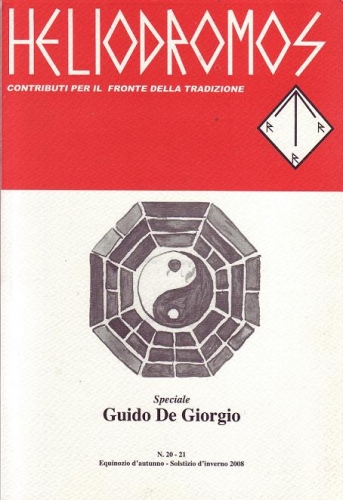 Le désir de sauver tout le monde (même ceux qui n'ont aucun désir d'être sauvés ! ) et le prosélytisme qui en découle, naissent, après tout, du fait que l'on se sent lié à tout le monde, sans distinction ; ignorant par culpabilité - du moins ceux qui ont une formation traditionnelle et anti-moderne - ce qu'Evola affirmait en son temps, dont l'enseignement est très précieux et décisif dans des moments comme le présent qui voit la prévalence de la confusion et de la désorientation, dans une de ses phrases les plus citées : "A partir d'un point donné, plus de sang, plus d'affection, plus de pays, plus de destin humain, on ne peut encore se sentir uni à quelqu'un. Unis, vous ne pouvez vous sentir unis qu'avec ceux qui sont sur le même chemin que vous".
Le désir de sauver tout le monde (même ceux qui n'ont aucun désir d'être sauvés ! ) et le prosélytisme qui en découle, naissent, après tout, du fait que l'on se sent lié à tout le monde, sans distinction ; ignorant par culpabilité - du moins ceux qui ont une formation traditionnelle et anti-moderne - ce qu'Evola affirmait en son temps, dont l'enseignement est très précieux et décisif dans des moments comme le présent qui voit la prévalence de la confusion et de la désorientation, dans une de ses phrases les plus citées : "A partir d'un point donné, plus de sang, plus d'affection, plus de pays, plus de destin humain, on ne peut encore se sentir uni à quelqu'un. Unis, vous ne pouvez vous sentir unis qu'avec ceux qui sont sur le même chemin que vous".
Comme les données traditionnelles nous le montrent, à la fin du cycle actuel de l'humanité, le renversement parodique de tout principe et de toute institution, politique ou religieuse, devra nécessairement se produire, à partir des mêmes castes, sous réserve d'une inévitable "régression" dans leur rôle et leur signification d'origine, qui les conduira à un renversement total, au point qu'ils se retrouveront aux plus hautes fonctions, non seulement ceux qui étaient autrefois les Çûdra, mais aussi les parias et les intouchables, avec lesquels tout contact était interdit dans la civilisation hindoue. Et quel meilleur signe qu'une telle interdiction, que l'introduction parodique et ridicule de la distanciation sanitaire comme nouvelle condition de toute future coexistence humaine et sociale ?
Revenir donc à la phrase d'Evola qui vient d'être mentionnée : "partir d'un point donné" était déjà quelque chose qui, historiquement, avait sa validité objective par rapport aux tournants d'époque qui se sont produits au cours des siècles passés, mais qui prend une actualité définitive avec les événements que nous vivons aujourd'hui. D'autant plus si ce changement s'opère au sein des consciences, où les événements extérieurs ne représentent qu'un reflet de révolutions bien plus profondes que la misérable chronique quotidienne. Parmi les effets involontairement favorables de la mise en place des soins de santé, il faut cependant noter la clarification de la discrimination entre esclaves et opposants, entre les adeptes non critiques et obtus du récit officiel et ceux qui ont une ouverture d'esprit éclairée par la réflexion de la raison, toujours capables de poser des questions. Avec ceux qui portent le masque partout, convaincus qu'ils sauvent leur peau, avec ceux qui se saluent de la façon la plus étrange, en évitant soigneusement les étreintes et les poignées de main (gestes qui sont devenus, qui l'aurait cru, révolutionnaires !), avec ceux qui aseptisent même les pensées, nous ne pouvons rien avoir à partager. Et cela vaut en particulier pour les soi-disant partis, mouvements, cercles et initiatives de la "droite", non moins alignés que d'autres : par commodité, par peur et par manque évident de foi et de cohérence avec ce qui est dit en paroles. Au moins, ils auraient le courage de se saluer romantiquement, plutôt que de se barrer comme des ivrognes !
Ainsi, "plus que par le sang" on peut se sentir uni (face aux décrets ministériels !), compte tenu de la désintégration et des attaques subies contre les liens familiaux et contre tous les descendants généalogiques, privant la société de son unité de base et de l'une de ses plus grandes forces et de sa stabilité. Il en résulte que des liens plus forts avec des personnes extérieures à la famille qu'avec les frères et sœurs naturels eux-mêmes peuvent être établis, lorsqu'une union horizontale et naturaliste est remplacée par une union verticale et spirituelle, en vue de projets communs et d'intérêts supérieurs qui transcendent le profit économique et héréditaire. Et, surtout, "plus que par les affects", étant donné la vacuité actuelle des liens sentimentaux, où l'intérêt personnel et l'égoïsme prévalent, au détriment du dévouement amoureux et de l'altruisme désintéressé, parce que l'amour authentique n'est pas quelque chose de froid, d'abstrait, d'indifférencié, de calculé et visant un rendement matériel. Il est vivant, chaleureux, intense et fortifiant. Par conséquent, pas même "plus que par la patrie", dégradée au rang de « comité de la nation et des entreprises », puisque le rôle du Père, dont elle a tiré son nom et sa signification, avec l'imposition de ses limites (au consumérisme en général et aux "droits" également marqués par les idéologèmes consuméristes) et de ses règles, a disparu, n'est plus fonctionnelle dans la société capitaliste, avec une prédisposition naturelle à l'audace, au risque et au danger, à la virilité et à la valeur, considérée comme un gaspillage inutile par la société dans laquelle les trois Mères (Suspiriorum, Tenebrarum et Lacrimarum) dominent ; ainsi que "plus que par un destin humain", surtout si cela a réduit la grande majorité des individus à des poulets d'élevage grossiers et gênants.
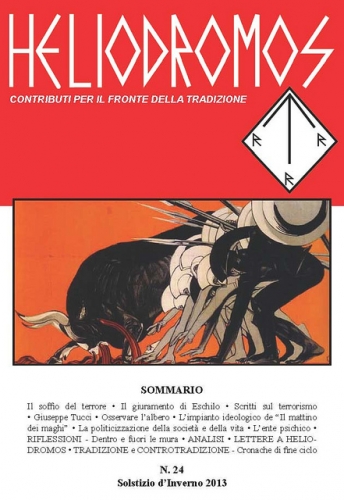 "Unis, vous ne pouvez vous sentir qu'avec ceux qui sont sur le même chemin que vous", alors vous devenez la bannière et la devise qui doivent distinguer le militant du Front de la Tradition, à qui est confiée la tâche de témoigner avec courage et loyauté à l'Esprit (en tant que Réalité suprême, transcendante, absolue et illimitée), et de rester fidèle aux devoirs et responsabilités qui en découlent, de manière impersonnelle et sans en regarder les fruits. Pour quitter le troupeau destiné à l'abattoir inévitable et devenir un Groupe actif, conscient, formé et préparé, sans tergiversations ni références croisées, avant que "le temps n'arrive", prêt à faire sa part et à prendre la place de chacun, il est indispensable de prendre et de parcourir le Chemin amer ("pour la longueur du voyage et la fatigue de la route", selon l'ésotérisme islamique) qui conduit individuellement à la reconstruction intérieure, et en accord avec l'application d'une stratégie communautaire visant à la constitution, également physique, d'une forteresse et d'une république d'amis du sacré et d'hommes de bonne volonté, construite sous la bannière de la paix, de la sérénité et de la justice, dans la tempête déchainée du choc final.
"Unis, vous ne pouvez vous sentir qu'avec ceux qui sont sur le même chemin que vous", alors vous devenez la bannière et la devise qui doivent distinguer le militant du Front de la Tradition, à qui est confiée la tâche de témoigner avec courage et loyauté à l'Esprit (en tant que Réalité suprême, transcendante, absolue et illimitée), et de rester fidèle aux devoirs et responsabilités qui en découlent, de manière impersonnelle et sans en regarder les fruits. Pour quitter le troupeau destiné à l'abattoir inévitable et devenir un Groupe actif, conscient, formé et préparé, sans tergiversations ni références croisées, avant que "le temps n'arrive", prêt à faire sa part et à prendre la place de chacun, il est indispensable de prendre et de parcourir le Chemin amer ("pour la longueur du voyage et la fatigue de la route", selon l'ésotérisme islamique) qui conduit individuellement à la reconstruction intérieure, et en accord avec l'application d'une stratégie communautaire visant à la constitution, également physique, d'une forteresse et d'une république d'amis du sacré et d'hommes de bonne volonté, construite sous la bannière de la paix, de la sérénité et de la justice, dans la tempête déchainée du choc final.
Pour ce faire et pour donner une perspective large et globale à l'action à entreprendre, il faut examiner attentivement les possibilités concrètes d'intervention dans le monde extérieur, en supprimant tout romantisme et toute physiologie du beau geste (vieilles maladies de notre mouvance !), en visant exclusivement ce qui peut réellement servir, surtout "pour plus tard". Cela signifie que nous devons continuer à faire avec cohérence ce qui a été fait jusqu'à présent, en partant d'une analyse de la réalité effectuée, en son temps, à la lumière de la doctrine traditionnelle ; en silence, avec le détachement nécessaire et le renoncement indispensable pour ne pas être ébloui par les miroirs aux alouettes que le monde moderne nous présente, avec ses superstitions technologiques et informatiques, fantasmagoriques et déviées.
Au début de notre activité extérieure en tant que groupe Heliodromos, en imprimant les premiers numéros du magazine avec la ronéo, après un engagement minutieux et méticuleux avec la machine à écrire, il est venu à l'esprit des plus jeunes et des plus "novateurs" d'entre nous d'acheter une machine à écrire électrique, pour faciliter et accélérer le travail de composition ; nous nous sommes heurtés à une résistance inexplicable de la part de Gaetano, qui n'était pas du tout satisfait de toute cette dépendance technologique. Ce refus s'est ensuite traduit par l'utilisation immodérée des téléphones portables, qui commençaient discrètement à s'imposer, et des premières possibilités offertes par l'internet. La méfiance de Gaetano est née, d'une part, de raisons spirituelles bien fondées (les conforts ne sont pas toujours conciliables avec le travail intérieur et l'ascèse, bien au contraire !), et d'autre part, d'un souci prescient de devenir les victimes d'un contrôle de plus en plus intrusif, dont nous ne pouvons comprendre l'ampleur qu'aujourd'hui (avec nos échanges continus de messages sur les médias sociaux et nos rencontres très confortables sur le zoom !) Et la découverte que les mafiosi fugitifs évitaient soigneusement l'utilisation du téléphone, recourant à des "pizzini" apparemment anachroniques, a considérablement renforcé sa position.
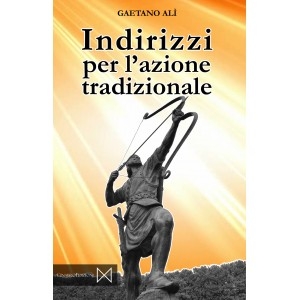 Aujourd'hui, que le dégoût pour les virologistes, les journalistes et les dirigeants qui pontifient quotidiennement en direct à la télévision (répugnants serviteurs, à qui l'on confie le sale boulot pour l'instauration de la dictature de la santé), vous donne envie de leur taper dessus et de rentrer chez vous un par un - en infligeant une "saine punition" à ceux qui contribuent à violer les lois divines et naturelles -, les paroles d'Evola, adressées en son temps à l'anarchiste de droite, reviennent plus utiles que jamais : "Bien sûr, si l'on pouvait aujourd'hui organiser une sorte de Sainte Vehme opérationnelle, de manière à maintenir les principaux auteurs de la subversion contemporaine dans un état constant d'insécurité physique, ce serait une très bonne chose. Mais ce n'est pas quelque chose qu'un jeune (et dans le monde d'aujourd'hui, pas même un État, ndlr) peut organiser, et d'autre part le système de défense de la société actuelle est trop bien construit pour que de telles initiatives ne soient pas étouffées dans l'œuf et ne soient pas payées trop cher". Il s'agirait, en fait, d'une explosion sentimentale infantile et stérile (passivement réactive, comme expliqué ci-dessus) qui, comme nous l'a appris l’ère du terrorisme intérieur du siècle dernier et du terrorisme international d'aujourd'hui, ne ferait que renforcer le pouvoir de l'adversaire, lui fournissant l'alibi pour de nouvelles restrictions répressives. Même si la constitution d'une unité opérationnelle "Barbalbero", qui se consacrerait à abattre, par exemple, dix antennes 5G pour chaque arbre déraciné, ne serait pas une mauvaise idée !
Aujourd'hui, que le dégoût pour les virologistes, les journalistes et les dirigeants qui pontifient quotidiennement en direct à la télévision (répugnants serviteurs, à qui l'on confie le sale boulot pour l'instauration de la dictature de la santé), vous donne envie de leur taper dessus et de rentrer chez vous un par un - en infligeant une "saine punition" à ceux qui contribuent à violer les lois divines et naturelles -, les paroles d'Evola, adressées en son temps à l'anarchiste de droite, reviennent plus utiles que jamais : "Bien sûr, si l'on pouvait aujourd'hui organiser une sorte de Sainte Vehme opérationnelle, de manière à maintenir les principaux auteurs de la subversion contemporaine dans un état constant d'insécurité physique, ce serait une très bonne chose. Mais ce n'est pas quelque chose qu'un jeune (et dans le monde d'aujourd'hui, pas même un État, ndlr) peut organiser, et d'autre part le système de défense de la société actuelle est trop bien construit pour que de telles initiatives ne soient pas étouffées dans l'œuf et ne soient pas payées trop cher". Il s'agirait, en fait, d'une explosion sentimentale infantile et stérile (passivement réactive, comme expliqué ci-dessus) qui, comme nous l'a appris l’ère du terrorisme intérieur du siècle dernier et du terrorisme international d'aujourd'hui, ne ferait que renforcer le pouvoir de l'adversaire, lui fournissant l'alibi pour de nouvelles restrictions répressives. Même si la constitution d'une unité opérationnelle "Barbalbero", qui se consacrerait à abattre, par exemple, dix antennes 5G pour chaque arbre déraciné, ne serait pas une mauvaise idée !
Mais cela ne fera pas obstacle au nouvel ordre mondial. Si le système actuel s'effondre, comme il est juste et naturel de l’imaginer, c'est plutôt en raison de son extrême fragilité et de son interdépendance informatique. Probablement, au moment où l'extension de son pouvoir de contrôle et de domination sera sur le point de devenir absolue et étendue à l'échelle planétaire, un petit échec ou une incursion souhaitable des pirates du web héroïques suffira à bloquer l'engrenage et à précipiter ce semblant de domination. Un peu comme ce qui arrive à Sauron dans la finale du Seigneur des Anneaux, qui est sur le point de prendre le dessus et qui est vu comme annulant à tout moment son "réseau" de contrôle et de domination, avec la simple destruction d'un objet insignifiant comme peut être un anneau. Un grain de sable qui bloque tout le mécanisme, ou, si vous préférez, le triomphe des fabricants de "couvercles" contre l'Illusion éternelle, des fabricants de "pots".
Heliodromos, n. 25-26, Equinoxe d'automne - Solstice d'hiver 2014
(pour plus d'informations : libreria@raido.it)
13:28 Publié dans Actualité, Traditions | Lien permanent | Commentaires (0) | Tags : actualité, distanciation sociale, fraternité spirituelle, tradition, traditionalisme |  |
|  del.icio.us |
del.icio.us |  |
|  Digg |
Digg | ![]() Facebook
Facebook
vendredi, 11 décembre 2020
Julius Evola | The Sufi Of Rome
00:24 Publié dans Traditions | Lien permanent | Commentaires (0) | Tags : julius evola, tradition, traditionalisme, soufisme |  |
|  del.icio.us |
del.icio.us |  |
|  Digg |
Digg | ![]() Facebook
Facebook
jeudi, 10 décembre 2020
La fin d'un monde : quand Evola a anticipé Orwell et Huxley
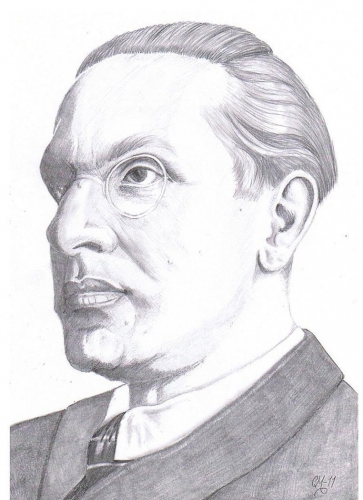
La fin d'un monde : quand Evola a anticipé Orwell et Huxley
Andrea Scarabelli
Ex : https://blog.ilgiornale.it/scarabelli
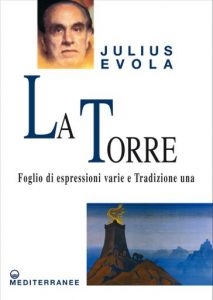 La nouvelle édition de La Torre, la revue mythique dirigée par Julius Evola en 1930, vient d'être publiée par la maison d’édition Mediterranee ; c’est une version critique, remise à jour, comprenant des notes, des bibliographies et des analyses approfondies. En plus d'être un document historique comme il y en a peu d'autres, cette réédition témoigne d'une approche "métapolitique" et "spirituelle", qui a tenté d'orienter la politique de l'époque dans un sens différent de celui pris dans les années ultérieures. À l'occasion de cette nouvelle édition, nous rapportons, avec l'aimable autorisation de l'éditeur, une note signée par Evola dans le quatrième numéro de la revue, le 16 mars 1930, dans la rubrique qu'il a dirigée, la rubrique L'Arco e la Clava. Ici, le philosophe répond clairement à tous ces périodiques (La Volontà d'Italia, Roma Fascista, L'Italia Letteraria, L'Ora, etc.) qui l'accusent de "catastrophisme", car, comme on le sait, il s’était penché sur le thème de la fin des civilisations. Dans cette réponse, Evola anticipe non seulement des analyses plus connues aujourd’hui de par le monde, contenues par exemple dans des textes tels que Le meilleur des mondes de Huxley (1932), La dialectique des Lumières d’Adorno de Horkheimer (1947), le 1984 d’Orwell (1949) et L'homme unidimensionnel de Marcuse (1964).De surcroît, iloffre un portrait impitoyable, une analyse quasi chirurgicale, de notre monde. Dans cette singulière variation sur le thème de la "fin du monde" (dont le spectre erre encore dans le débat public actuel), Evola imagine néanmoins une calamité bien différente de celles, littéraires et dystopiques, auxquelles nous nous sommes habitués, pour finir par décrire en fait... notre contemporanéité, avec ses tics et ses tabous, avec tous ses masques et ses acteurs que le lecteur - nous en sommes sûrs - n'aura pas de mal à reconnaître. C'est aussi parce qu'il n'y a souvent pas besoin de catastrophes naturelles - ou de pandémies, pourrait-on ajouter, pour basculer dans la dystopie. Une civilisation peut aussi mourir d'une mort naturelle. C'est peut-être le cas de la nôtre.
La nouvelle édition de La Torre, la revue mythique dirigée par Julius Evola en 1930, vient d'être publiée par la maison d’édition Mediterranee ; c’est une version critique, remise à jour, comprenant des notes, des bibliographies et des analyses approfondies. En plus d'être un document historique comme il y en a peu d'autres, cette réédition témoigne d'une approche "métapolitique" et "spirituelle", qui a tenté d'orienter la politique de l'époque dans un sens différent de celui pris dans les années ultérieures. À l'occasion de cette nouvelle édition, nous rapportons, avec l'aimable autorisation de l'éditeur, une note signée par Evola dans le quatrième numéro de la revue, le 16 mars 1930, dans la rubrique qu'il a dirigée, la rubrique L'Arco e la Clava. Ici, le philosophe répond clairement à tous ces périodiques (La Volontà d'Italia, Roma Fascista, L'Italia Letteraria, L'Ora, etc.) qui l'accusent de "catastrophisme", car, comme on le sait, il s’était penché sur le thème de la fin des civilisations. Dans cette réponse, Evola anticipe non seulement des analyses plus connues aujourd’hui de par le monde, contenues par exemple dans des textes tels que Le meilleur des mondes de Huxley (1932), La dialectique des Lumières d’Adorno de Horkheimer (1947), le 1984 d’Orwell (1949) et L'homme unidimensionnel de Marcuse (1964).De surcroît, iloffre un portrait impitoyable, une analyse quasi chirurgicale, de notre monde. Dans cette singulière variation sur le thème de la "fin du monde" (dont le spectre erre encore dans le débat public actuel), Evola imagine néanmoins une calamité bien différente de celles, littéraires et dystopiques, auxquelles nous nous sommes habitués, pour finir par décrire en fait... notre contemporanéité, avec ses tics et ses tabous, avec tous ses masques et ses acteurs que le lecteur - nous en sommes sûrs - n'aura pas de mal à reconnaître. C'est aussi parce qu'il n'y a souvent pas besoin de catastrophes naturelles - ou de pandémies, pourrait-on ajouter, pour basculer dans la dystopie. Une civilisation peut aussi mourir d'une mort naturelle. C'est peut-être le cas de la nôtre.
Andrea Scarabelli.
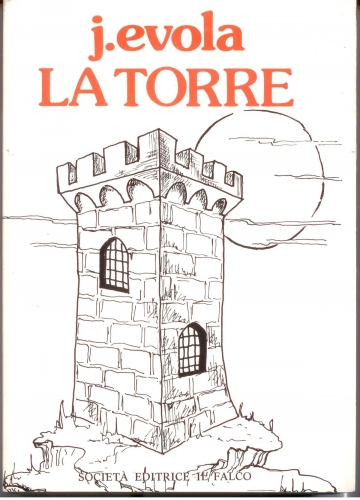
Texte de Julius Evola
Le monde occidental se dirige vers sa "fin". Mais c'est précisément ce que signifie "fin" qui doit être compris ! Nos points de référence ne sont pas du tout ceux qui ont cours actuellement. Nous ne prophétisons pas, nous démontrons - par l'observation de personnages et de processus précis de l'histoire et de la culture - le déclin d'une civilisation, et ce même fait, aux yeux de la plupart des gens, pourrait prendre un aspect très différent et pas du tout alarmant.
Expliquons cela à l'aide d'un exemple. Nous ne pensons pas du tout que la fin du monde occidental devrait nécessairement avoir cet aspect chorégraphique et catastrophique auquel la plupart des gens pensent immédiatement. Il ne s'agira pas nécessairement de cataclysmes, ni même de ces nouvelles guerres mondiales, sur les horreurs desquelles on a déjà maintes fois disserté et sur les résultats d’une éventuelle extermination de la race humaine ; non, plus simplement, de nombreuses personnes bien vivantes nous montrent déjà ce déclin, de manière lugubre. Au contraire, une guerre... un autre bon mais radical écrasement définitif - que peuvent espérer de plus ceux qui espèrent encore?
On voit encore plus noir. Voici, par exemple, l'une des formes sous lesquelles, entre autres, nous pourrions aussi dépeindre la "fin du monde".
Plus de guerres. La fraternité universelle. Nivellement total. Le seul mot d'ordre : obéir - incapacité, de devenir « organique » vu la contre-éducation des générations successives, alors qu’il faudrait faire tout sauf obéir. Pas de dirigeants. La toute-puissance de la "société". Les hommes, des moyens d'action sur les choses. L'organisation, l'industrialisation, le mécanisme, le pouvoir et le bien-être physique et matériel atteindront des sommets inconcevables et vertigineux. Soigneusement libérés scientifiquement de l'ego et de l'esprit, les hommes deviendront très sains, sportifs, travailleurs. Parties impersonnelles de l'immense agglomération sociale, rien, après tout, ne les distinguera les uns des autres. Leur pensée, leur façon de ressentir et de juger seront absolument collectives.
Avec les autres, même la différence morale entre les sexes disparaîtra, et il se peut aussi que le végétarisme fasse partie des habitudes rationnellement acquises de ce monde, se justifiant sur la similitude évidente des nouvelles générations avec les animaux domestiques (les animaux sauvages n'étant alors plus autorisés à exister que dans quelques jardins zoologiques). Les dernières prisons enfermeront dans l'isolement le plus terrifiant les derniers agresseurs de l'humanité : les penseurs, les témoins de la spiritualité, les dangereux maniaques de l'héroïsme et de l'orgueil guerrier. Les derniers ascètes vont s'éteindre un à un sur les sommets ou au milieu des déserts. Et la messe se célébrera par la bouche de poètes officiels et autorisés, qui parleront des valeurs civiles et chanteront la religion du service social. À ce moment-là, une grande aube se lèvera. L'humanité sera véritablement régénérée, et elle ne conservera même plus le souvenir des temps passés jugés désormais « barbares ».
Maintenant : qui vous permettrait d'appeler "fin" cette fin ? Pour voir, avec nous, l'effondrement total, la chute finale ? Seriez-vous capable de concevoir un mythe plus splendide, un avenir plus radieux pour l'"évolution" ?
17:34 Publié dans Philosophie, Traditions | Lien permanent | Commentaires (0) | Tags : julius evola, evola, italie, dystopie, philosophie, tradition, traditionalisme, traditionalisme révolutionnaire |  |
|  del.icio.us |
del.icio.us |  |
|  Digg |
Digg | ![]() Facebook
Facebook



